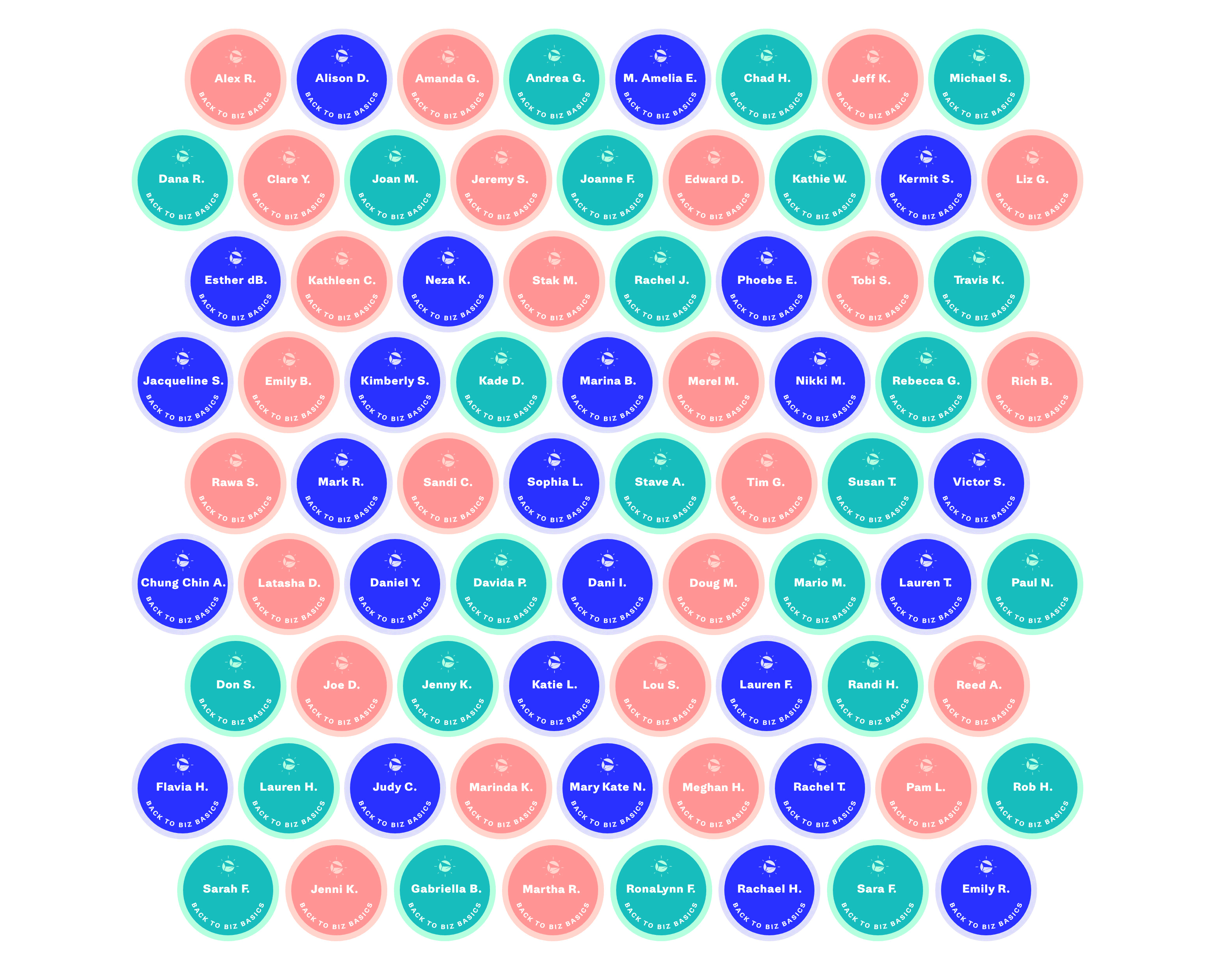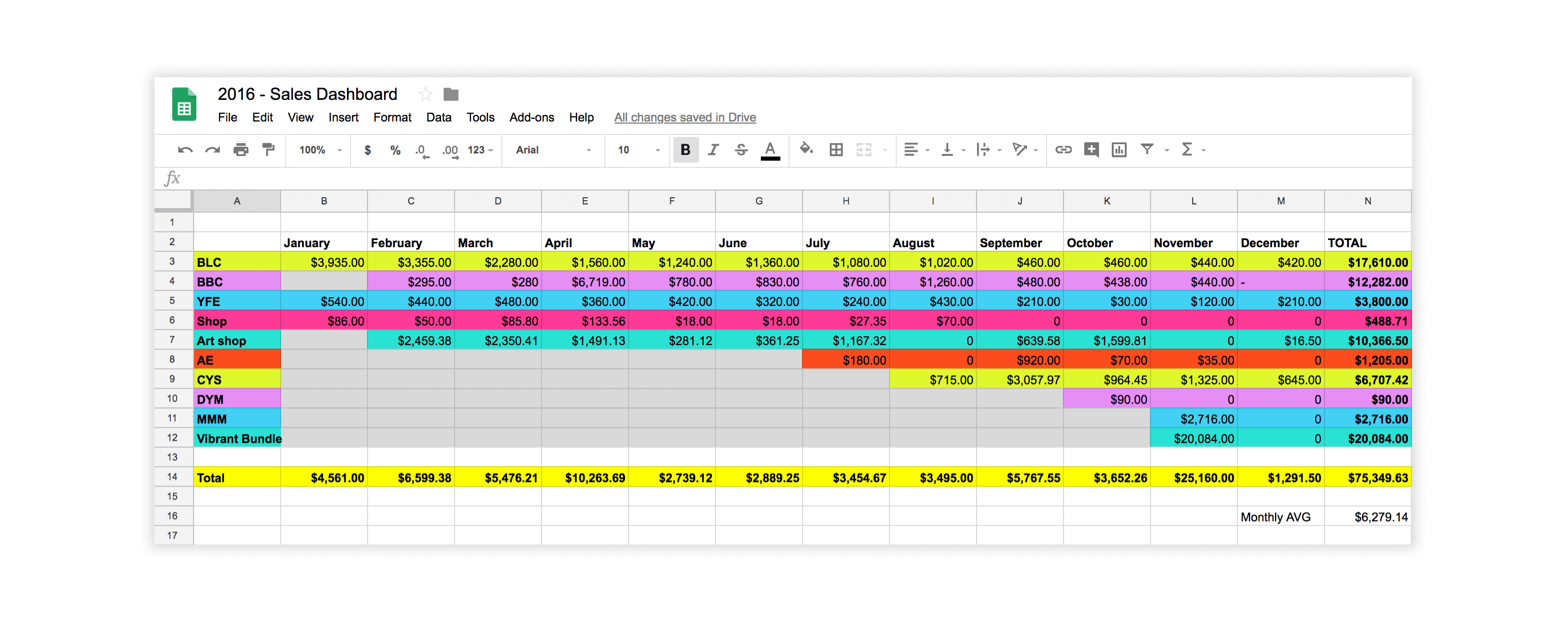Get monthly coaching and support to FINALLY gain momentum in your business without burning out in the process. 🦄 Learn more about WAIM Unlimited.




Since starting the Wandering Aimfully, even back in the days when it was called BuyMyFuture/BuyOurFuture, we’ve had so many people reach out asking for advice about how to reach their business and life goals. While we’ve offered individualized advice to many over the years, we have noticed some overall themes that pop up time and time again.
Questions like:
Our remedies for these common challenges most often boil down to the most foundational parts of running a business. Namely…
So many of these things are things you already know—they’re things you feel should be in place for your life and business already—yet sometimes the simplest things are the hardest to pay attention to.
Sometimes the simplest things are the hardest to pay attention to.
Let’s face it: Finances are scary, productivity isn’t sexy, and choosing one focus is uncomfortable, especially for multi-passionate and creative people like those in the Wandering Aimfully community.
But believe us, getting clear on these things is the only way to make sure your business is built on a solid, sustainable foundation going forward.
We want you to use this as motivation to finally get these foundational pieces in the right place to gain more clarity and focus.
So, it’s back to basics we go!
Here’s an outline of what we’ll work through together:
Alright, with the WAIM community awesomeness out of the way, let’s get these business basics ducks in a row! To get this party started, it’s onto Phase 1: Know Your Numbers!
We believe there’s a lot more to personal success and happiness than just money. However, as with everything, there has to be a balance.
More money in your business can bring you freedom and flexibility in your life, which are things that can dramatically increase your happiness. Yet, it’s staggering to us how many people we give advice to that don’t have a system for tracking their finances—personally or professionally.
If you’re reading this right now with this face on 😬 because you know you’re one of those people, that’s okay! This program is your chance to change that!
We’re going to break down your numbers into two categories: Revenue and Expenses.
**It’s important to note, none of the methods we’re taking you through are meant to be 100% accurate to the penny. This is not an accounting class. (Thank goodness.) Instead, this is about common sense math and getting ballpark figures so you can make better decisions in your life and business. So try not to obsess over the small stuff and get caught in the weeds with the following exercises. Instead, keep your eye on the big picture and the general aim, which is to get an idea of how money is coming in, how much is going out, and how you can maximize the difference between those two.**
Here’s the first rule of business basics: You need to know how much money is coming into your business by revenue stream.
It’s not enough to see total numbers in your Stripe or Gumroad or PayPal or Shopify accounts, etc. Knowing what percentage of your overall business revenue is attributed to which projects/products/offerings is crucial for making shrewd decisions on what to put your focus and energy toward at any given time.
For example, if you’re spending 80% of your time on a revenue stream that’s only making you 20% of your income and you’re not seeing results, that’s helpful information so you can shift your focus to a product or project that’s going to get you a bigger bang for your buck.
Which brings us to your first action step:
Determine the monthly revenue for each of your revenue streams throughout the current year.
To do this, you can use a spreadsheet tool like Excel or Google Sheets, you can use our favorite database tool Airtable, or heck you can just write it down with pen and paper! Figure out the right process for you, but be sure to keep in mind your chosen process should be something you can continue to update going forward.
If you’re having trouble knowing where/how to start, fear not! We have some example spreadsheet templates you can use based on systems we’ve created for ourselves over the years (along with step-by-step details on how to use each below):
Step 1: Click on the link to the template and hit File > Make a copy… (this will allow you to edit the template.)

Step 2: Download your sales data (in CSV format) from your payment processors one month at a time. Here’s an example using data from Stripe. Under the Payments area, set your filter parameters and Export your data.

Step 3: Import your CSV into your Sales Dashboard spreadsheet as a new tab/sheet by going to File > Import… You can import as a new tab or you can replace the “January 2018” tab in the template.

Step 4: Sort your transactions so you can group by product or revenue stream. For example, in my case I sort by the “description” column because that would group transactions for the same course together. (To do this, go to Data > Sort Range…, make sure “Data has header row” is selected and choose the column to sort by.)


Step 5: Now that all your transactions for the same product are grouped together, I find that it’s helpful to color code each product. For example, in this image I highlighted Acrylic Explorations online course in green, Better Lettering Course in light coral, and Your First E-Course in medium coral. Then, insert a row at the bottom of each product section and sum up the revenue total for that product. (I find it helpful to highlight all these subtotals in a bright color like yellow.).

Once you’ve summed the subtotal for each product, you will likely also want to add up those subtotals to get your overall sales for the month

Step 6: Add your subtotals to the main yearly dashboard tab. (Tip: If you click into a cell and type “=” you can click over to your monthly sales data tab to select the cell with the subtotal for your product for that month OR you can just type the value in, you choose!)

Repeat this for every month. This should allow you to see on the Sales Dashboard tab about how much each of your products brought in each month of the year thus far. Here’s a look at my former business, Made Vibrant, and my own sales dashboard from 2016!
Here’s a walkthrough video just for you on exactly how to use this Sales Dashboard template step-by-step:
Step 1: Click on the link to the template and hit File > Make a copy… (this will allow you to edit the template.)
Step 2: Begin updating the spreadsheet with your client projects. List each client project in the top “Client” section. For each client row, you can color in the corresponding cells for the amount of weeks you spent working on the project. This method is especially helpful on an ongoing basis so you can see how many projects you’re working on at one time and your cashflow of when to expect each invoice coming in.
![]()
Step 3: Input each of your client invoices, entering the totals in the row of the corresponding client and the column of the corresponding week.
![]()
Step 4: The sheet should use formulas to automatically add up the invoice totals for each month from each client so you can see how much you made in total client/project income for each month.
![]()
Step 5: If you also have digital products or other income in addition to your client work, you can use the “Product” section in the bottom section of the spreadsheet to input those monthly totals.
![]()
Once you have all your various income and projects inputted, you should be able to see how much you’ve made by month, by project/product, and what percentage of your income has come from client work vs. products.
![]()
Here’s a walkthrough video just for you on exactly how to use this Income by Projects template step-by-step:
Step 1: Click this link to view the template Airtable base.
Step 2: Click “Copy base” in the top right corner. If you’re already an Airtable user, sign in to see your copied base. If you’re not, sign up! (You can also use our Airtable referral code if you want, we get a $10 kickback if you decide you like it and sign up!) This will now allow you to take our template and make your own edits.

Step 3: We believe Airtable is so versatile and flexible that you can use it for both client revenue and product revenue. But first let’s start by adding your client revenue. You’ll want to do that under the “All Payments” tab. Create a new row or “record” (as Airtable calls them) for each invoice or payment you’ve collected this year. Fill out the date of the invoice, description, amount, along with the name of the client underneath the “Revenue Stream” column. (You can just type the client name and hit enter which will create a new client from the dropdown meaning you will be able to attribute any additional invoices/rows to the same client.)
![]()
Now here’s the cool part. The way we have the Airtable setup, there’s also a “Monthly Summary” tab which aggregates all the revenue for a given month. However, we need to tell that summary tab which records (rows) to add up under each month. The next step is how we do that!
Step 4: For each client invoice record, copy the client name under the “Revenue Stream” column and paste it in the “Log” column that corresponds to the month it was paid.
![]()
These log columns are linked to the Monthly Summary tab, so by doing this step, you’re effectively telling Airtable to attribute that amount for that particular client under that particular month. Once you paste the client name under the appropriate log, the amount pops up in the Monthly Summary tab. Watch it in action:

Notice that because my third invoice was paid in February, I pasted the name of that client under the “February Log” column so it would show up in the February column over on the Monthly Summary.
Do this for every client invoice record, and then under the Monthly Summary tab, you can find your monthly totals in these summations at the bottom of your view.
![]()
The base also has a Total column that adds up the invoices for one client across every month. This allows you to see how much money total each client brought in for the whole year, and then the summation is how you know how much you made in TOTAL across the year.
![]()
Step 5: Download your sales data from your payment processor one month at a time. In this example, I’m filtering my payments in Stripe to export payments made in January that were successful.

Step 6: Import the raw data from your CSV into a new tab on your Airtable. Click the + button and select “Import a spreadsheet.”
![]()
Step 7: Now, format your raw data! The import shows us the messy raw data of our product sales, with each row showing one transaction, but we need this data formatted to match perfectly with our “All Payments” tab setup.
To do this, we’ll need the first three columns to be Date, Description, and Amount…in that order.
*One important thing to note about Airtable: the first column is your Primary Field and is locked, meaning you can’t just drag and drop to rearrange like you can the other columns.
If your primary column is not your transaction date (mine is actually my Description in the example below), you’ll first want to copy that column, add a new column, and then paste that data like I did here. Then you’ll copy your date data and paste that over the primary column. Finally, just drag and drop the amount column so you’re left with the correct order Date, Description, Amount. If that was confusing, see it in action here:
![]()
Now you’ll also want to select the correct Field Types for the Date and Currency columns. To do that, double-click on the column header and select each corresponding field type: Date and Currency.
![]()
Yay! Our data is now correctly formatted.
Step 8: Now, copy/paste your first three columns of correctly formatted sales data into the All Payments tab.
![]()
As a reminder, each record or row represents a payment made to your business. So where in the context of clients each row was a paid invoice, now in the context of products, each row is a sales transactions.
Now we need to assign a revenue stream, but to make that easy, let’s group our transactions so that transactions from the same product are grouped together.
Step 9: Sort all your payments by “Description.” Choose Sort at the top of your tab, then from the dropdown select sort by “Description” and hit Apply.
![]()
This basically alphabetizes your transactions by description, which allows us to easy fill in the Revenue Stream column with the product name.
Step 10: Fill in the Revenue Stream column for each transaction with the product name. (You should be able to tell based on the Description text.) You only need to type it once, then you can drag the bottom right corner down to auto fill the rest of the rows for that product.
![]()
Step 11: Now we need to “log” each sale in the correct month so it will rollup in our Monthly Summary tab. As you remember from the steps above, just copy the Revenue Stream column and paste in the correct “Log” column. If you exported your sales data one month at a time, this will make things especially easy because you can just select every cell in the Revenue Stream column that corresponds to a January transaction and paste it in the January Log column.
![]()
Here’s a walkthrough video just for you on exactly how to use this Revenue Tracker Airtable Base step-by-step:
Hopefully, by now you have an idea of how much money your business efforts are bringing in and exactly how much each of your clients/revenue streams/products are contributing to your bottom line. But money coming in is only one part of the equation. We also need to understand how much money is going OUT.
That doesn’t just go for your business, that goes for your life as well.
This is where tracking your expenses and categorizing them comes in handy.
In our experience, so many people avoid looking at their spending habits because of the shame they feel about how much money they spend. Whether it’s because you’re in debt, or you’re making less than you want to be making, you might be avoiding your bank accounts to avoid these kinds of feelings.
But, the important thing to realize is that ignoring your finances doesn’t make them go away. The only way to stop that cycle of shame is to confront your habits and make changes to start spending smarter.
This was one of the very first things we did when we were trying to claw ourselves out of debt, and it was a crucial step for us in taking back control of our finances.
Not to mention, for every dollar less you spend in your life and business, that’s one more dollar of profit you get to keep and save or pay off debt with.
Track and categorize your expenses for the past three months using our ETAC exercise.
What’s ETAC you ask? ETAC stands for Expense Tracking And Categorization, an exercise we developed after being dissatisfied with the budgeting software we experimented with out there. We wanted a completely custom way to track our expenses and group them into categories, so we created our own method. (Jason also loves that the acronym sounds like the word attack, which is appropriate since we used this method to attack our mountain of debt.)
Just like in the revenue section, we’ll walk you through how to categorize your expenses using both Google Sheets and Airtable.
Step 0: Make a copy of the Expense Tracking and Categorization (ETAC) Google Sheets for yourself (File > Make a copy).
Step 1: Download the data from all your accounts and credit cards for the past three FULL months as CSVs. (CSVs might also be titled “comma delimited tabs” in your account download options.)
Step 2: Import your CSVs as individual tabs into the ETAC spreadsheet. (To do this, go to File > Import > Upload your CSV and select “Insert new sheet” under the import options)
![]()
Step 3: Format your data so it’s all uniform. Make sure you have three columns in this order: Date, description, and then amount. Be sure to format the date column as a date and format the amount column as a currency.
NOTE: I like to keep all expenses as negative numbers. Make sure it’s consistently negative OR positive across every debit or credit account you have because if not, your transactions may cancel each other out giving you an inaccurate total. Whether it was paid for on a credit card or with a debit card, if it was an expense (money going out) I make sure it’s formatted as a negative number.
![]()
Also, delete any transfers or credit card payments. We’re just looking for how much money went out the door, not how much was moved around between accounts. It’s REALLY important you remove these across every tab or else, again, your totals will cancel out and be substantially off.
![]()
Step 4: Once the data in all of your tabs is formatted uniformly, copy/paste each list of transactions into one sheet, the sheet in this spreadsheet labeled “All Transactions.”
![]()
Step 5: When every transaction has been pasted over to the All Transactions tab, sort by date and then fill out the appropriate “Month” column.
(This will make it easier to filter your data and see transactions by month.)
![]()
![]()
Step 6: Once months have been applied, go through every transaction line by line and assign a category in the category column.
You can use the category names already listed out on the Monthly Comparison sheet OR you can create your own.
![]()
Step 7: Now it’s time to add up your monthly totals by category and add to the Monthly Comparison tab. To get all the transactions in a certain month in a certain category, first Filter by one month, and then sort by category.
To do this, go to Data > Create a filter… and select the down arrow on the month column to check off which month you want to view at a given time. We recommend only viewing one month at a time when you’re adding up your category totals. Once you have just one month’s transactions in your view, then select the down arrow on the category column and hit Sort.
![]()
This will show you transactions in the same month AND group transactions in the same category together. This will make it easier to sum your totals over on the monthly comparison sheet.
Step 8: Now that you have transactions for one month only, grouped by category, you can head over to the Monthly Comparison sheet, and use the SUM formula to add up the total for each category within that month.
![]()
![]()
Also notice this will start to adjust your monthly expense totals, your three-month average, and your category average.
You can add more categories or more months to your Monthly Comparison tab, just be sure that you update the total formulas so they include those.
Step 9: Repeat these steps until you have the total amount spent for every category and every month.
Here’s a walkthrough video just for you on exactly how to use this ETAC Google Sheets template step-by-step:
Step 0: Make sure you’re viewing the Expense Tracking and Categorization (ETAC) using Airtable.
Step 1: Download the data from all your accounts and credit cards for the past three FULL months as CSVs. (CSVs might also be titled “comma delimited tabs” in your account download options)
Step 2: Import your CSVs as individual tabs into the ETAC Airtable Base. (To do this, click on the + icon by the tabs and select “Import a spreadsheet”).
![]()
Step 3: Now we need to format your transaction data so it’s all uniform. You want to have three columns in this order: Date, description, then amount.
Be sure to double click on the date column and make the field type “Date” and double-click the amount column to make the field type “Currency.”
![]()
NOTE: I like to keep all expenses as negative numbers. Make sure it’s consistently negative OR positive across every debit or credit account you have because if not, your transactions may cancel each other out giving you an inaccurate total. Whether it was paid for on a credit card or with a debit card, if it was an expense (money going out) I make sure it’s formatted as a negative number.
Also, delete any transfers or credit card payments. We’re just looking for how much money went out the door, not how much was moved around between accounts. It’s REALLY important you remove these across every tab or else, again, your totals will cancel out and be substantially off.
![]()
Step 4: Once your data is all formatted uniformly, copy/paste each list of transactions into the Expense Tracking tab under the All Expenses view.
![]()
Step 5: When every transaction has been pasted over to the Expense Tracking tab, sort by date and then fill out the appropriate “Month” column. (This will make it easier to filter your data and see transactions by month.)
![]()
Step 6: Once months have been applied, go through every transaction line by line and assign a category in the category column.
You can use the category names already listed out on the Expense Summary tab OR you can create your own.
![]()
Step 7: Here’s where the magic happens! In order to pull in the total spent on a given category in a given month, we need to “log” our expenses in the corresponding monthly log column. To make this easy, go ahead and filter all your transactions by one single month.
![]()
Then, copy the category column for that month, and paste it in the corresponding monthly log column. In this case, we’ve filtered only July transactions, so we copy the category names and paste them in the July Transactions column.
![]()
The “July Transactions” field is linked to the Expense Summary tab, so if you go to the Expense Summary, you’ll now see the total spent on each category in the July column.
![]()
Step 8: Repeat this for each month of data. Filter by month, then copy/paste the categories into the log column matching that month.
Finally, you’ll be able to see your total spent each month by category. You can also use the summation bar at the bottom to see how much total you spent on a given month.
![]()
There are a few more fields on the Expense Summary tab you might find interesting.
Here’s a walkthrough video just for you on exactly how to use this ETAC Airtable base step-by-step:
As a recap, here’s what you should have used the steps above to do for this lesson:
Now here are some critical questions to ask yourself as you take a look at the data:
Once you get your numbers in order, come back next week for Phase 2, all about where you’re spending your time and how you’re maximizing your productivity!
It’s time for phase two of Back To Business Basics, let’s not waste a single second! Alright fine, we’ll stop with the silly time puns. We won’t, however, sugar coat how important it is that you start to manage your time like we showed you how to manage your money: By actually looking at where your time goes!
Similar to phase one (Know Your Numbers) we want to show you how we’ve been able to find more hours in our days by examining where we’re actually spending our minutes and hours (just like where you’re spending your dollars). There are two exercises in this section: The first is a more hands-on Time Tracking Journal that will help show you where every hour of your day is actually going. The second includes two apps you’ll install on your computer and phone which will track your daily habits and show you where your time goes.
There is not a doubt in our minds that you can make some drastic changes in how you manage your time in just a few short days. They key is that you need to understand where you’re currently spending your time and not try to fix everything overnight.
If we can help you gain one hour back each day, you’ll have an extra 30 hours in the next month that you didn’t have before!
We have two time tracking exercises for you to do and while each is important on its own, we would HIGHLY recommend doing both (you can do Exercise #2 alongside #1 with almost no extra work!)
The point of keeping a Time Tracking Journal is to see if your mental time accounting matches your reality. We know what it’s like to think: “Where did the day go? What the heck did I do all day?” By keeping a written log of what you’re doing each hour of the day you can see exactly where your time is going and you can be honest about changes that need to be made in your daily life.
Understand how you’re spending every hour of your day and find ways to improve your habits and become more productive.
There are three ways we recommend setting up a Time Tracking Journal and we’re going to let you play a bit of Choose Your Own Adventure here. Because we know you’re an action-taking person and already did Phase One (Know Your Numbers) we’re going to assume you can create your own Time Tracking Journal in one of three ways:
IMPORTANT: We recommend keeping a Time Tracking Journal for at least three days straight. We promise it will not derail your entire life and if you want to track your time for more than three days, feel free to do that.
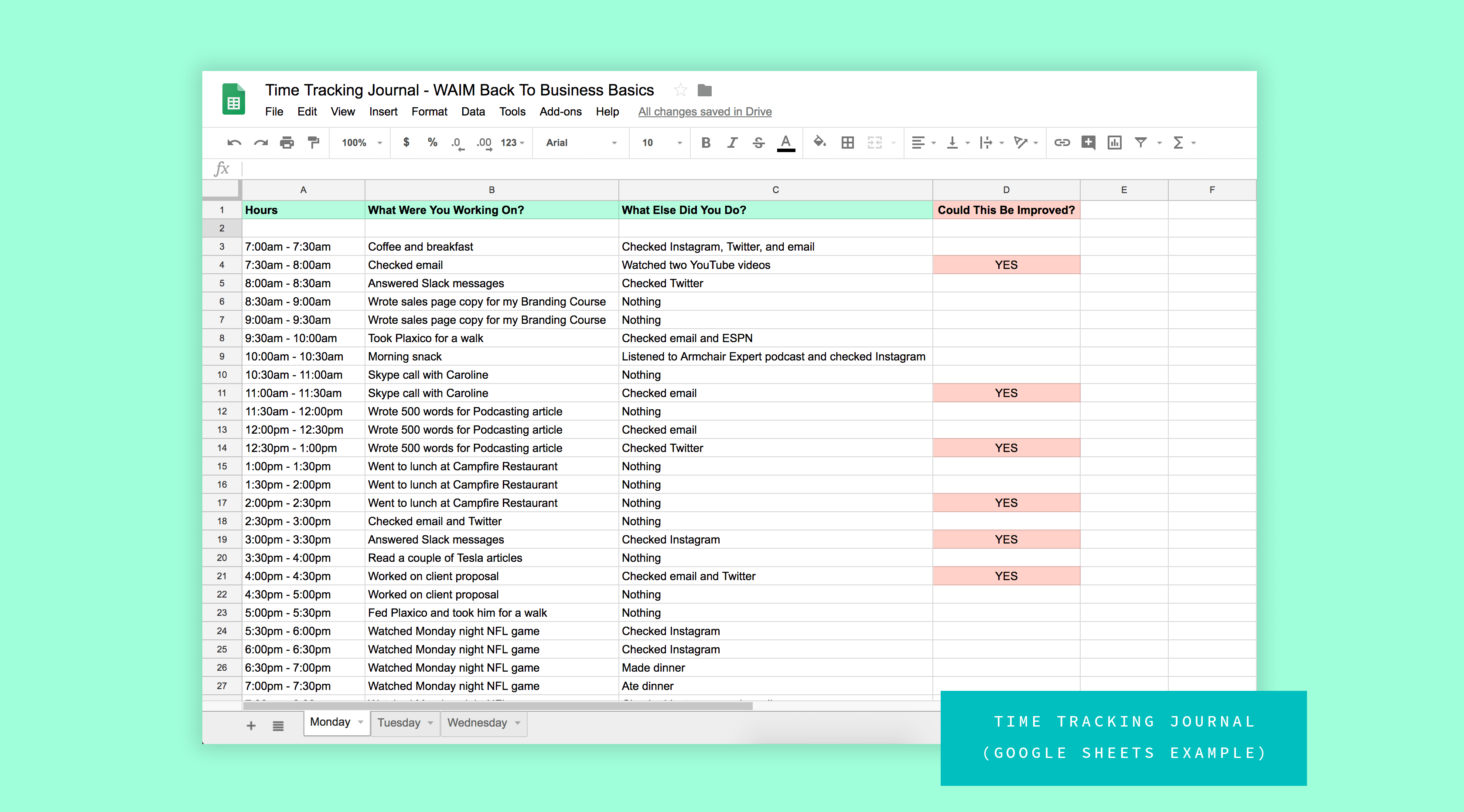
Because our Time Tracking Journal is exactly the same whether you use Google Sheets, Airtable, or pen and paper, we’re not going to walk-through each one. This should be a very simple exercise to keep up with and we’ll share the step-by-step process using Google Sheets as our example…
Step 1: Commit. Commit to yourself and to this simple exercise. YOU GOT THIS!
Step 2: Set a recurring hourly alarm or timer on your phone or calendar. You’ve probably never tracked your time on an hourly basis, so make it easy on yourself and have some sort of reminder that pops up each hour telling you to record where you’ve been spending your time.
Step 3: Track your time via 30-minute blocks in two ways.
What Where You Working On? The first column you want to track is the bigger task or project you were working on (example shown in image: “Wrote sales page copy for my Branding Course”).
![]()
What Else Did You Do? The second column you want to fill out is if you spent time on social media, checking email, etc (example shown in image: “Listened to Armchair Expert podcast and checked Instagram”).
![]()
Step 4: Track all your time spent throughout the day! Do not wait until the end of the day to go back and fill out your Time Tracking Journal. You won’t remember exactly what you worked on and you’ll continue in the cycle of not knowing where your time has gone.
Step 5: At the end of each day, review where you spent your time. Fill out the final column (Could This Be Improved?) with a YES if it could. How many hours could you improve? How many hours could you apply toward more productive things knowing how you actually spend your time?
![]()
Step 6: At the end of the three days (minimum) identify what small changes you can make in your daily life to get more time and focus back for what matters.
Note: The idea for tracking your time is NOT to optimize your days to have as many work hours as possible. The idea is to make sure you see where your time is going and to ensure you’re not letting time slip through the cracks and that you’re allocating time where YOU want to be spending it to reach your life and business goals.
As we mentioned in Exercise #1, we recommend using RescueTime and Moment alongside keeping a Time Tracking Journal. Using the RescueTime and Moment apps are a completely passive way of tracking where you’re spending your time and attention when using your computer or phone. Does it sound like the results might be scary for you? GOOD! We want you to confront your habits and how you’re currently spending your hours otherwise you’ll continue to do what you’ve always done (just like taking a look at your expenses and revenue does for your money!)
*We are not being paid to endorse RescueTime or Moment, we simply believe they’re awesome tools that can show you some really interesting data about how you spend your time.
Determine where the percentage of your time is going for your business and life, and identify your ideal time split.
The wonderful part about the Action Step for Exercise #2 is that RescueTime and Moment are going to do all the work for you (and with nice charts and graphs)!
Step 1: Sign up for a completely free RescueTime account here.
Step 2: Install the RescueTime app on your computer.
Step 3: Let RescueTime do its thing! That’s it. You’ve done all the steps to get RescueTime installed.
Step 4: View your Daily Dashboard in your RescueTime account after your first full day of having it installed. What do you notice? What stands out to you? What do you need to change about how you spend your time on your computer?
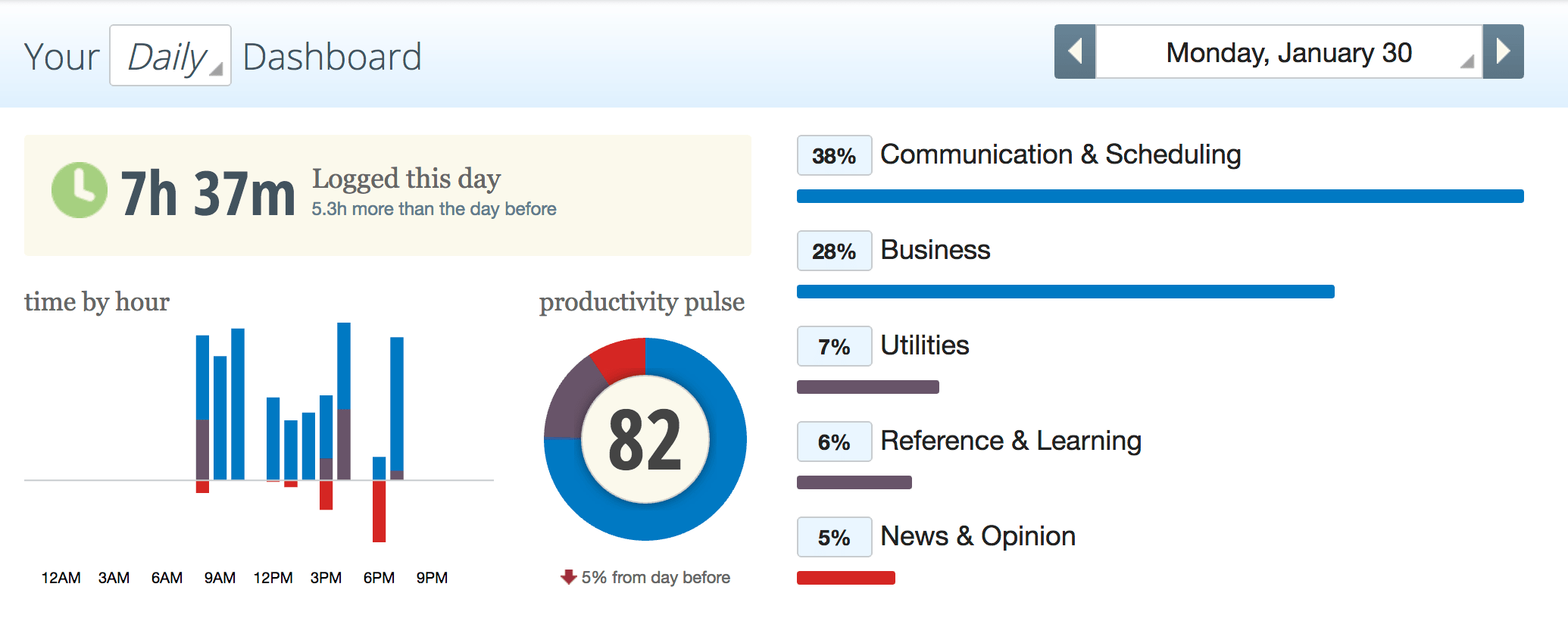
Step 5: Once you’ve had RescueTime installed for a week, you’ll get emailed a nice report. What can you learn from your weekly habits that you need to change?
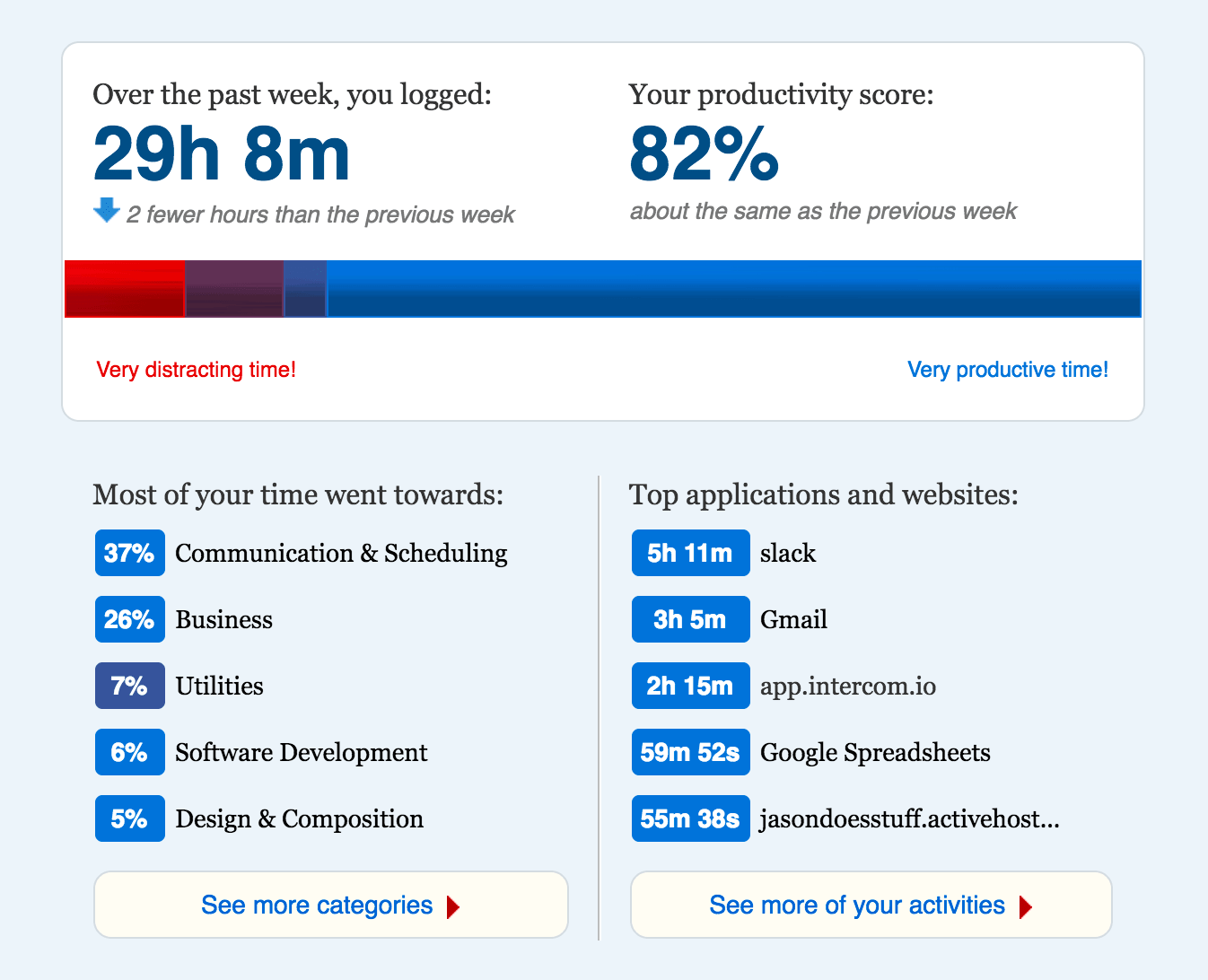
Step 1: Download the app for iOS (for Android checkout App Usage or Quality Time).
Step 2: Say “Yes” or “Okay” to all the steps when you first launch the Moment app. Let it track your time and your location to give you the most accurate time tracking data.
Step 3: Let Moment do its thing! Yep… that’s all you need to do.
Step 4: After a full day of having Moment installed, review your screen time habits. Are you surprised by where you spent your time on your phone? Maybe a bit shocked? What do you need to change? Remember, you don’t have to go cold-turkey, but small changes to your daily usage can go a long way in giving you more time back to put towards other things.
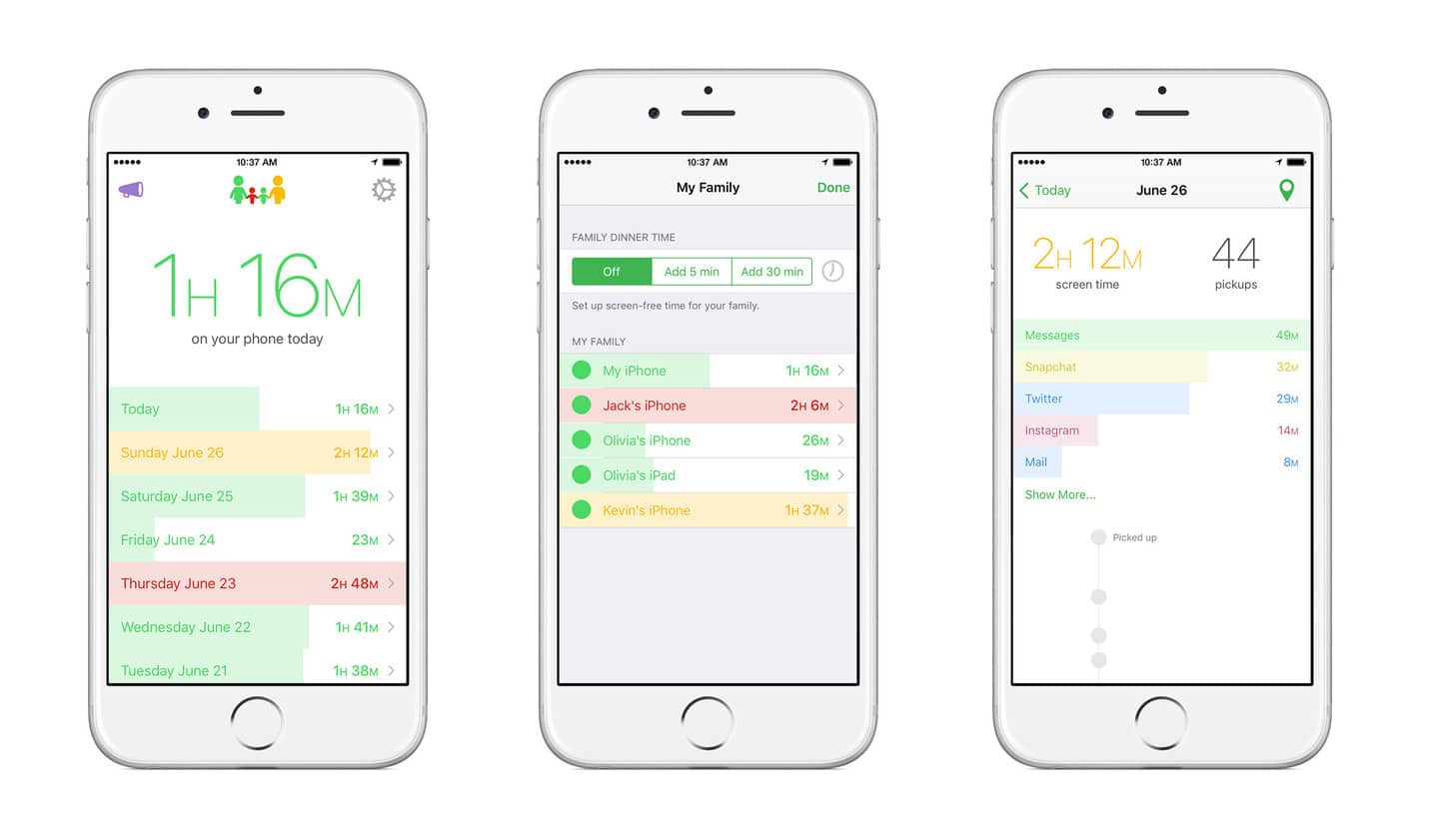
*One thing that’s neat about RescueTime and Moment is that the paid versions of their products have ways to help you block certain activities. Let’s say you have a particularly hard time not being on Facebook, RescueTime and Moment’s paid versions (very cheap!) can help block Facebook for you for certain periods of time.
Recapping Phase Two, here’s what should accomplish by following the two exercises above:
Here are the questions to answer as you track your time and look at the data:
You WILL get more things done and become a more productive person if you take a look at how you’re spending your time each day. The most important part is to admit where you could be doing better and starting making small changes today.
Chances are you’ve asked yourself this age-old question as a business owner:
Well, we’re going to try to help you answer that, but we do have to do a little bit more legwork to get there. Let’s recap what you’ve accomplished thus far.
In Phase One: Know Your Numbers, you should have ended up with a much clearer picture of the profitability of each of your projects or revenue streams.
In Phase Two: Where Does Your Time Go, you should have ended up with a few ways to make your days more intentional and productive.
Armed with deeper knowledge about the two most fundamental resources you have (money and time), it’s time to take a hard look at your revenue streams to understand the single greatest opportunity you have to move your business forward.
In this section, you’ll be evaluating the health of your revenue streams to identify the product or project with the greatest potential upside. We’ll also talk about how to know when it’s time to optimize what you already have going or create something entirely new.
Before you can determine what revenue stream to focus your attention on, it helps to see everything side by side so you can make comparisons.
Fill out the revenue comparison chart with every product or revenue stream from your own business.

Click here to download this template as a PDF
Here’s how we recommend you complete this revenue comparison chart.
Step 1: Download the PDF above or create your own table with 4 columns, listing out your various revenue streams as rows in the first column.
If you have one broad revenue stream such as client work (if you’re a designer, for example) we recommend breaking that down even further into categories. For example: web design clients, logo design clients, etc. This will allow you to make more specific conclusions about what to focus on.
If you have various product offerings, write each one out on a separate line.
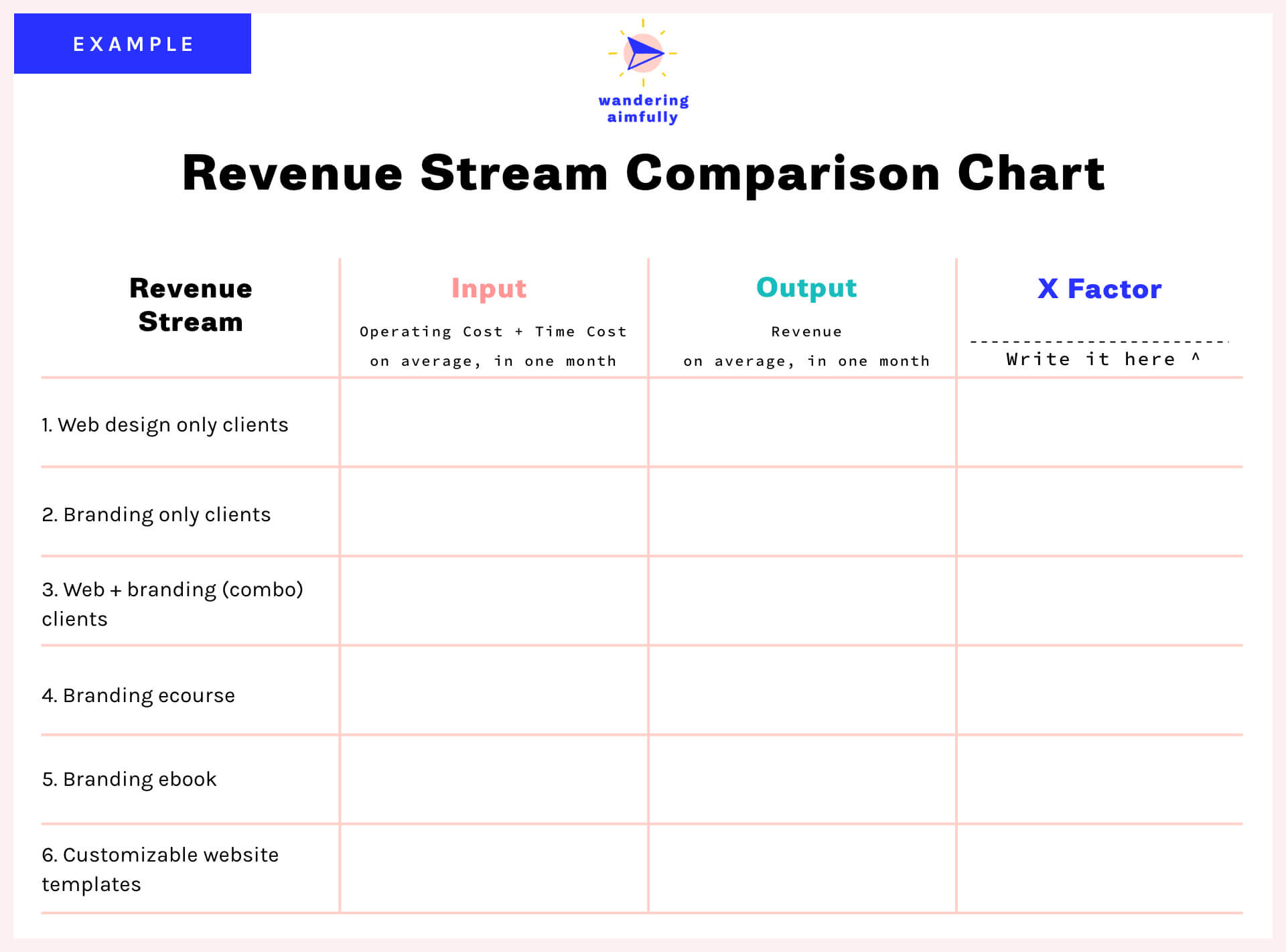
Step 2: For each revenue stream you’ve listed out, now write down the “input” in terms of money AND in terms of time it requires to operate that revenue stream.
Three things to note:
1. It helps to specify a timeframe for the input/output to make sure you’re comparing apples to apples. I recommend using one month. If that’s the case, you want to include how much operating cost you pour into that product or offering in a month’s time and how much time you contribute to it on a monthly basis. It may help to estimate your time by the week and then multiply by 4.
2. You may also want to assign a monetary value to your time in order to later compare it with that revenue stream’s output. For example, you could say your time is worth a flat $100/hour, so a revenue stream that takes 30 hours a month and $300 to run, would actually require $3,300 of input.
3. If you have general expenses that aren’t revenue stream specific, take that monthly total and divide it evenly among your various revenue streams so it’s a distributed cost.
4. As far as time goes, for products you want to think about ongoing input or operating input for the purposes of comparison, not necessarily the time it takes up front to create the product.
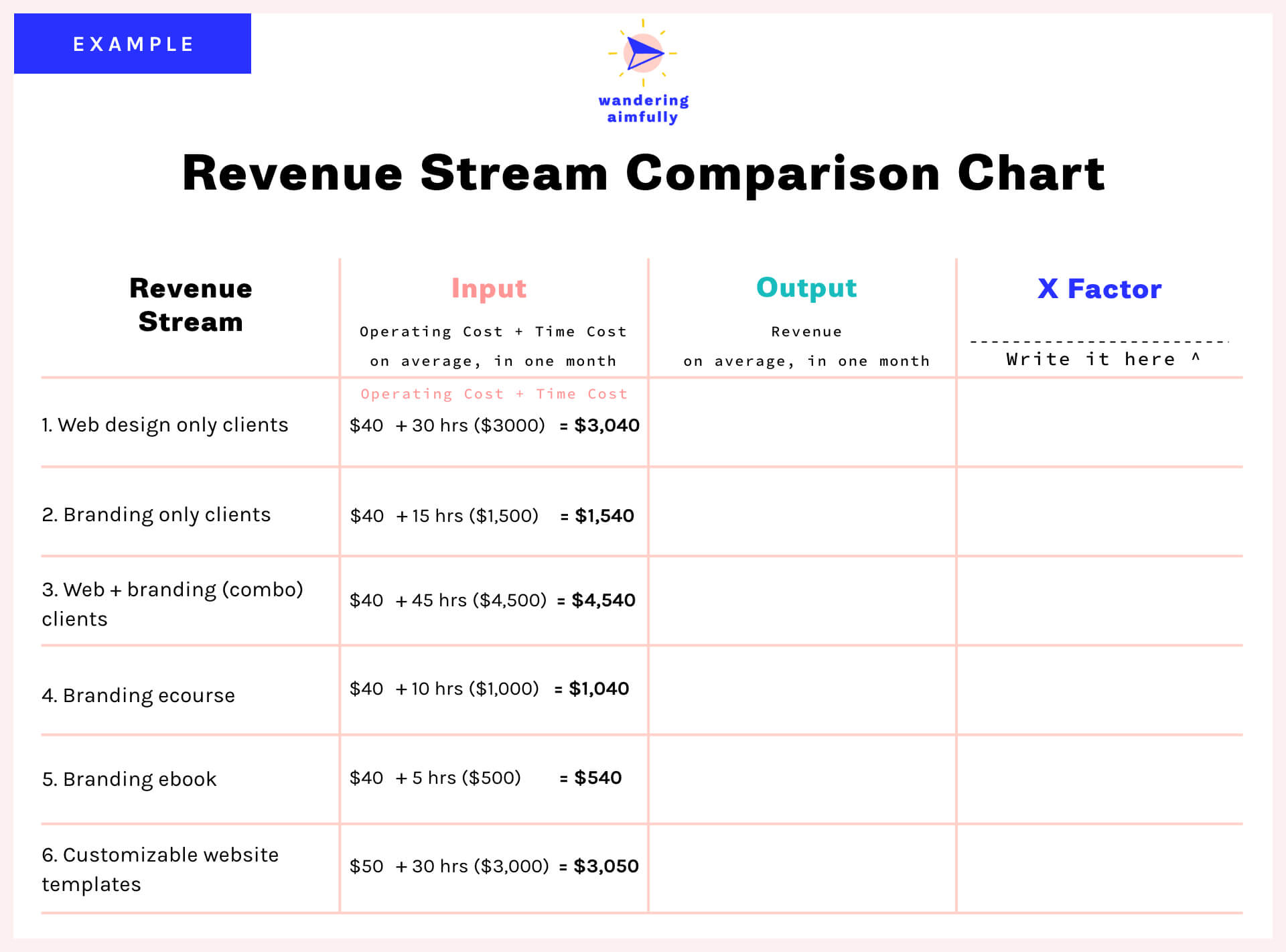
Step 3: Consult your revenue tracker from the Know Your Numbers section and use the totals to fill out the output column.
If you completed Phase One, then you should know how much on average you make in a month per revenue stream. If you didn’t already complete that exercise, be sure to sum up those totals and write them down in the output column.
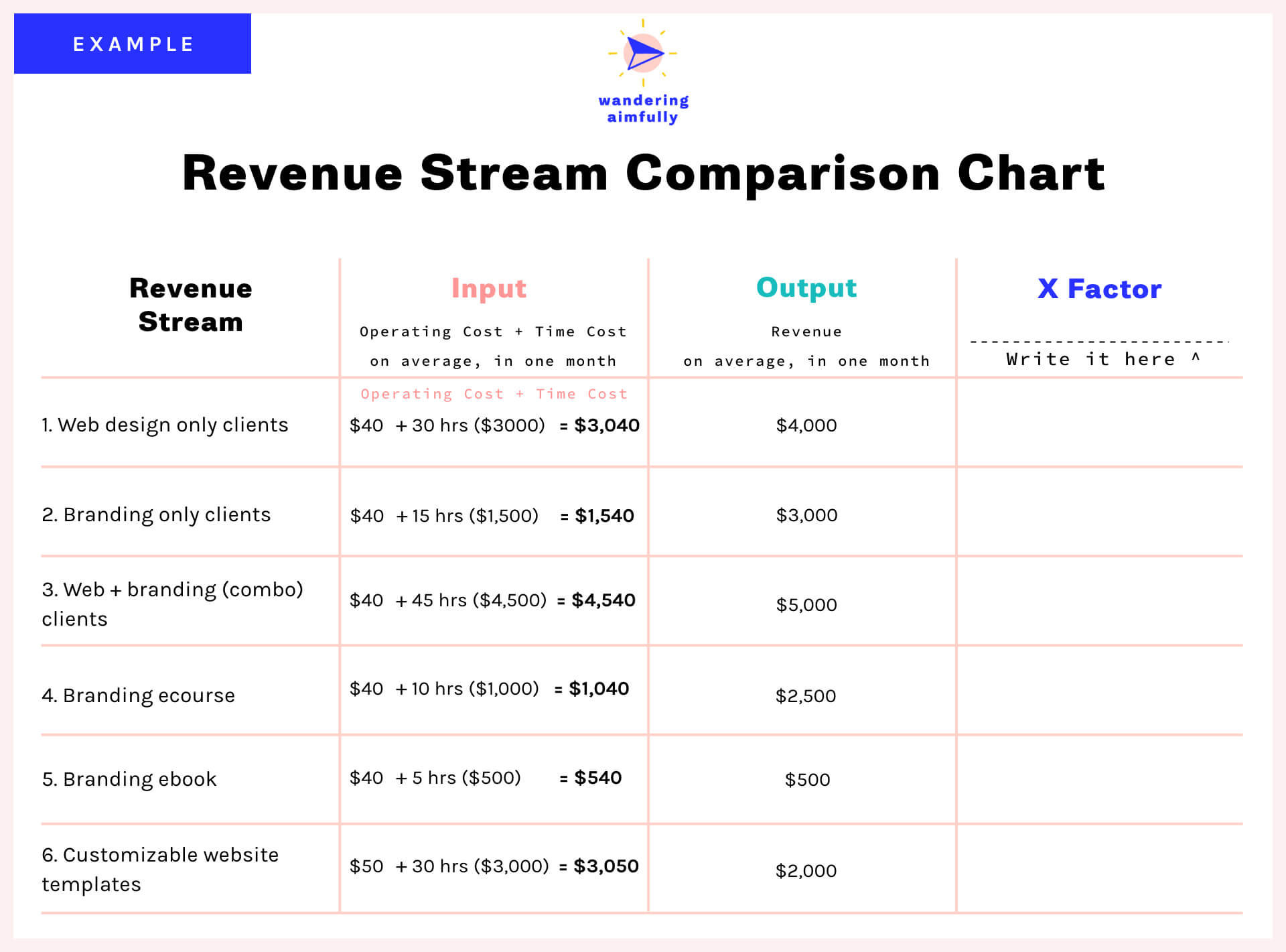
Step 4: Now this last part is really crucial for the decision-making that will result from this comparison. Finally, use the fourth column as your “X factor”—aka one more comparison criteria that matters to you.
This X factor could be enjoyment (how much you like working on that revenue stream) or it could be alignment (how well it lines up with your personal values) or it could be something like “future vision” (how well it meshes with the vision of where you want to steer your brand.)
The point is, you get to choose. Write it down as the final column header and then write in a number between 1 and 10 for using that criteria for each one of your revenue streams.
That should complete your revenue comparison chart and it should look something like this:
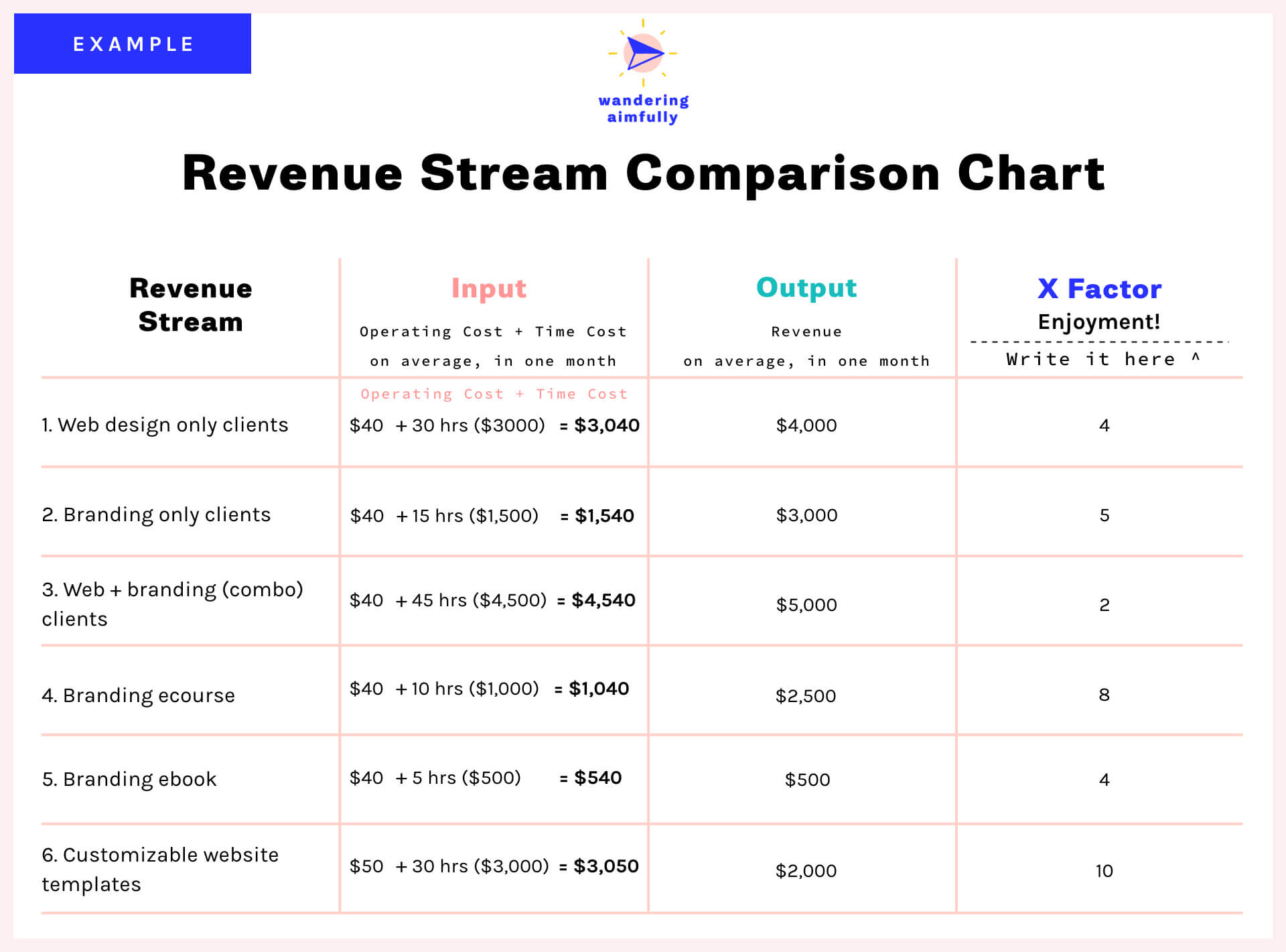
Now that you have all this information, it’s time to use it!
We want to use the comparison chart to look for the revenue stream with the greatest opportunity for impact. This means finding the revenue stream with the most efficient output to input ratio (ie. greatest output for the least input) but also with the highest X factor score.
One way to do that is to divide the output column by the input column to come up with an “efficiency score.” This makes it super easy to see the stream with the greatest output for least input, because the score will be the highest number.
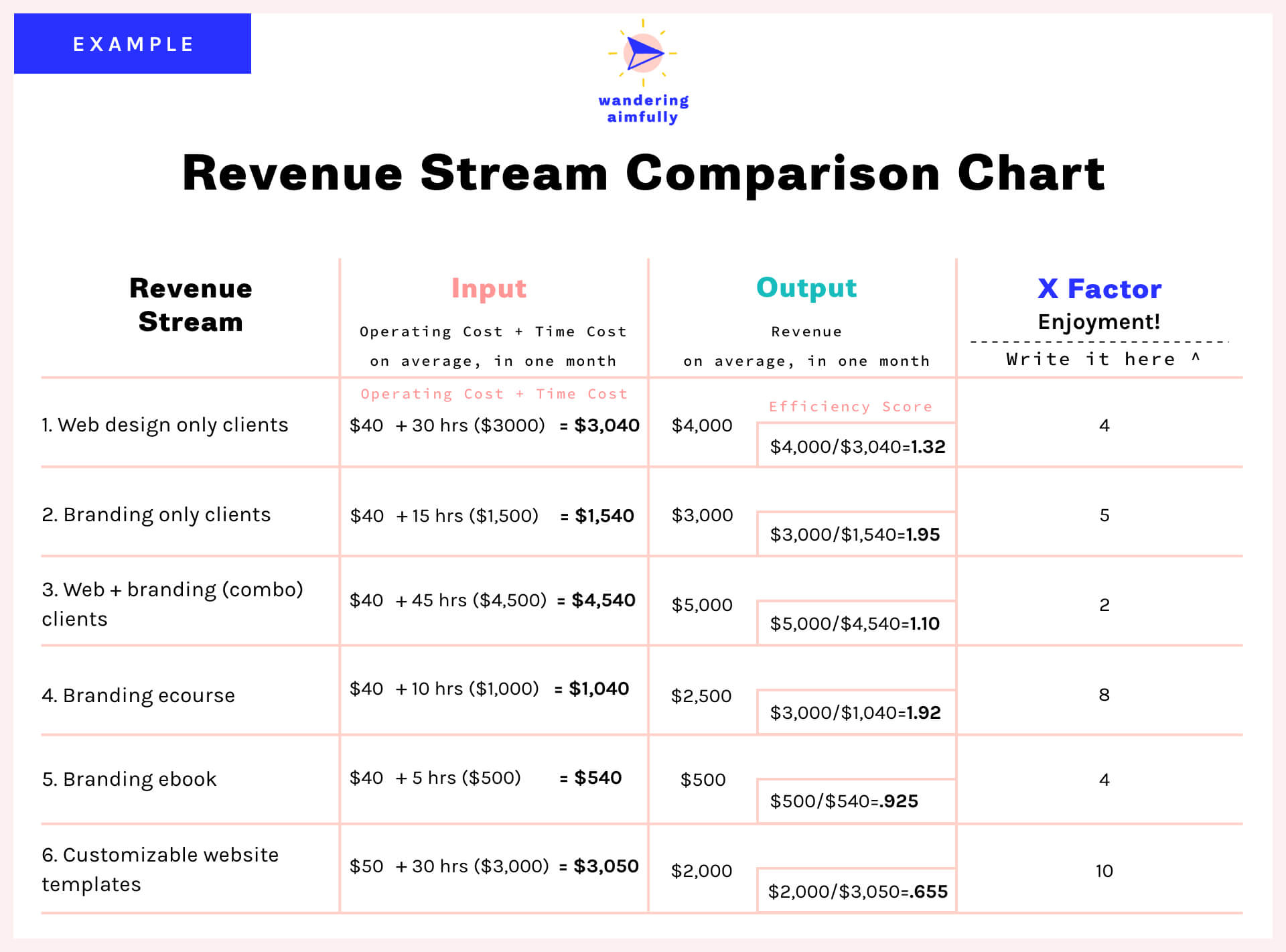
But, don’t forget, we have to also consider the X factor criteria. Your revenue stream with the highest efficiency score might actually be the one you enjoy the least, which isn’t necessarily the best thing to focus on going forward. Instead, look for revenue streams with relatively high efficiency scores AND high X factor scores.
For example, you can see “Branding only clients” and “Branding ecourse” in the example have a similar efficiency score BUT one of them has a much higher enjoyment score:
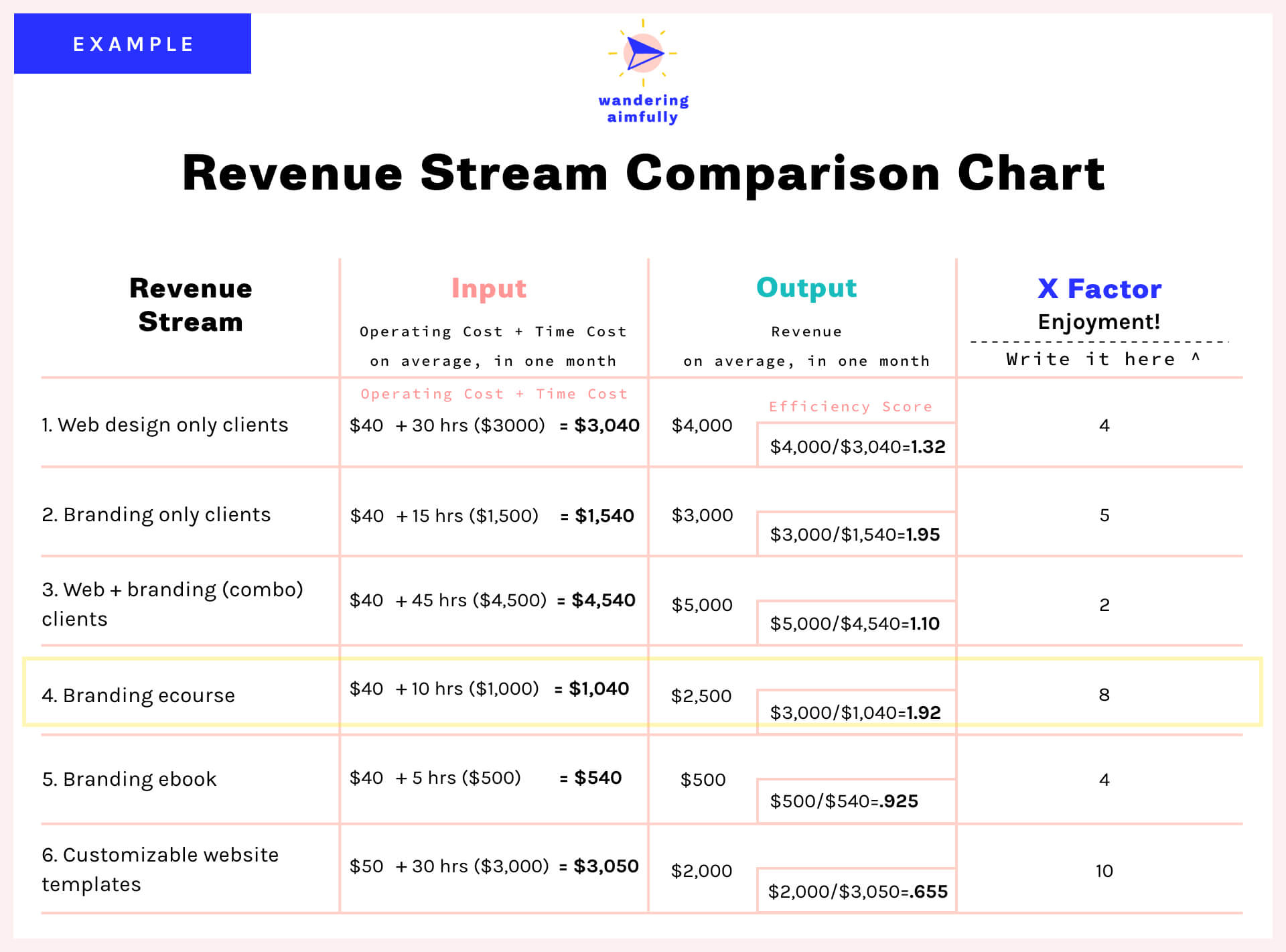
Using the example, now I’m able to see that out of all my various projects, the branding e-course is probably worth investing in and focusing on. While it may not be the source of greatest revenue (YET) it’s efficient at making money (meaning time poured into it will see a notable return) AND it’s something that I enjoy doing.
This is how you can use this comparison chart to choose what to focus on.
Keep in mind, you can make up your own rules too. Maybe instead of the efficiency score method, you want to choose the revenue stream that is making you the most money with the most enjoyment, and you don’t care how many hours or how much money it takes to operate. That’s okay. The idea is just to think critically about your various projects and make decisions based on real data, rather than simply feeling stuck or overwhelmed with no idea of what to focus on.
Now, you might be asking yourself, what if none of my current revenue streams are really working? Is it time to try creating something new?
The answer is maybe. But we always try to caution people about immediately jumping to the conclusion that it’s time to create something new. Why? Because it’s all too easy to get caught up in “shiny object syndrome.” The nature of creativity is that we get excited about projects in the beginning and once time goes on they begin to lose their luster.
Part of running a successful and profitable business is learning how to use your time and energy in the most efficient, impactful way possible. Creating something new often requires you to reinvent the wheel and while it may be exciting, it can be a drain on your resources. Instead, it’s advisable to find ways to fall back in love with your existing projects or find ways to breathe new life into those.
Recapping this phase, here’s what you should accomplish by following the steps above:
Here are some questions to answer as you take a look at your revenue streams:
Hopefully, by now, you’re starting to see a clear path forward on what to focus on next. If not, this final phase of Back To Business Basics is the time to make that decision and create a specific action plan moving forward.
If you haven’t already, start by looking back at Phase Three and your revenue stream comparison chart to determine which revenue stream has the highest potential impact on your business. You can base this decision off the more analytical route we went over in Phase Three about checking your efficiency scores and comparing with your X factor.
If you’re still struggling after that, another thing we consider when choosing where to place our focus to move things forward is to look at everything we’re currently working on and identify what we call the Brick Walls and Cracked Doors.
Brick Walls are what we call obstacles you repeatedly find yourself bumping up against over and over with one of your revenue streams.
Example Brick Wall: Let’s say you’re a designer and you constantly find yourself working more hours on projects than you estimated, meaning ultimately you’re getting paid less than you’re worth for the time you spend on client work. You’ve tried to optimize your process for estimating your time when you quote projects, but inevitably you find yourself logging overtime project after project.
Example Brick Wall Solution: It might be time to consider shifting your focus away from that revenue stream and trying something like digital products so you’re not trading time for money—something that consistently gives you headaches.
Cracked Doors, on the other hand, are what we call slivers of opportunity that present themselves or an area where you feel the momentum building in your business.
Maybe you have a particular blog post on a topic that’s really taking off an getting a lot of traction. Maybe you have a client who you’ve worked with a few times and they’ve floated the idea of paying you a monthly retainer. Maybe you have an influx of emails asking you if you offer a particular offering that’s not listed on your website. These are things to take note of and things that may not come through in the “data” of your comparison chart from Phase Three.
Note when it comes to Cracked Doors: Beware of shiny object syndrome! There’s a difference between spotting a smart opportunity for your business and just being bored of what you’re already doing so you’re craving something new. Part of being a shrewd business owner is being able to spot the difference. Creating something entirely new should actually be the last thing you prescribe your business for all the reasons outlined in the final section of Phase Three.
Now, with all these things considered, it’s time to pick your pony!
Using the revenue stream comparison chart to guide you, choose ONE single area of your business to make the primary focus for the next three months.
Once you know WHAT to work on, it’s important to define what “working on it” is aiming to get you. We need to establish a goal. Yay goals!
Head back to your Revenue Tracker from Phase One and determine realistic revenue goals for the next three months. We like to measure our previous (actual) revenue against upcoming (projected) revenue multiple times throughout the year. Now is the perfect time to project your revenue by project or client for the next three months (feel free to add it right into your Revenue Tracker sheet or Airtable)
You may also want to determine a time-related goal. Based on what you learned in Phase Two: What Do You Spend Your Time On, it’s not just about spending more hours working. It’s about spending the right hours doing the right work. It may make sense for you to write down how many hours a week you’re trying to keep these growth efforts constrained to, so you don’t just find yourself in a situation where you’re feeling burned out. Remember, this is also a way of keeping your input (your time cost) as low as you can, making your revenue stream as efficient as possible.
If you’ve gone through all phases of Back To Business Basics and believe now is the time to create a completely new revenue stream, now is a great time to schedule the production and estimate your revenue. A couple questions to answer that should help you:
You know what to focus on, you know what you’re aiming for, but now it’s time to determine what exactly you’re going to do to improve your revenue and to create a clear action plan to make that happen.
Part of the overwhelm of being an entrepreneur is that there are an endless amount of things you can try or change when it comes to your business in order to improve it. To make these options more manageable, we break them down into three core categories: 1) Process; 2) Product; or 3) Promotion.
Here are some ideas of how to beef up your revenue stream by improving these three areas:
To get the answers, consider getting feedback from existing customers by emailing them simple surveys with just a few questions (we love Typeform for surveys).
Sending a survey via email is great, but don’t hesitate to hop on Skype to chat face-to-face. Some of the best feedback we’ve ever received for our businesses has come from actual conversations with existing or potential customers. Make sure you let them know you want honest, constructive feedback and then see if there are any recurring themes in that feedback.
Similarly, you may want to get feedback from people who don’t buy. For example, with our Wandering Aimfully membership, if someone clicked on our sales page and showed interest but didn’t buy, we email them a few days after launch and ask them to fill out a short survey. This allows us to see if there’s anything we’re missing in terms of what our membership offers or how we’re communicating it.
If you know your product solves a particular problem and its top-notch, it’s possible your problem lies with the promotion. Any of the following could be to blame for this disconnect:
*We’re guilty of this one and we see it all the time. It’s human nature to focus on the features of what you sell in your sales copy, instead of what problem it solves for your customer (the benefits). The easiest way to figure out if you’re not communicating the problem is to refer back to survey results to the question you asked about this. You could also have someone else who has similar experience running an online business review your sales copy to see if it’s speaking to the features (wrong) or the benefits (right!)
And here are some potential solutions to your promotion problems:
Finally, if your product is great and you feel you’re getting a steady influx of customers, it’s possible the improvements could lie in your process.
Does this revenue stream take up too much of your time? Are there parts of the process that could be smoother for your customer or for you?
For example, maybe you find with your clients that a lot of time is wasted on your first call together just getting an understanding of the project specifics. Could you develop an intake survey you could send via email that would give you background info to make your meetings more productive? Then you could have a first call that’s much more streamlined. Things like this may require a time investment up front but will make you more efficient over time.
Ultimately, you should have an understanding by this point of what processes might need fixing in your business (hint: many of them will have to do with time allocation and management). What have you seen after going through the first three phases of Back To Business Basics that need attention?
Using the ideas above (or your own), write down THREE improvements you plan to make to your chosen revenue stream in order to reach your three-month revenue goals. Bonus points if you want to share those with us via email for some extra accountability.
It’s not enough to just write a few tactics and a revenue goal down on paper. You have to find a way to really integrate this plan into your schedule and your existing workflow.
Remember, business is a complicated puzzle. There are so many moving parts, and you may not find immediate success or growth with the first thing you try. If you implement your chosen three improvements and don’t see the life you’d hoped for, experiment with three more. Succeeding with your business is about taking imperfect action, testing your assumptions, and utilizing your newfound focus.
If we can help on your journey, feel free to reach out to us!
Heads up: This post was first created on September 1, 2018 and the final entry was written on October 21, 2021 when we hit our Enough Goal! ✅ 😍
We’ve decided to publicly share our journey to making “enough” money with Wandering Aimfully. The idea behind this is not to show off how much money we’re making, the idea is to show exactly HOW we’re doing it.
One of our core values here at Wandering Aimfully (or WAIM, as we like to abbreviate it and will do throughout this post) is transparency.
Transparency becomes especially important to us when it comes to money because there are so many emotions and thoughts that often get tied to money (greed, shame, self-worth, happiness, embarrassment, etc), some of which can present challenges to the way we pursue our goals.
Before we get too deep into things, you might not know who the heck “we” are, in which case you may want to mosey on over to our About Page to learn more about us—Jason and Caroline Zook. If you just want the TL;DR version: We’re a husband and wife creative duo, with no employees, running our own businesses for over a decade, currently living and working together in Southern California. For good measure, here’s a super cute photo of us…
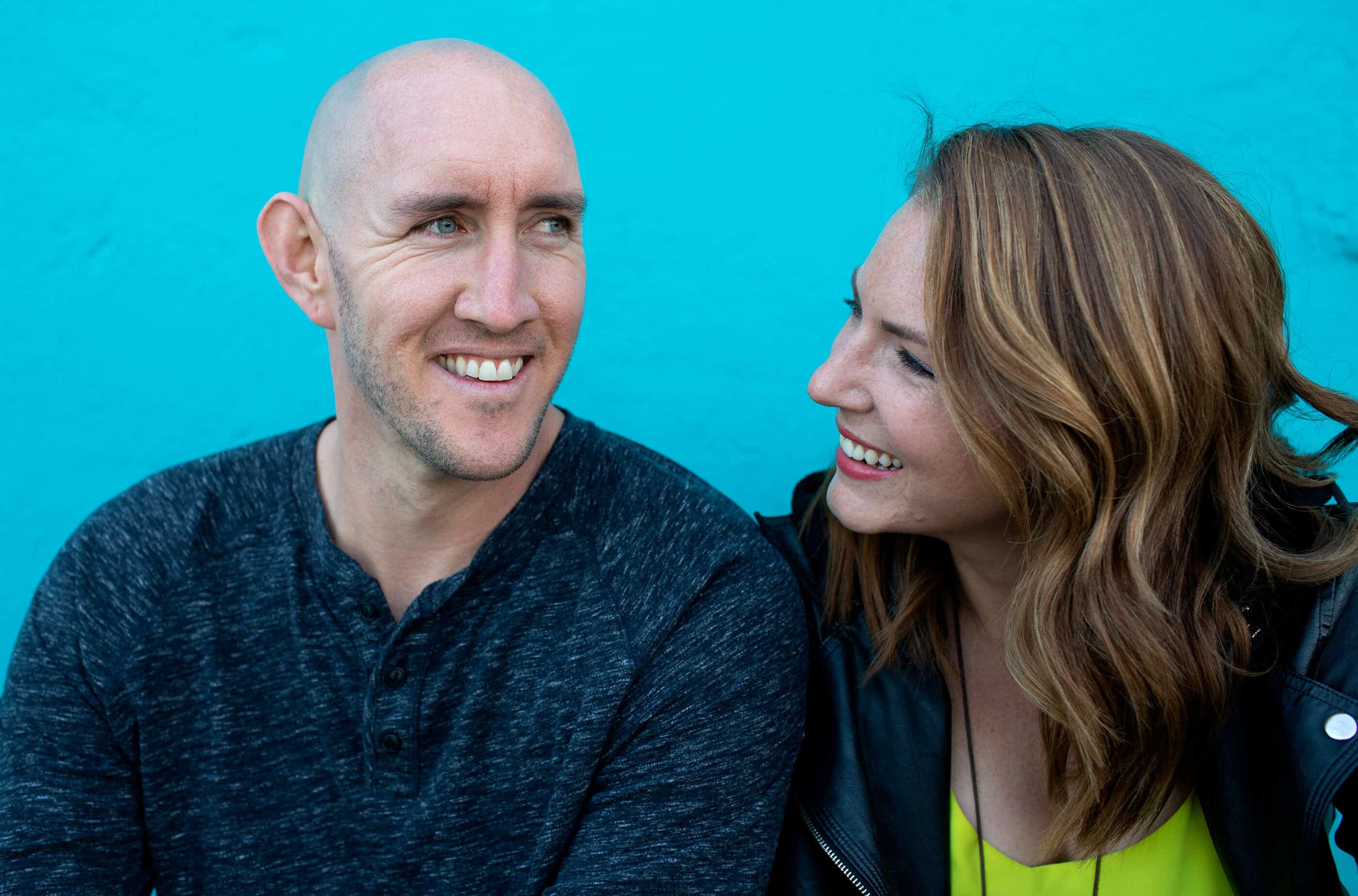
Now that we’ve met, let’s talk about this goal of getting 330 people to join our Wandering Aimfully Membership.
From years of experience, we know how it easy it is to get fixated on making more money. Yes, we know how good it can feel to see a couple extra thousand dollars in your bank account after a big launch, but we also know the mental toll it takes to constantly be in promotion, marketing, and sales mode. That’s partly why we’ve decided to give ourselves an “enough number.” When we finally reach this number, we can stop feeling the constant pull of promotion. We can focus fully on the amazing community we’ve built, rather than constantly be searching outside of the community for more members.
We also believe that defining your enough is the only way to ever feel satisfied. So often we focus on the vague word “happiness” without defining what it really is. We believe a big part of happiness is this notion of satisfaction. So, let’s explore for a second this idea of satisfaction.
One definition we found for the word satisfaction was:
The pleasure derived from the fulfillment of one’s needs.
Think of your wants and needs as an empty bucket. The pursuit of fulfillment is the quest to fill that bucket, and satisfaction is the pleasure you get from recognizing it’s indeed full.
But here is the root of why satisfaction seems to be so elusive:
How can we be fulfilled when we have no idea how big the bucket is we’re trying to fill?
Without defining what your needs are—without setting that benchmark—you will just keep trying to fill a bucket that’s endlessly expanding. That’s a recipe for a lifetime of discontent.
Instead, if you want to experience satisfaction (ie. happiness), you need to define how big your bucket needs to be…and then you need to recognize it when it’s full.
Or, in other words, you need to figure out how much is ENOUGH.
Getting to 330 paying Wandering Aimfully members within 12 months time will net us $33,000 in monthly recurring revenue (MRR). After we hit that number, we’ll close the proverbial sales-doors and stop accepting new members. We aren’t interested in continuing to grow our membership community (and make more money) just because we can.
In a highly digital world, we want to plan for and offer a personalized touch.
Why 12 months? Each month we’ll limit new memberships to 30 per month, so technically we should be able to get to our goal before 12 months (yay, math!), but we want to leave a bit of buffer in our membership signup planning especially because we know we’ll have some customer cancellations (aka churn). Limiting our memberships to 30 new people per month allows us to deliver as much of a personalized experience as we can, including some non-digital stuff.
Additionally, limiting the amount of new monthly members ensures that the community doesn’t feel crowed or overwhelming to our existing awesome members. It’s important to us to preserve the culture of the community, which we know to be one of our major selling points and differentiators.
For context, it might also help you to know how our membership pricing works. It’s very simple:
Both membership options include the exact same thing, the annual option simply saves someone a couple hundred dollars by paying in advance. If you want to learn more about what we include in our WAIM Membership, click here.
We’d be remiss if we didn’t mention some important advantages we have in this Journey to 330:
There’s no denying those are helpful pieces of this puzzle that we already have at our disposal. That being said, this is a new business offering for us and for our audience.
We told you we value transparency, didn’t we? Well, it’s about to get really real up in here.
A fundamental part of our approach to work and life is a philosophy we call Working To Live. Part of this ethos is the belief that living a fulfilling life begins with establishing our ideal lifestyle and then reverse engineering our business decisions to support and align with this lifestyle.
Using this approach, we first identify what we WANT, and then we back out how much money we need to get there.
That equation is how we arrived at our specific number of $33,000.
“We first identify what we WANT, and then we back out how much money we need to get there.”
That number may or may not seem outrageous to you. It’s taken a lot of restraint not to write paragraphs of text defending how much we spend in living expenses every month. But therein lies the problem when it comes to money: we constantly feel like we’re being judged or we feel we have to be on the defensive about our spending.
So, how about this as justification…We spend this much money every month to live lives we absolutely love. It’s awesome to be able to do that, right? We agree! But, it wasn’t always this way. In fact, it was just back in 2013 we spent $4,000 per month and could barely make ends meet (you can read our getting out of debt guide here).
Here are how our monthly living expenses break down in broad strokes:
*We don’t actually spend $2,000 on travel per month, but the past two years we’ve averaged spending about $20,000 on travel per year. We put this as a monthly “expense” to keep a watchful eye on it.
**Donating to causes we care about is a big part of our Journey to 330 goal as you’ll read in a moment.
Our business expenses have fluctuated quite a bit over the years due to how many different businesses and projects we have. That being said, one of our huge goals with starting WAIM was to streamline all of our projects into ONE membership and create a much more predictable set of business expenses. We believe this number is actually going to decrease over time, but for now we’re using a comfortable monthly average (which we’ll share more about in detail as the monthly updates continue to get added to this post).
Oh taxes, you necessary evil, you. First, we aren’t going to be those people that gripe about paying taxes. We understand and believe in taxes. This monthly average number will absolutely change over time, but we’ve decided to base it on our previous two years of business (taking what we paid in total taxes annually and dividing that by 12 to get a monthly average number). We do a /decent/ job of setting aside money for our taxes each year, but with a more predictable MRR going forward, this will get much easier!
Have you heard of this mystical thing in business called “profit??” It’s a pretty crazy phenomenon we’re just hearing about! It means that you don’t just spend every dollar your business brings in, but that you can keep some of it! It escaped us for a few years, but we’ve decided to utilize its wonderful powers going forward and put a much heavier focus on it 😂. Alright, jokes aside, our goal is to have $10,000 every month we can put into our savings, investments, and not touch at all. We’ve NEVER been able to predictably save a sizable amount of money each month and we want that to change.
It’s probably worth mentioning that we *have* been saving and investing the past few years, just not in a super regimented fashion. You can read how we currently invest and save our money here.
It can be really hard to give money to organizations and great causes when you can barely eek a profit out of your business. We’ve managed to redistribute some of our wealth every month since 2018 because we’re finally prioritizing it, but we want to do much more. Part of this Journey to 330 is to bake charitable giving wealth redistribution into our financial plan. We want to allocate 10% of our total monthly revenue to non-profit organizations, causes, and other acts of good that come onto our radar each month. The idea of having $3,000 every month that we can give away and help make a difference is something we’re really excited about!
**
Those five categories of money add up to $33,000. As a reminder, our goal is to hit $33,000 in monthly recurring revenue in 12 months (that would be by September 1, 2019). Will it happen? What are we doing to make it happen? Find out each month going forward by referring back to this post. We’ll add an updated section each month with how our launches are going, what we’re doing to reach this goal of 330 members, and how our feelings continue to evolve about this enough goal.
SPOILER ALERT: We absolutely did NOT hit our enough goal of $33,000 in just one year 🙈😬🤣. Boy, was that wishful thinking! Keep on reading to find out how we finally hit that goal after 3 years.
As of September 1, 2018:
Monthly Recurring Revenue (MRR): $4,783
Total Paying WAIM Members: 48
Monthly Profit and loss:
Total WAIM MRR: $4,783
Total WAIM Fees (Stripe/PayPal): $145
Total Expenses to Build WAIM: $16,500
Monthly Expenses in August: $7,460
TOTAL PROFIT: -$19,177 (eeeeek)
Quick hits of what we did to get this first group of paying members:
Ideally, we would’ve started this public journey at $0 MRR. Unfortunately, it takes a lot of time to put something like this Journey to 330 post together and we simply didn’t have the time while we were building our actual website and business. Every hour we had from March 1 – August 19 (2018) was spent bringing Wandering Aimfully to life. During that time we did a pre-order of our WAIM Membership and a first public launch.
In trying to keep this first update as succinct as possible (the irony is thick there), just know we spent five months planning, designing, building, working with developers, going through 400 of our past articles, riding a bunch of emotional roller coasters, creating our purchasing flow, and completing well over 2,000 tasks to bring this website and our membership offering to life. We also had a website dedicated to the behind the scenes of building WAIM, which was live from March 1 to August 19.

Before WAIM was finished being built, we knew we wanted to offer a pre-order for our memberships. We made this decision based on two things:
We opened up our pre-order for just one week, limited it to 30 buyers only, and sent three emails to a list of 400ish subscribers (this was a segment of our bigger list that had opted into daily-ish blog posts about how the build was going). Our three emails were fairly simple and explained the gist of the membership, the existing courses/workshops they’d get access to, and then a tease of what was coming in future months with WAIM.
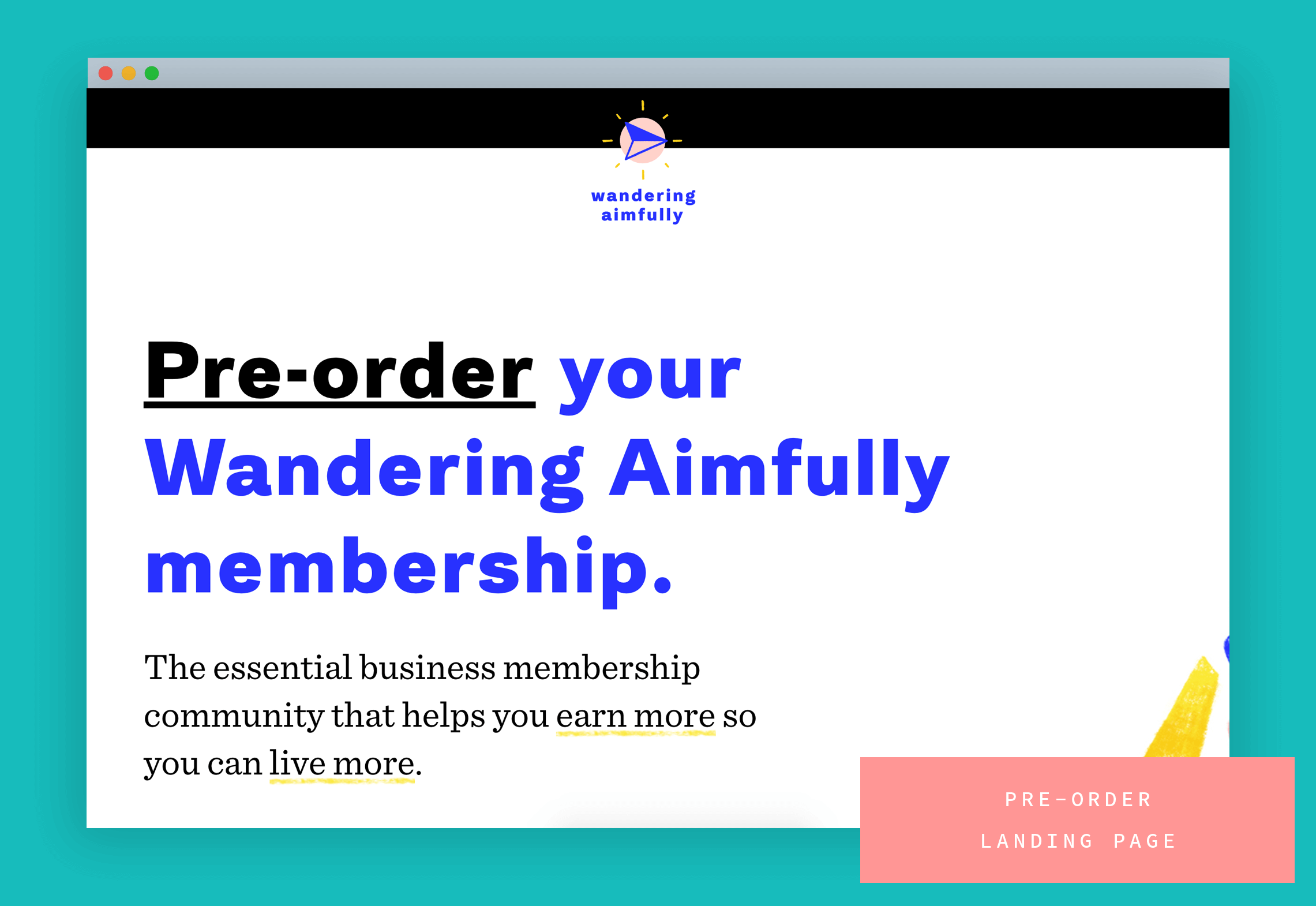
There was only one hitch: We told our pre-order members they wouldn’t get full access to everything for at least a month (sell before you’re ready!)
While they’d receive access to our courses, this custom member dashboard we kept telling them about wouldn’t be fully coded for at least another month. Would people still pre-order if they couldn’t get the full experience right away? Well…

(You’ll notice the Airtable view of customers only shows 13 people and this is because two of our pre-order members canceled a few months in – sad panda. We’ll talk more about this in a moment.)
With our website finally up and running it was time to do our first official launch! August 20 was the start date and we would leave the “cart” open for one week, again limiting the number of buyers to just 30 people. This launch was quite a bit different from our pre-order because it also coincided with the website going live and we sent sales emails to our entire email list.
We decided early on that we’d write a behind the scenes journal sharing all of our processes, decisions, roadblocks, problems, and even share full unedited video meetings. From March 21 to August 5 we created and shared:
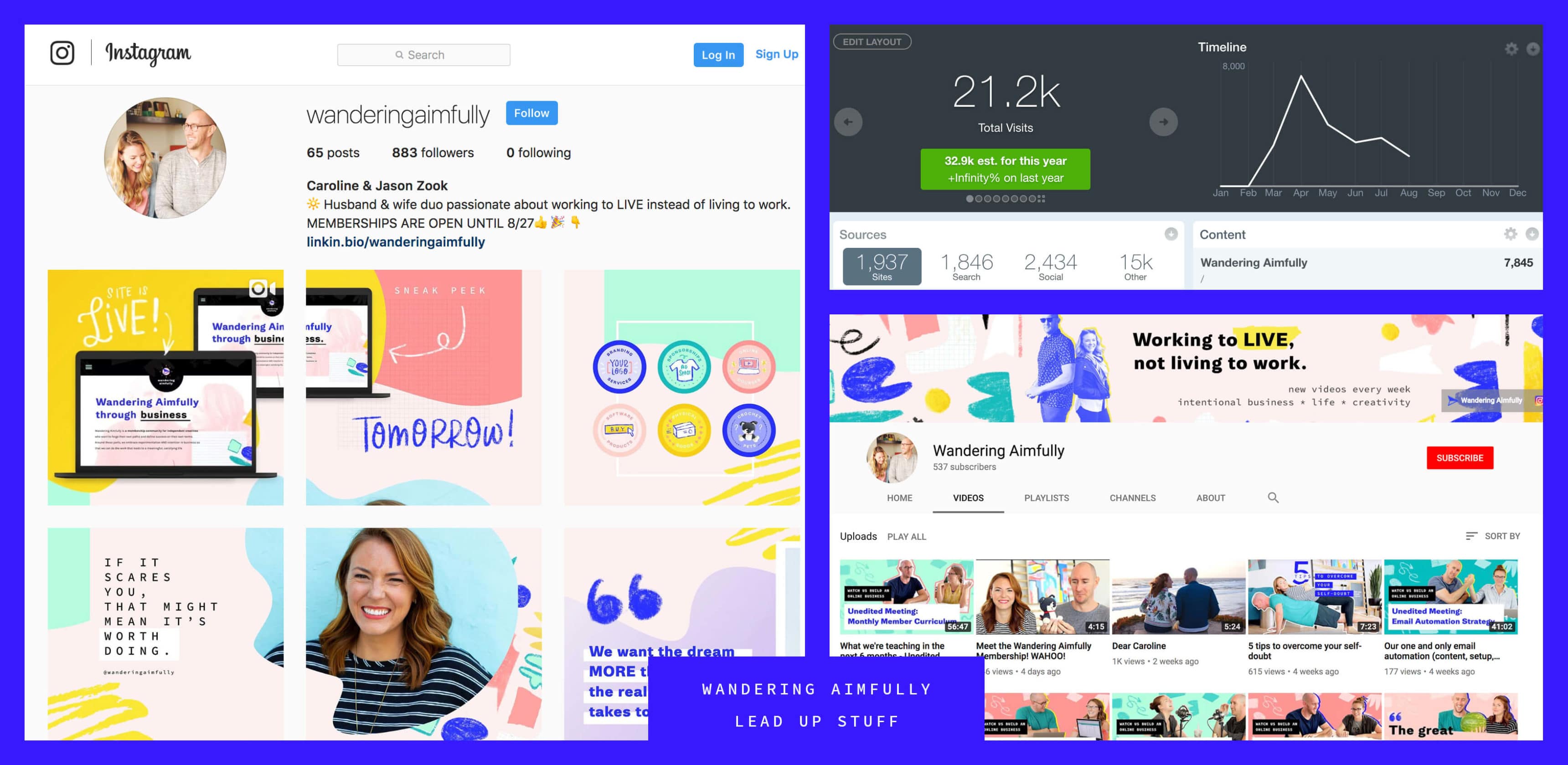
Here’s what that looked like…
Caroline’s previous email list (Self-Made Society): On August 5 Caroline mentioned that WAIM was coming on August 20. This was sent to 5,502 subscribers and 1,514 of those subscribers opened the email (27.5% open rate).
My previous email list (JasonDoesStuff): On August 7 I mentioned to my email list that WAIM was launching on August 20. This was sent to 11,538 subscribers and 2,477 of those subscribers opened the email (21.5% open rate).
Our first combined newsletter (Wandering Weekly): On August 13 we sent our first combined email newsletter prepping the subscribers of our new website and membership on August 20. This was sent to 16,684 subscribers and 2,411 of those subscribers opened the email (14.5%* open rate).
*Something definitely went wrong with this email broadcast. We actually reached out to our email provider and they admitted something looked weird. Unfortunately, we had too many to-dos on our list to diagnose things and didn’t want to try to resend the email with fear of something else going wrong or happening with our email reputation.
We shared teasers and whatnot on social media: While our social media follower numbers are nothing to scoff at, it’s important to note we also don’t see social media as a huge driver of new traffic or sales. Even though I have 31,000+ followers on Twitter, the engagement of even the most exciting of tweets is VERY low. Caroline has 2,900+ followers on Twitter, but I think she’d echo my statements about engagement (and she mostly just pushes her Instagram posts through to Twitter). Speaking of, Caroline wins our household Instagram award with 16,000+ followers; I have just a touch over 3,000 followers; and Caroline runs our @wanderingaimfully account which has 900+ followers. Those numbers are just to give you an idea of the impressions we’re working with. Numbers aside, we posted a handful of tweets with teaser images, shared a few stories on Instagram, and just generally kept people tuned-in to the launch date of August 20. Caroline did work some pretty awesome grid-magic on IG (as you may have noticed in the “Lead Up Stuff” image above).
This isn’t our first rodeo selling something over the course of a week. We knew we didn’t want to be writing and sending sales emails the night before (we’ve done that too many times and it’s stressssssful), so instead we whipped up a Google Doc and wrote all our sales emails in one spot.
Pro-tip: This is also a great way to get the subject line, preview line, links, etc organized ahead of time.

Then Caroline worked her wizardry in our email provider ( Drip [aff link]) to set up a “campaign,” which is just a string of emails with a simple sending schedule (shown above). Here is the timing of the sales emails along with the general topic discussed:
These emails were sent to our newly combined (as of August 13) Wandering Weekly email list minus the last email in the campaign because we hit our goal and didn’t need to send a “Last call” email. Who turns off one extra sales email during a launch knowing it would probably bring in more sales? We do. That’s who.
In the image below you can see the open rates improved greatly using this email campaign in Drip, as opposed to a normal broadcast email (very odd). And a couple email stats for you:
*Truthfully, we’re happy to see people unsubscribe as we know our content and membership isn’t the right fit for them.
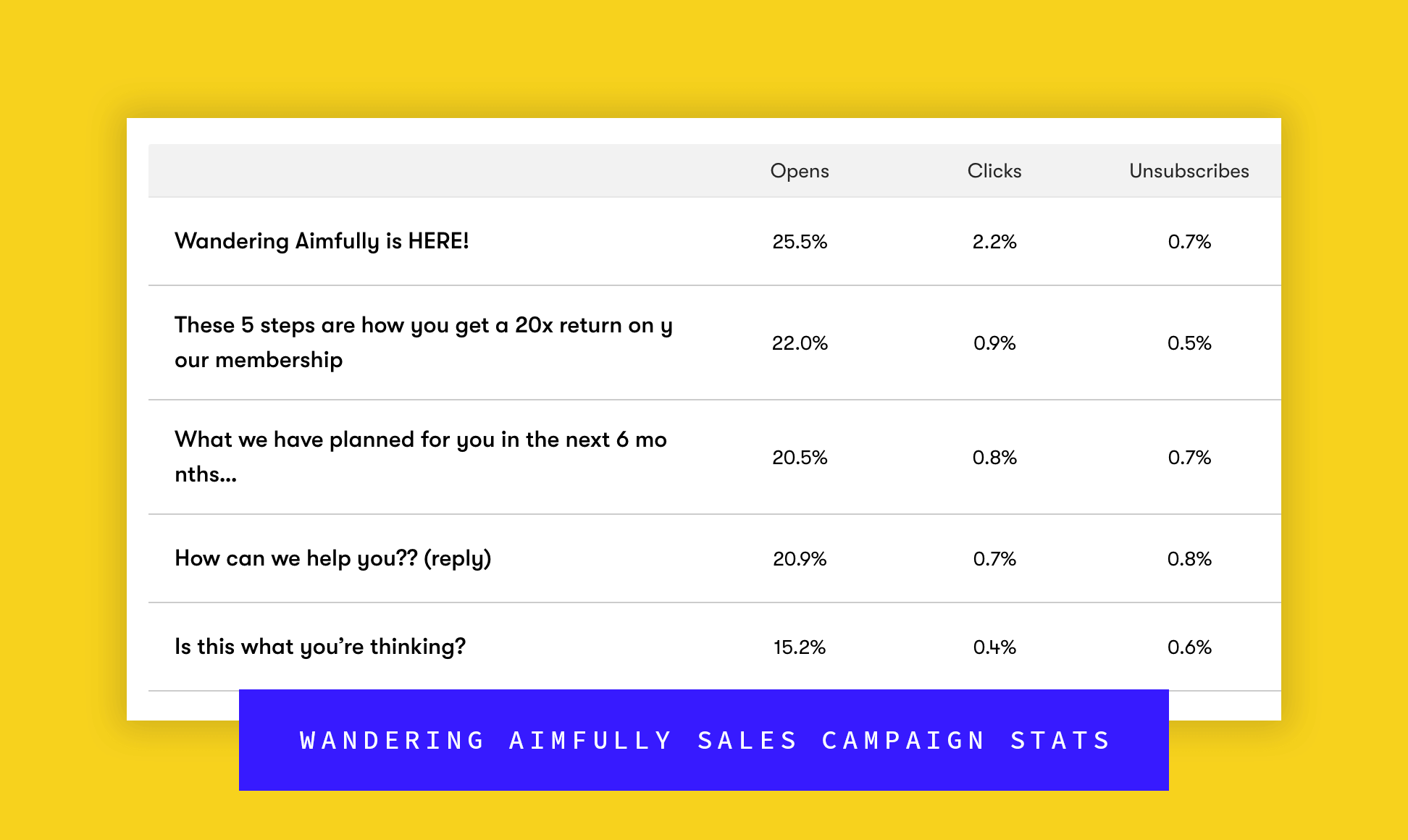
35 new customers, what happened to 30? Ahhh, you are astute! So, a couple things happened which led us to end up at 5 buyers over the 30 number we set:
With that out of the way, let’s look at when people bought during the launch:
We offer credit card or PayPal as a buying option, so here’s the split on that:
*PayPal actually wasn’t working for the first four days due to two technical issues we missed. We finally got them fixed but have no idea if we missed out on folks who wanted to purchase via PayPal. Oh well.
And finally, the traffic to WanderingAimfully.com during the launch:
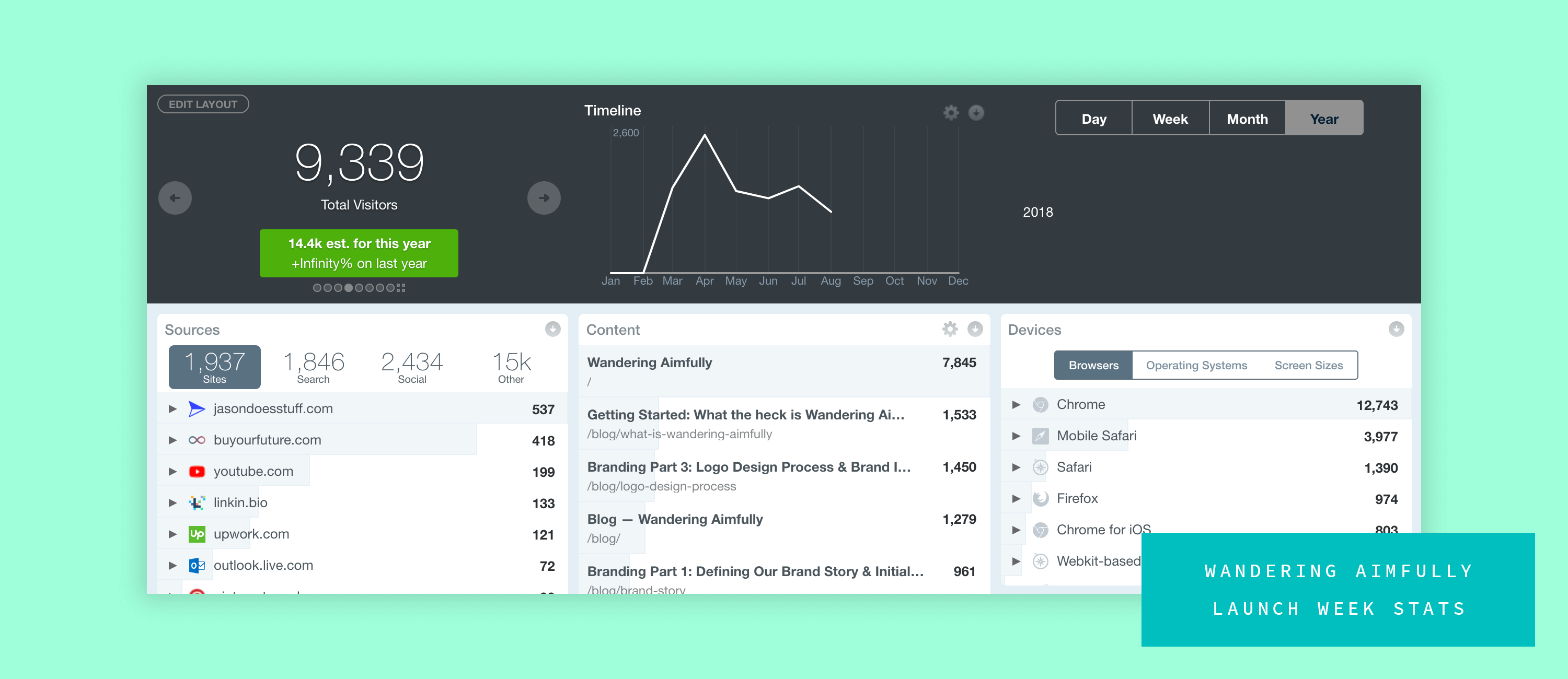
There’s no doubt in our minds that the initial launch is the most exciting time for people. It’ll be very interesting to see if we can keep up our pace of 30 new members each month going forward.
And now, the best and worst parts of our first official launch:
We can’t stress enough how excited we were to get Wandering Aimfully launched, but more importantly, to have a new group of amazingly talented and creative people in our community.
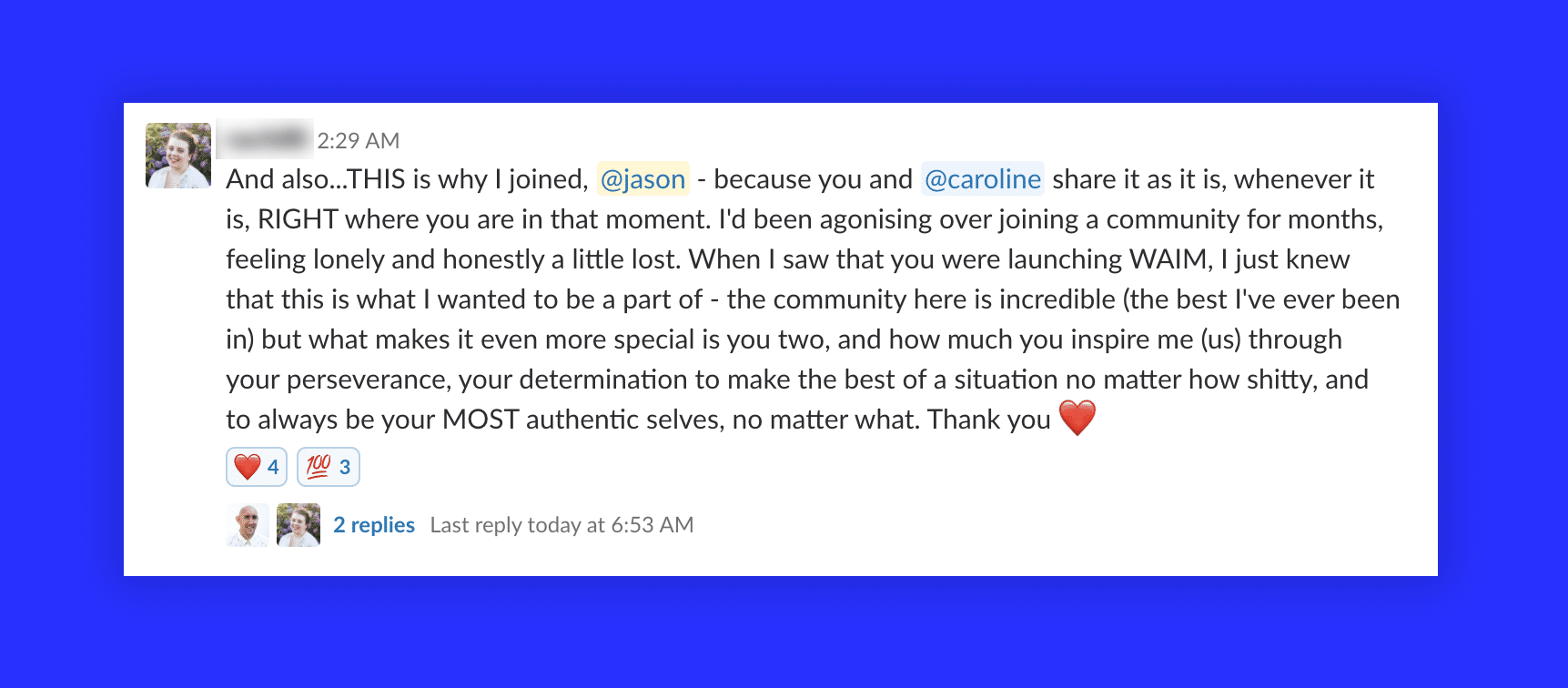
It’s hard to categorize anything as the “worst” part when things go pretty much to plan. If we had to mention something here, it would probably be how much stuff we have to do manually behind the scenes for a new customer that buys via PayPal. We won’t bore you with all the details, just know that each PayPal customer requires a bunch of manual processes that we’d love to automate in the future, but had to launch without (even though we tried to automate them months prior).
We’ll be using Baremetrics to track our member growth progress and revenue and you can actually view our public MRR dashboard here. Baremetrics is super neat because it helps you keep track of customers, revenue, churn, and lots of other powerful recurring revenue stuff.
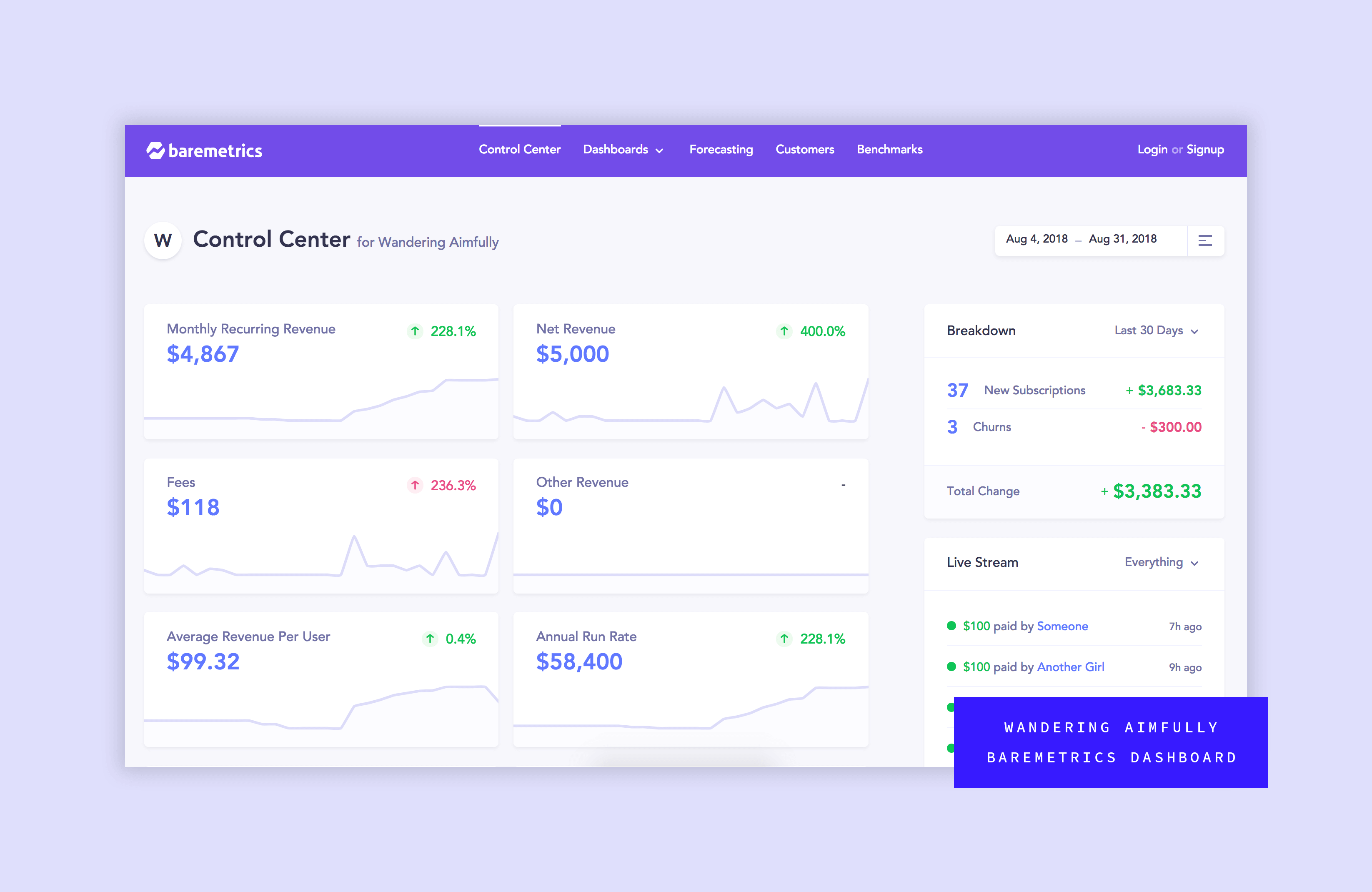
A big shout out to Josh and his team for getting us hooked up on Baremetrics and making it really easy to update our Airtable with actual monthly revenue.
**
That’ll do it for this first update! Now, it’s time to get to work on creating new stuff for our WAIM Members and executing our plans for the lead-up to our October launch.
👍👍
As of October 10, 2018:
Monthly Recurring Revenue (MRR): $6,350
Total Paying WAIM Members: 62
Monthly Profit and loss:
Total WAIM MRR: $6,350
Total WAIM Fees (Stripe/PayPal): $160
Monthly Expenses in September: -$3,496
TOTAL PROFIT: $2,854
Quick hits of what we did to get this first group of paying members:
This is our second update on our Journey to 330 and man-oh-man do I have ALLLL the thoughts to share. If you are unclear of our “growth strategy” with selling our Wandering Aimfully Memberships, the goal is to open the doors every month and only allow up to 30 new paying members. One thing that you’ll notice between the first and second update is that our assumption about our expenses was correct. We can’t live off the $2,854 in profit we made this month*, but it’s great to know that our business is not making more money than it spends (after just two months!)
*If you’re wondering how we’re keeping the lights on since we aren’t making the profit needed to cover our total living expenses, we have ongoing payments from our previous BuyOurFuture project as well as revenue from a few other online courses and software products. Truth be told, these Fall months will be tight financially and we hope we don’t have to dip into our savings!
Looking at the month of September, we had a hunch that the luster would wear off during our second launch and I’ll talk more about that in a moment. But, one really big thing happened between the first launch and our second launch and that is that life took a big steaming 💩 on our faces…
You know that phrase everyone (including us) like to throw around: “Plan ahead because life will shit on your face.” Well, it happened to us in a big way in September. My lovely and very healthy wife mentioned she had some tightness in her neck at the beginning of September and a few days later we found ourselves in an Urgent Care doctor’s office hearing that Caroline was diagnosed with shingles. Oof.

I’ll save you all the intimate details of how bad shingles can suck, but here’s the painful timeline of how it went down:
Those five weeks happened between the first launch and second launch of Wandering Aimfully and unfortunately, it left us a woman down in the work department. While I tried to carry my weight and tow the line of everything we had going on (and keeping my other business ventures afloat) I spent the majority of my time trying to give Caroline any ounce of comfort possible. It was difficult not being able to work like we normally do, but truthfully, it was an emotional few weeks for me and an insanely few painful/emotional weeks for Caroline.
I don’t want this entire update to be about our run-in with shingles, but it’s worth noting that you DO have to prepare for these life hiccups to happen. You can be mad about it, you can be frustrated about it, but you can’t just fast forward life so you hunker down and deal with it the best you can.
I’m happy to report that Caroline is feeling 1000% better than she was during week one of shingles, but she still has some lingering issues (which we’ve come to discover are normal).
Earlier on in the summer, we made the decision to create a podcast and YouTube show where we’d talk about areas of life where we’ve wandered aimfully and share our experiences, stories, and lessons learned. Originally we were going to launch the show at the time of launching the website, but Caroline had a good idea to push the launch date of the show back a month so we’d have something fun to announce after the luster of our new website announcement wore off (good idea Carol!)
I’ve had a few podcasts over the years and one of the most important things I’ve done for my sanity in running them is to get AHEAD of the publishing schedule. We still had a ton of work on our plate during the summer months, but we carved out time to record five initial episodes of Wandering Aimfully: The Show. This was a clutch move because we couldn’t record a single thing in September and it was nice to know we had five weeks of episodes already recorded and ready to be edited.
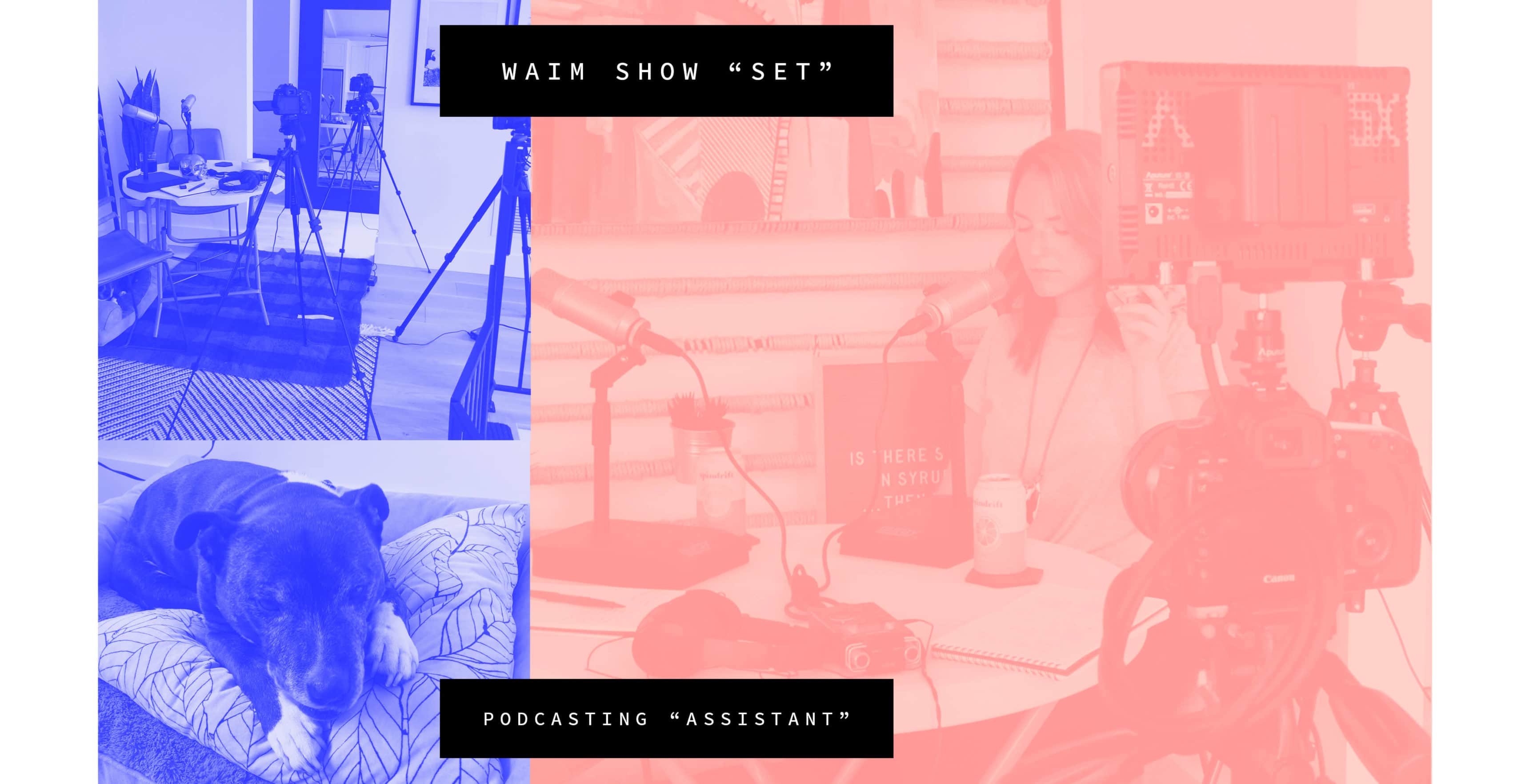
I don’t want to spend too much time on the production of our show, but just know that:
I could, and may, write an entire article devoted to our plan and strategy with our podcast/YouTube show, but the short of it is we want to create a show that we’d enjoy watching. Our assumption is that we’ll deepen the relationship with our existing audience through the show, having them (you!) feel a connection to us that you can’t get through the written word. Could we see some external growth with our show? Maybe. But that’s kind of out of our control, so we’re not focused on that.
As of writing this second launch update, we’ve released five episodes and the total views/downloads are just around the 3,000 mark. To some people, that may be great! To others, that may not seem worth the 125+ hours we’ve put in. To us, we’re committing to the show because we enjoy it and we want to see how it goes for a few months.
EDITOR’S NOTE: After reading back through this section of the update I posted a note in the Wandering Aimfully Slack channel about how much work was going into our show and not being sure if it was actually going to pay off (just some straight-up #realtalk). I heard back from many of our members that they loved the show and it was doing exactly what we intended it to do. Plus, a few newer members said the podcast pushed them over the edge to join WAIM. So… hurray testing assumptions!
As you’ve read and understood, our goal is to get 30 new paying members each time we open the WAIM Membership doors. We are not naive and we understood that there would be a natural drop-off in membership with our existing audience.

As our October launch approached we were trying to figure out the best way to sell our memberships, but not oversell it to the folks who went through our full 7-day sales sequence just a few weeks prior. Here’s what we ended up doing for our second launch.
This group was made up of new email subscribers who went through our 5-day welcome email sequence and did not get our first launch sales sequence.
We dropped these folks directly in the same 7-day sales sequence we used before:
And the most important stat of all? 8* people purchased!
*Unfortunately, we don’t have concrete data to say that our email sales sequence was the sole reason these folks purchased, but they were all in that group of 408 subscribers, so we’ll take it! Also, we’re going to try to track conversions from the 7-day sales sequence better during our next launch (always room to improve).
I’m gonna be brutally honest and just come out and say it: I’m nervous that our email provider is having email sending issues. I’ve heard from another customer of Drip that they’ve seen a huge drop in email open rates, but it’s crazy to me that we went from an average of 20-25% open rates down to 10-15% since switching to a combined newsletter with a new from email address. That’s probably a topic for an entire other discussion, but we can’t do much about it now, so… let’s move on.
We sent our existing subscriber group three emails during our second launch:
Email #1: A normal newsletter about taking risks which aligned with our podcast episode that had a callout that memberships were open at the top (14% open rate).
Email #2: A dedicated sales email three days later focusing on wins our WAIM members shared with us with a bit more of a pitch to join (13.5% open rate).
Email #3: Another normal newsletter on the last day of the launch about confidence with a reminder callout that memberships were closing (11% open rate… but this data is written one day after sending that email).
It’s safe for us to assume that 8 of our new customers came from these emails.
So, where did the other 2 customers come from? Well… They found us completely out of the blue and joined in the last few moments! No joke. I emailed with both new customers who weren’t on our list and they said they hadn’t heard of us before joining but felt a real connection to us and WAIM and decided to take the leap. Pretty cool!

Honestly? And most people would probably try to hide behind fake optimism… It sucks. It sucks to put something out into the world that you truly believe can make a difference for folks, but to not see the conversions happen.
BUT… We knew it wasn’t going to be easy to get 30 new paying members each month and we also knew that September was a really tough month for us.
If we take a step back we can see that we have 18 new (awesome) members who believe in us. We can see that we didn’t do much marketing or promotion at all, with exception to launching our show (which, as stated, is more of an audience deepening decision, not a widening one). And you know what’s better than a big fat 0? 18! There is a tinge of discomfort that we missed our 30 mark, but, we’re grateful to have new members AND our existing group who continue to stay active members.
We have a second launch under our belt after having a pretty damn rough month personally. We still ended up with new members and even though we didn’t hit our goal, we were able to test some assumptions about the groups on our email list we could sell to.
Let’s finish up with the BEST and WORST…
We got some new members! 18 is way better than 0. The quality of the members of the second group seems to be on par with the first group (which is rad!) We were also really stoked that brand new subscribers converted to paying members, which bodes well for the future of our email marketing plans.
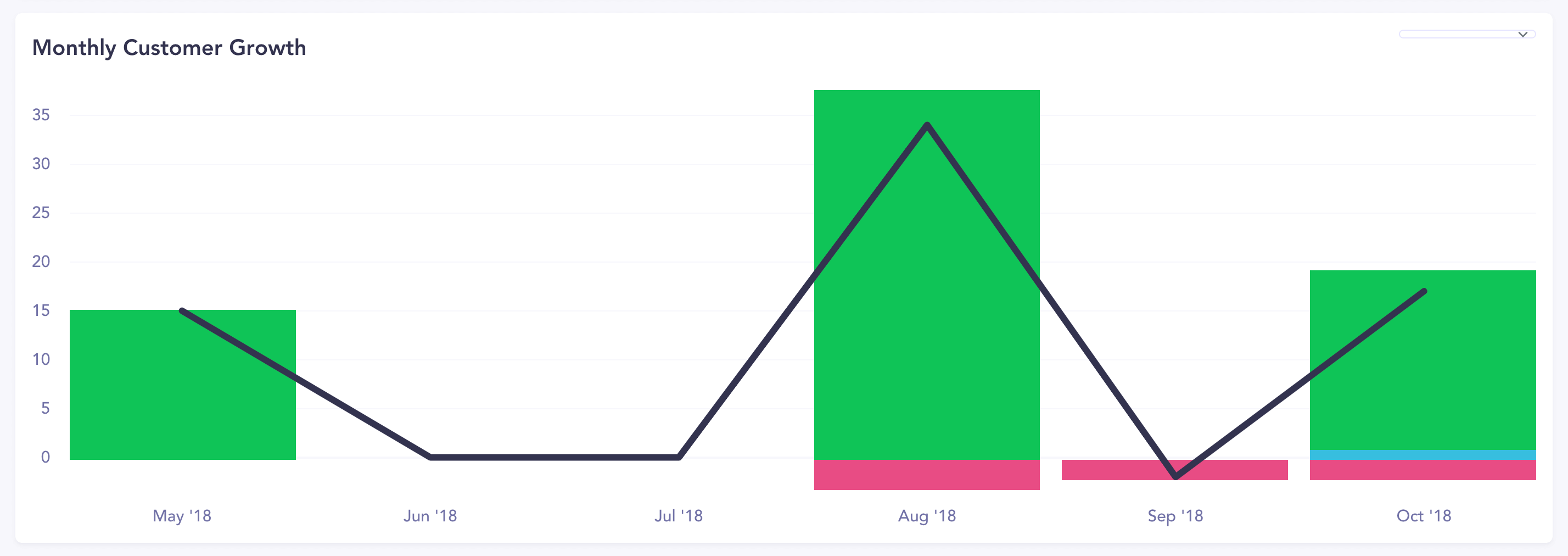
There are two things I want to share and you probably guessed the first one: Poor Caroline had to deal with shingles the entire month. It. Was. Awful. But, we made it through and she’s feeling so much better. Could’ve been worse!
The second worst part I wanted to share is that 5 customers canceled their memberships. Personally, I have some soul-searching to do on how I deal with people canceling, especially after only being a member for one month. I get it, people will cancel, it’s the name of the membership game… but that doesn’t mean it doesn’t suck and it doesn’t make me feel emotions (even though most of the time I have the emotions of a robot).

The silver lining to having people cancel is that we get to learn why they canceled. We can find ways to improve or to make our membership better. We absolutely believe WAIM is worth the $100 per month, but we also know we don’t have the best onboarding process for our new members. Hoping to spend time on this in the next few weeks!
**
Hope you enjoyed our second update on our Journey to 330! It’s as much a reminder to us as it is to you that reaching your goals isn’t going to happen overnight. It’s also not going to happen just because you hope and dream it will. You have to put in the work and you have to prepare for things to go wrong now and again.
As of November 15, 2018:
Monthly Recurring Revenue (MRR): $6,133
Total Paying WAIM Members: 62
Monthly Profit and loss:
Total WAIM MRR: $6,133
Total WAIM Fees (Stripe/PayPal): $128
Monthly Expenses in September: -$3,590
TOTAL PROFIT: $2,415
Quick hits of what we did this month:
Holy moly, where do we begin this month? Well… Let’s just go ahead and rip the band-aid off and jump right into the biggest emotional topic.
This is a very weird sentence to type, but we’re kind of glad our MRR went down. Wait, do we hate making money? Are we gluttons for punishment? Why the heck would we be happy that our MRR went down??
Here’s the deal, and it’s my belief it’s going to make total sense after you read this:
We like to see some tension. We need relatability. We need something to go wrong so we can see how the hero(es) overcome the adversity.
Now, if I’m being honest, I’d rather that drama didn’t involve how much revenue we generate, but it is what it is. The fact of the matter is that between October 10 (the end of our second launch) and November 12 (the end of our third launch) we had more people cancel than we had signup. OOF. Not great.
I’m the one who more closely watches our WAIM Memberships and it was a punch to the gut every time a cancelation email came through. All-in, we had 12 people cancel their WAIM Memberships which increased our User Churn to 16.9% (industry average is 11%).

The wise and experienced co-founder of Basecamp, Jason Fried, once said that you learn the MOST about your product right when a customer signs up or right when they cancel. When a new customer joins, ask them why and find out if there are recurring things that are attracting and converting people (and do more of that!). When a customer cancels, asks them why and try to fix that problem asap. So, that’s exactly what I’ve been doing with every WAIM Member who’s canceled.
I would have expected members who canceled to say things like: You guys aren’t as helpful as I thought or Your products aren’t what I expected or I just expected something completely different. But, we didn’t hear any of that. In fact, we’re seeing people cancel their WAIM Memberships because we have TOO MANY products. We’re hearing that folks believe in the value of WAIM, but they were overwhelmed by all the products available and not sure where to begin. And while that might seem like a good problem to have, it’s still a problem that needs fixing because it is causing people to leave.
Can I just pause for a moment and be brutally real with you… Emailing people and asking them why they canceled is humbling. It’s not fun. But, if you’re trying to build something that can last and that can make an actual impact for your customers, you have to push through the uncomfortable moments. Every time I hit send asking people why they canceled it feels crappy. But it’s necessary, and I’ll continue to do it.
I’m going to save the answer to this question until the final part of this month’s Journey to 330 update. For now, let me take a break from talking about everything that went wrong and share some stuff that went RIGHT!
One of the things Caroline and I enjoy most is teaching live workshops. Caroline is amazing at coming up with frameworks and processes that we can use ourselves and pass on to others. The live video element takes me back to my IWearYourShirt days where I hosted a 1-hour live video show daily for nearly 5 years straight (yeah, you read that right!) There’s something about the energy of speaking to people live and getting immediate feedback that lights us both up.

This workshop was initially supposed to happen during our second launch but with Caroline still not feeling great we had to postpone it a bit. Instead, we held the workshop on October 18 and had 232 people register. Of those 232 people, 139 showed up to the event which is a whopping 61.5% attendance rate (that’s RAD!)

We didn’t have anything to sell on the workshop, so it was just 100% value-driven. That being said, we did have two people email us after the workshop who thanked us and said they would be joining WAIM because the workshop was so great (and they both stuck to their word and signed up during our November launch – wahoo!).
For a while, we’ve wanted to have WAIM Member co-hosted workshops as there are some really talented and smart people in our community. One member, in particular, has been an all-star since joining what WAIM was previously known as: BuyMyFuture.
That member is Brendan Hufford and he’s been an incredibly valuable community member. Brendan lives, eats, and breaths SEO, so whenever someone has a question in our community Slack channel, Brendan is all over it (or if I beat him to read it, I’ll tag him and then he’ll reply).
Through a few random DM convos, Brendan and I decided it was time to do a basic SEO workshop as well as share a really nice Custom Google Analytics Dashboard that’s perfect for content creators.
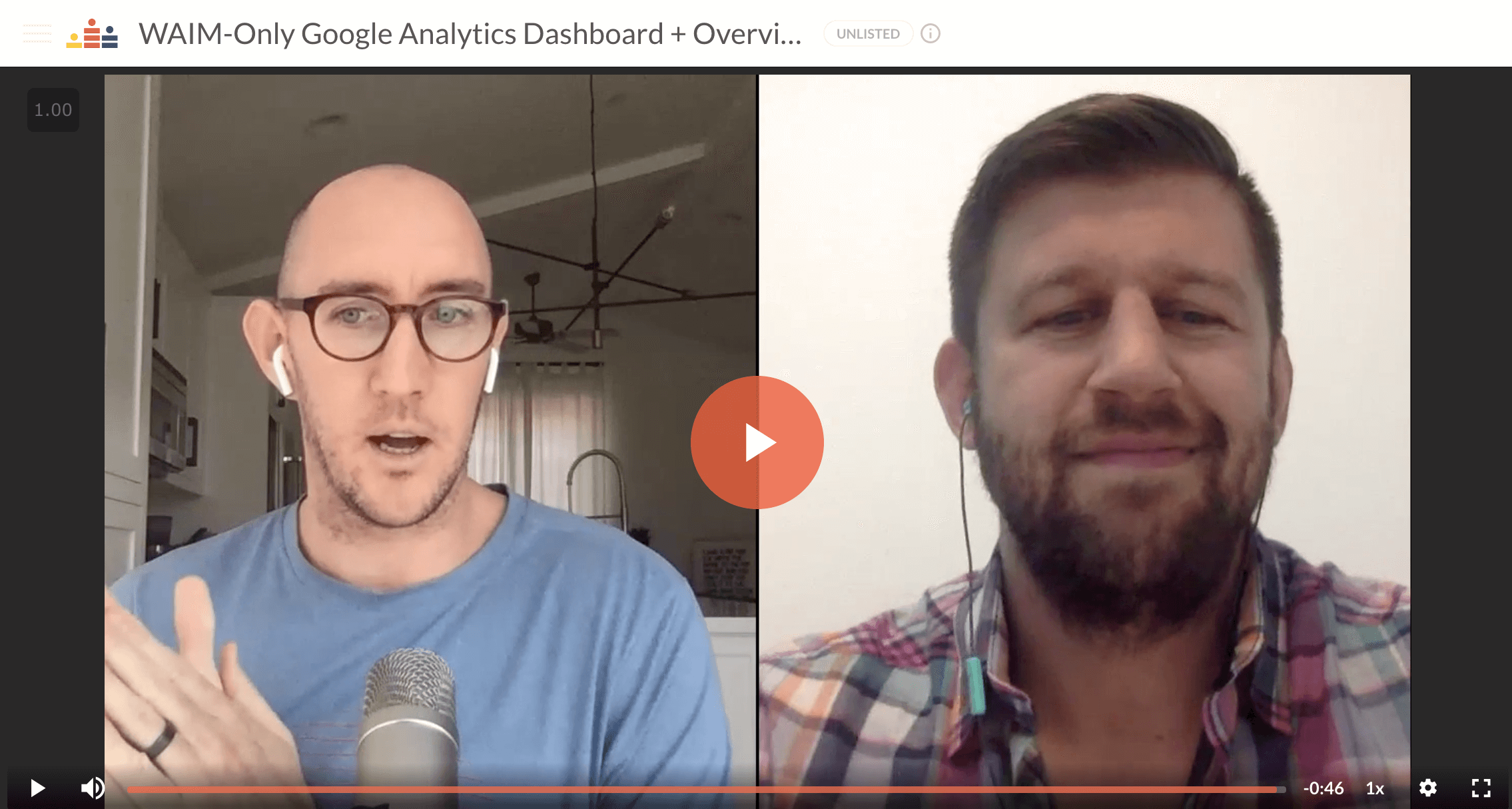
This workshop was for a much smaller audience, just our paying WAIM Members, but I was still stoked we had 83 people register (20% of our total community) and a 55% show-up rate. Even better than that, the comments at the end of the live workshop and afterward were incredibly positive (it helps that Brendan was a teacher in his former life, so he’s great at hosting and keeping people engaged!)
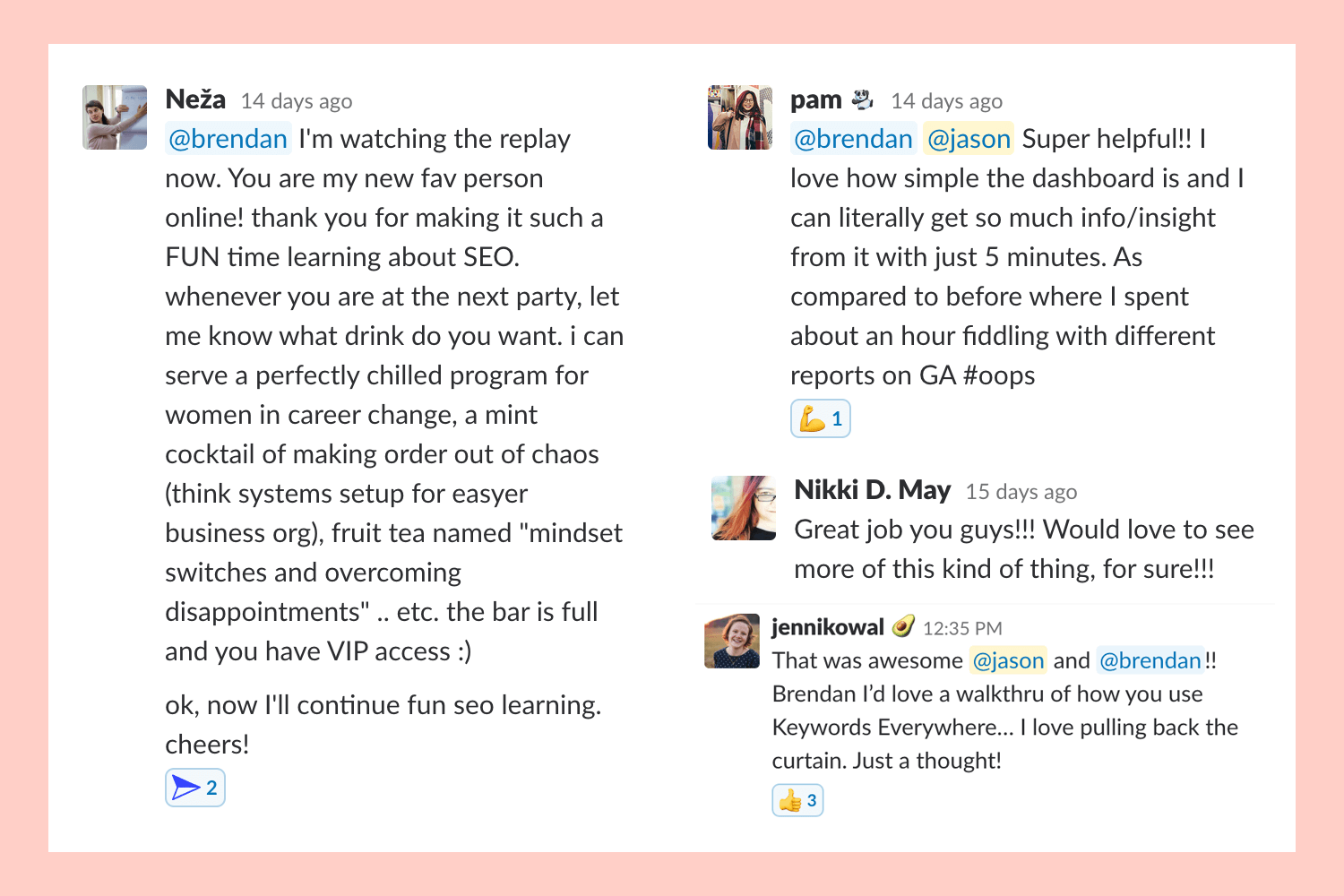
Truth be told, we didn’t plan to do this workshop when we started our third launch of WAIM Memberships. However, because we missed doing a workshop during October’s launch, we decided to squeeze this one in and do it during the final day of our 1-week launch window.
We had 193 people register for the workshop and another great show-up rate (56.5%). I believe we had people attend from 25 countries around the world for this one, which is really neat!
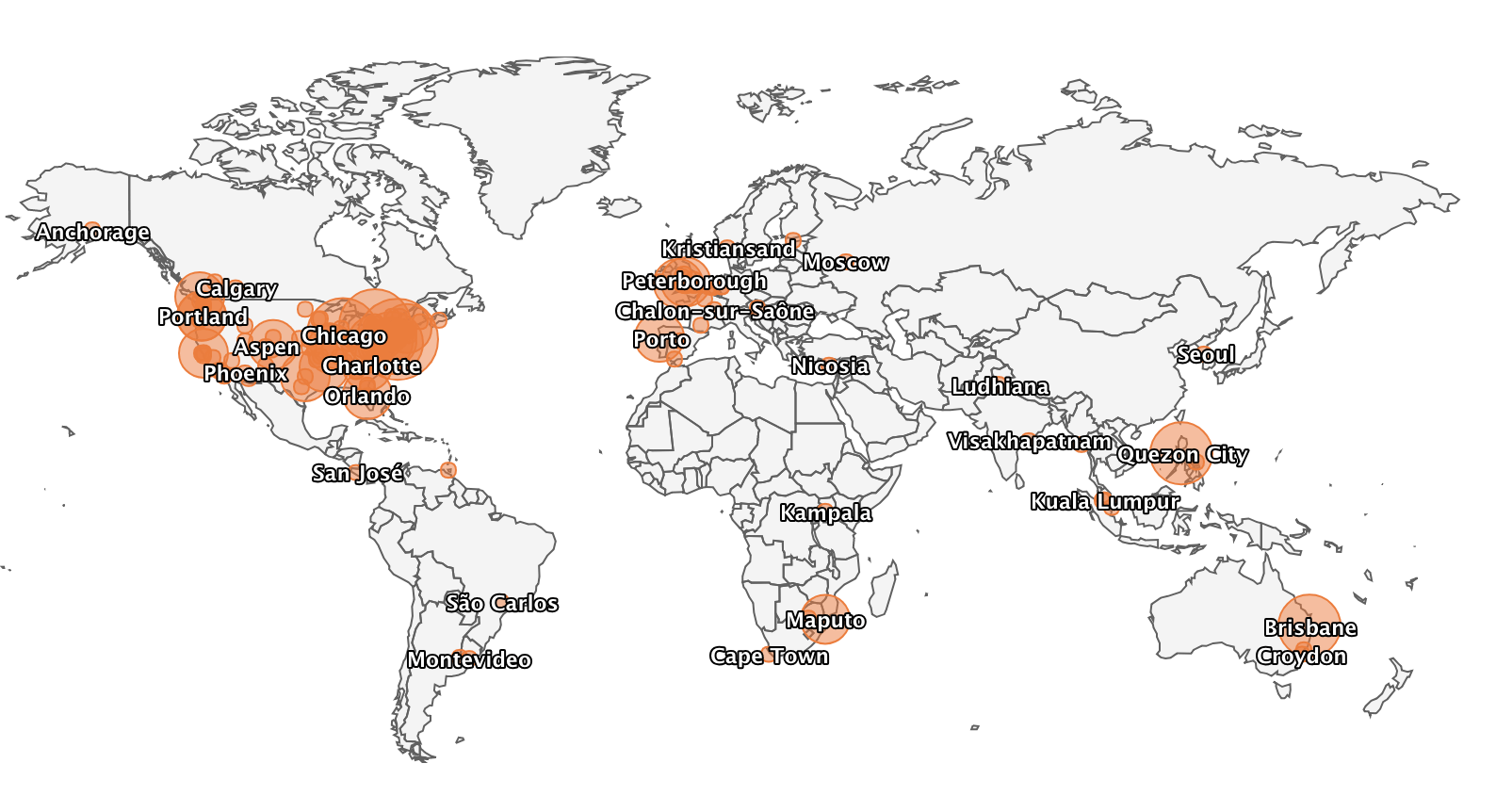
The big experiment for this workshop was to have a sales pitch for WAIM Memberships at the end. The workshop itself was approximately 45 minutes of teaching and 15 minutes of selling. We unveiled a new plan in the works, which again I’ll get to in a moment. Here’s what the sales slides looked like:
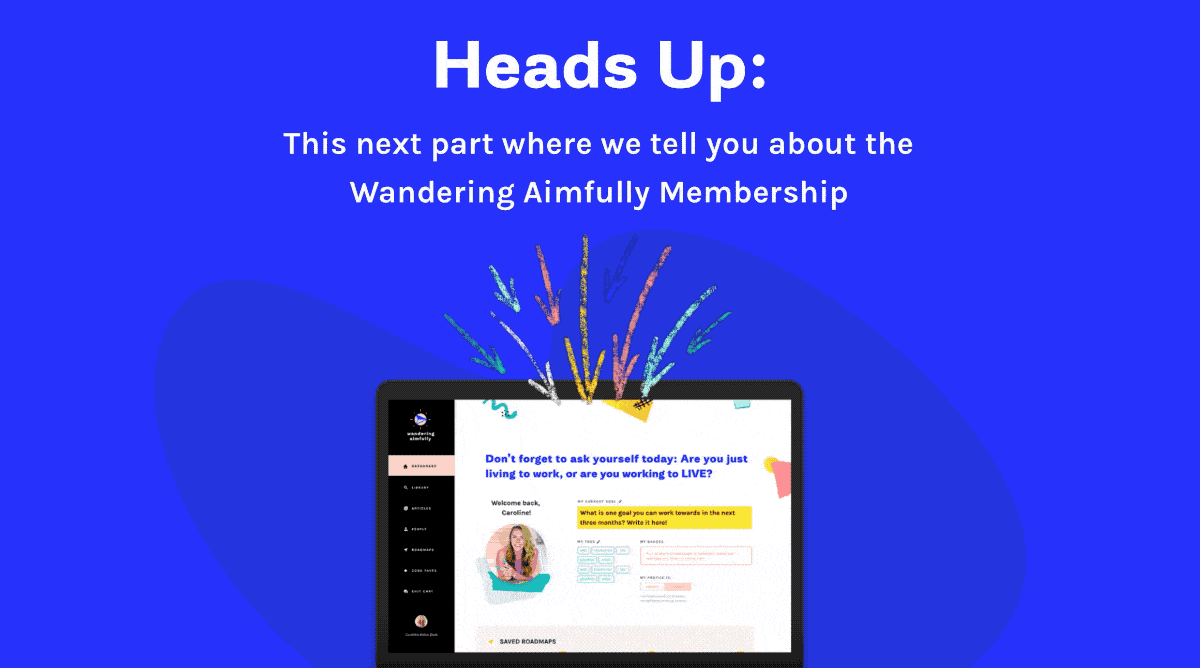
We’re not new to selling on live workshops, especially me. That’s actually something I got really comfortable doing 2013-2015. You can imagine my surprise when we had… drumroll… zero sales. Not a single person bought during the workshop and only one person bought when we sent out a follow-up reminder email that the doors were closing for WAIM Memberships.
Which, leads us to two final updates this month…
This is part of the discussion about members canceling due to feeling overwhelmed. While we can solve many problems with the 30+ products we provide in WAIM, it’s too much to choose from and feels like we’re not addressing a bigger problem we can solve for people.
As we’ve watched our membership join rates decline from August (first launch), October (second launch), to November (third launch), it’s apparent to us that something is missing the mark. That something is what we’re going to hunker down and focus on next.
Sometimes you don’t have a crystal clear change to make in your business when things aren’t going exactly as you want them to go. It would be an entirely different story if people were canceling our membership and saying, The courses are crap, The other members aren’t around, and You guys aren’t who I thought you were. Thankfully, NO ONE is saying those things (at least not to our faces or email inboxes – haha). But if people were saying those things, we’d have an idea of exactly what to fix. Instead, we’re making a best guess based on what our gut is telling us.
We’re going to create a new 6-month program that’s laser-focused on solving a big problem for a specific type of person and focus the entire membership around that core program.
You may have caught a glimpse of this in the sales slides I included a GIF of a few paragraphs ago, but this is where we’re taking a big leap of faith. We’ve known from the beginning that what you get with WAIM is a bit too generic. We’ve always loved that our resources can help people at different parts of their business journey (not started, beginning, intermediate) and that what we teach can apply to different types of businesses (products and service-based business) BUT just because your product can do something doesn’t mean that’s how you should market it. Trying to solve everyone’s problems at once makes for some pretty diluted marketing. Our selling proposition doesn’t speak enough to a specific problem that people have or can clearly articulate. That’s a recipe for disaster when it comes to selling anything. I believe we got as far as we did with this generic approach only because we’ve worked so hard at building trust over the past few years.
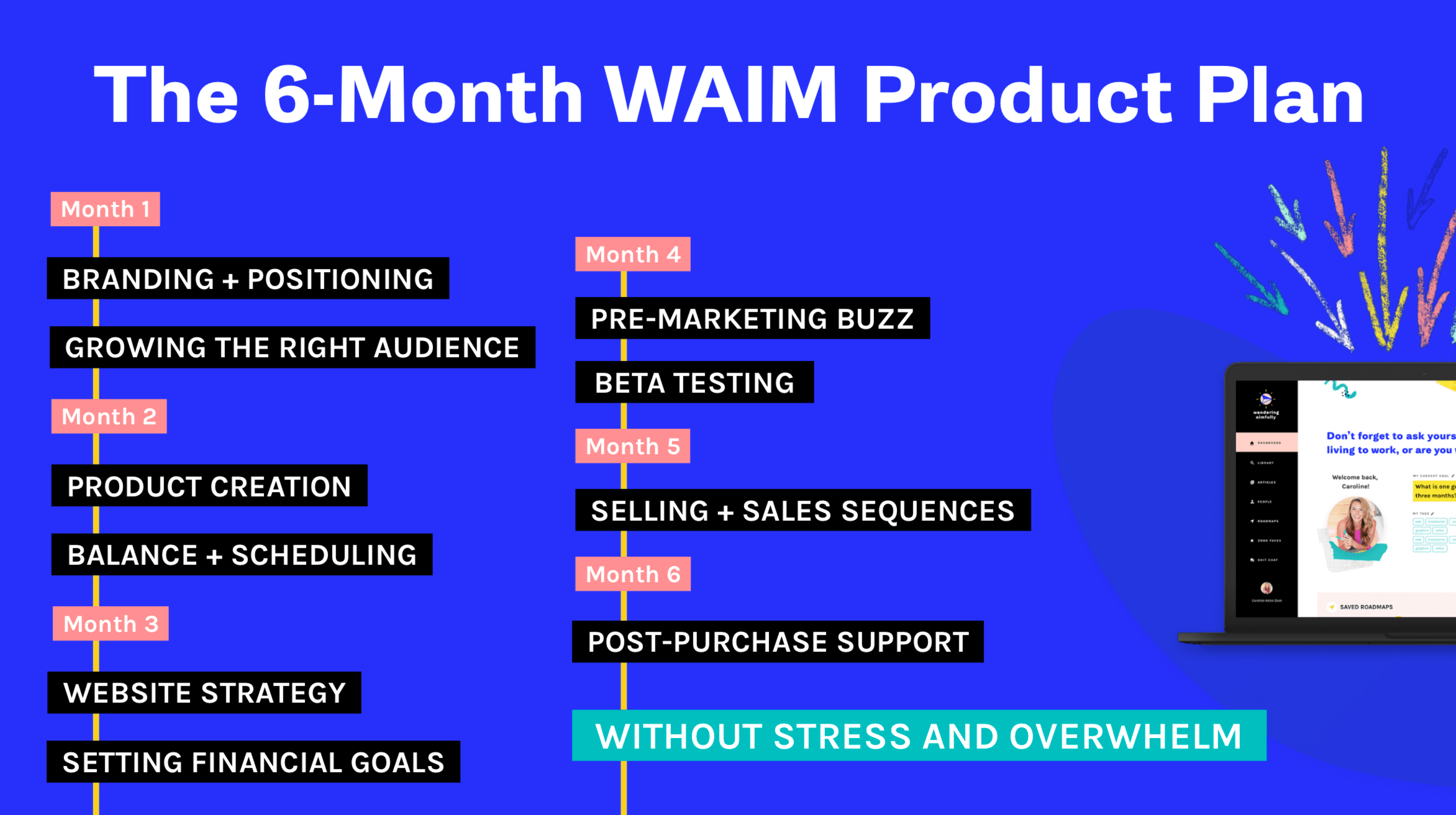
Going forward, we want to focus on this singular pain-point:
Wandering Aimfully is the membership community that teaches you how to turn your creative skills into a profitable digital product business, without sacrificing your lifestyle in the process.
To accomplish that, we’re creating a 6-month program that’s the MAIN focus when people join WAIM. They can get everything else (all 30+ previous products) but we’ll position that stuff as “in the vault.” While we’d love to rest on our laurels and believe all our previously created content is good enough to solve problems for people, we know we can do better. We know we’ve learned a ton and that we want to give a more concise and updated plan of action for our members to follow.
One of the core tenants of this 6-month program is giving you a framework to follow that helps you avoid burnout. Unfortunately, we don’t have the luxury (read: cash flow) to take the next 6 months to build this program. Instead, we’re going to have to reduce any other tasks or commitments and hunker down to build something great, free from other distractions.
Should be run, right? Well, we’re nothing if not up for putting in the work it takes to succeed. We will absolutely do our best to stay balanced and not overwork ourselves. (Definitely no intention of going shingles Round 2 in this house!)
It would be easy to sum up the past month as a “bad” month due to a smaller launch and higher rate of member cancelations, but it wasn’t bad. Caroline’s health improved. Our existing members are happy, excited, and getting value from what we’re doing. We are making a difference for people, providing value to them, and enjoying most of the process.
We realized that we need even more clarity and focus around what WAIM can provide its members, what specific problem it can solve, and who it would be a great fit for.
And of course, the fact that we did get some new paying members was great!
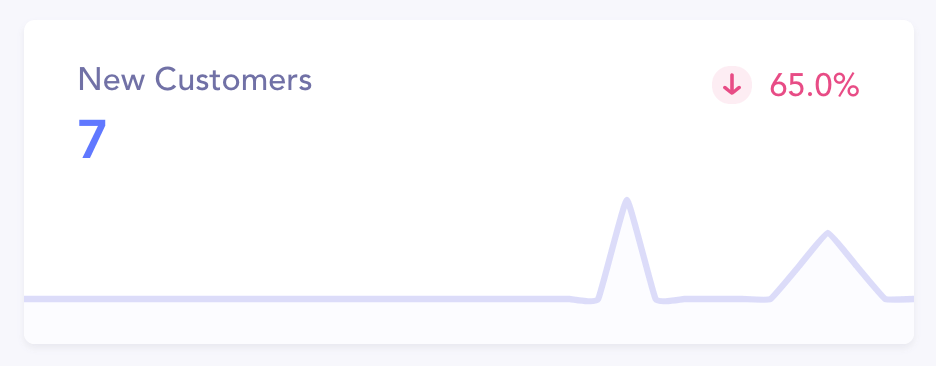
Watching 12 people cancel their memberships between the second and third launch. As helpful as learning from the cancelations is (and it may end up being the catalyst that helped propel us toward our Journey to 330 goal faster), it was a punch to the nether-regions this month.
**
Phew, what an update! We really hope you enjoy these. It’s the exact type of content we love, especially when things aren’t going perfectly so you can see how people overcome adversity (it just kind of sucks to be the ones having the adversity!)
As of January 30, 2019:
Monthly Recurring Revenue (MRR): $6,917
Total Paying WAIM Members: 73
Monthly Profit and loss:
Total WAIM MRR: $6,917
Total WAIM Fees (Stripe/PayPal): $342
Monthly Expenses in September: -$2,963
TOTAL PROFIT: $3,639
Quick hits of what we did this month:
There is a tonnnnn to get caught up on but we’ll start with the unfortunate part of this update…
The holiday season was a blur and the new year started off on a great foot for her, but then it all came to a screeching halt in early January.
Instead of hiding her anxiety, we shared what Caroline was going through with our WAIM Members and on social media and the response was amazing. We can’t thank you enough if you sent kind words and thoughts our way.
While we were still able to do our January WAIM membership launch, we decided that we would push back the start date of our new program Build Without Burnout Academy and remove every work item from Caroline’s plate. We’re hoping a month of rest and easing back into just a little bit of work each day is what Caroline needs. She’s also trying everything under the sun to fight her anxiety (meditation, CBD, relaxing teas, extra sleep, therapy, and anything else folks have sent us or she’s read about).
With shingles hitting Caroline just a few months ago we are certainly trying to listen to the universe telling her that something isn’t quite right.
We’re doing our best to create space and avoid any stressors at the moment.
We teased this in the previous update, a 6-month program around a more specific problem and target audience.
We’ve had many conversations about WHO our membership is for and WHAT problem we’re specifically solving based on our experience. We knew the initial positioning of our membership was vague but we simply had to start somewhere (and hey, it did work and attracted over 60 paying customers!)
That being said, one of the things we always talk about when people ask us for advice is to niche down and get as focused as you can. We took our own advice and had multiple conversations about what that meant for us and WAIM.
We have A LOT to say on this topic. We also have tons of tangible and practical advice we can give because we have firsthand experience and lessons learned (always a good sign!)
One of the first things we did was to rewrite the mission statement for our WAIM Membership…
Previous version: The essential membership community for independent creatives who want to earn more so they can live more.
New version: The membership community that helps client-based business owners transition into selling digital products—without burning out in the process.
I mean, yeah, pretty damn clear that we were talking to an extremely broad group of people with our previous version.
With this renewed focus of WHO our membership was for, we knew we hadn’t created a product within the membership that spoke directly to that audience and could help them (the WHAT). This is where our Build Without Burnout Academy product comes in!
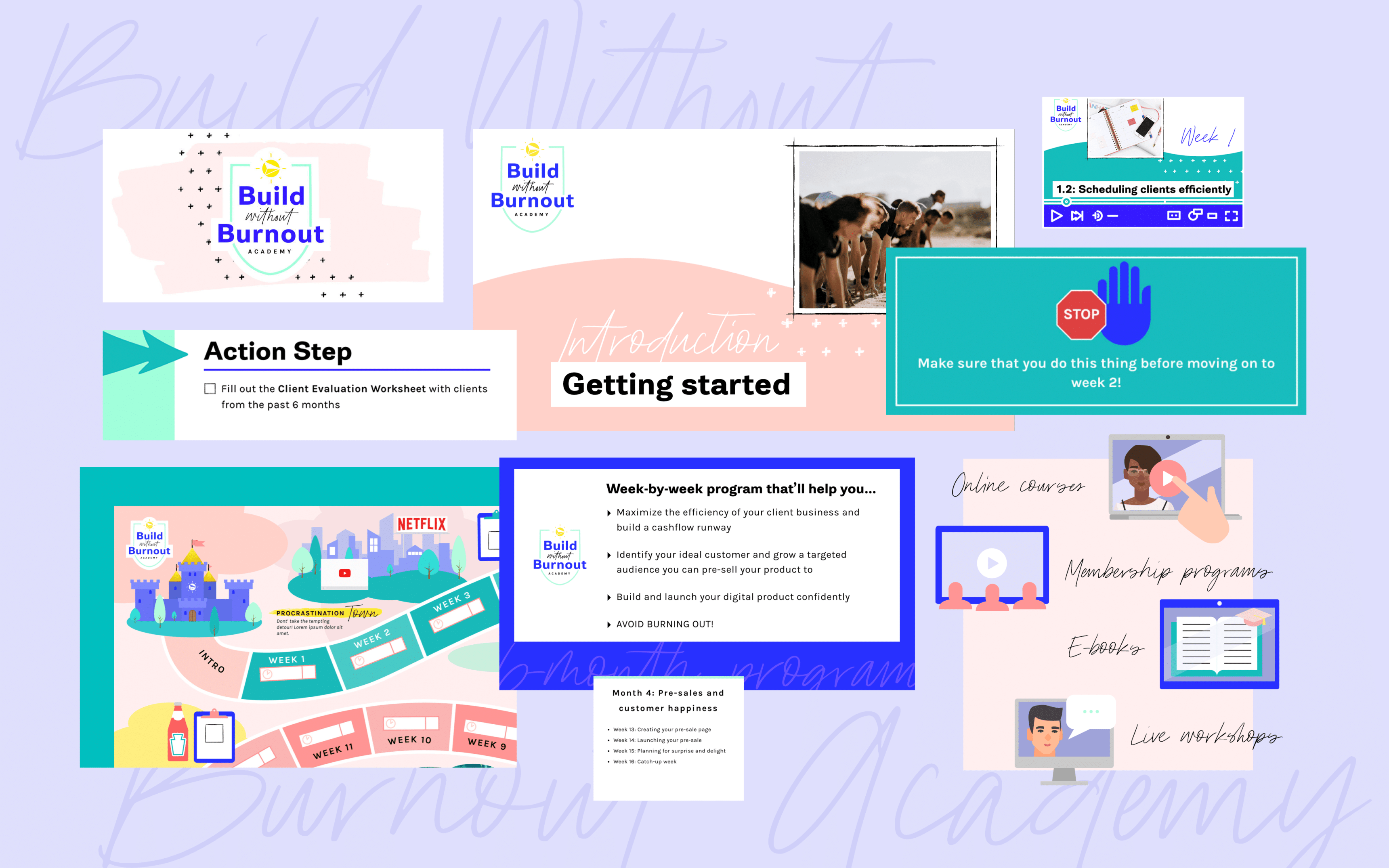
We had many conversations and planning sessions about Build Without Burnout Academy. There were a few key components it had to have:
But the main component was that we’d have a brand new program to add to the WAIM Membership that would hopefully speak more directly to our target customer (and add value to the membership!)
We looooved how it all came together. Caroline did a wonderful job branding the experience, from the program curriculum, slide design, the experience within Teachery our members will go through, and the amazingly fun game board game element that accompanies the educational content.
We wanted to kick things off January 29 and have all our existing WAIM Members and new members from our January launch start together on their 6-month journey. With Caroline getting hit with anxiety we had to make the tough call to push the start date back to March 4. It wasn’t that we needed one more week to finish things, it’s that we care more about Caroline feeling normal so she can give her whole self to our members (and you know, feel normal!)
If we need to push the start date back again, we’ll cross that bridge when we get there. We’re taking it day by day and our members have been amazing about it.
Originally, our plan was to do a launch in December, but we decided to nix it due to the workload we had for Build Without Burnout Academy creation and our holiday travel schedule.
The January launch was the first one to our full email list since October. We felt comfortable it was enough time removed, plus, with the new mission statement and focus on Build Without Burnout Academy there was reason to share it with our full group of email subscribers.

As you can see we’re still dealing with churn and had 15 members cancel between our last launch (November 15) and the end of our January launch.
We’re not assuming churn is going to disappear but we’re hopeful that our new 6-month guided program helps our members see this is a commitment for longer than they may have previously. That’s the hypothesis we’re going to test.
It’s awesome that we’ve had 100+ people sign up! It’s not so awesome that nearly 30% of them have canceled. Then again, even with industry standard churn being 7-15%, maybe 30% isn’t so bad given that our membership doors have been open for nine months (including our pre-sale in May 2018)?
This is incredibly interesting to us because it shows that the personal touch and direct communication goes a long way in making the sale.
This was also a very interesting realization as it showed us that we may have been using the wrong sales tactics the past few months. We’ve been applying our sales knowledge from digital product launches and we’re not selling a digital product anymore, we’re selling a monthly membership.
It’s clear to us that there’s a lot more trust needed for someone to make the purchase with a membership.
I shared a few tweets when this thought occurred to me (copying + pasting our online course sales to our membership sales process) and Amy Hoy jumped in to back me up:
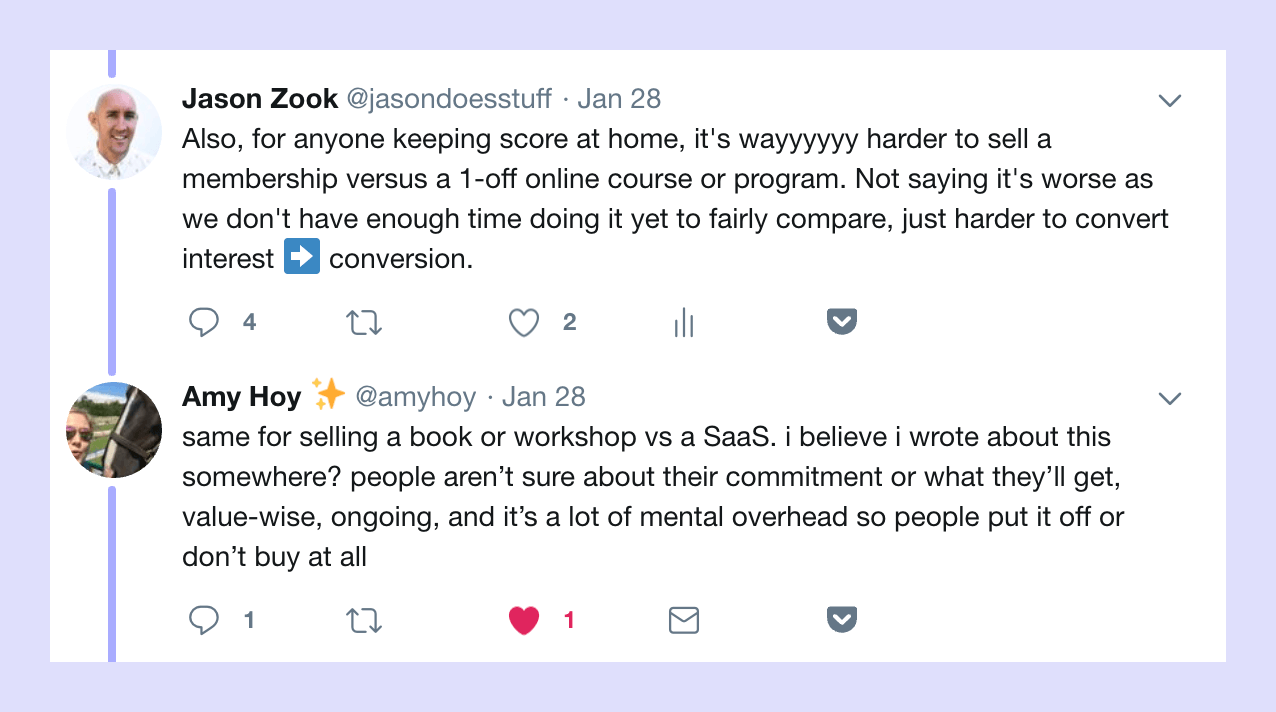
So…. How do we move forward with our sales process?
Realizing that I’ve had some sort of direct interaction with our last 40 customers, and I didn’t hate doing it (important!), is a clear indicator that we should try a more hands-on sales approach. If I’m already emailing with folks during our monthly launches, why not just remove the work that goes into the monthly launch model and put it into something that’s more personalized and possibly takes the same amount of effort on my part (but makes the customer feel better)?
Quite simply I’m going to create an online course that uses the lessons to preview different aspects of the WAIM Membership. Each lesson will have a short video and we’re going to highlight these items as “lessons”:
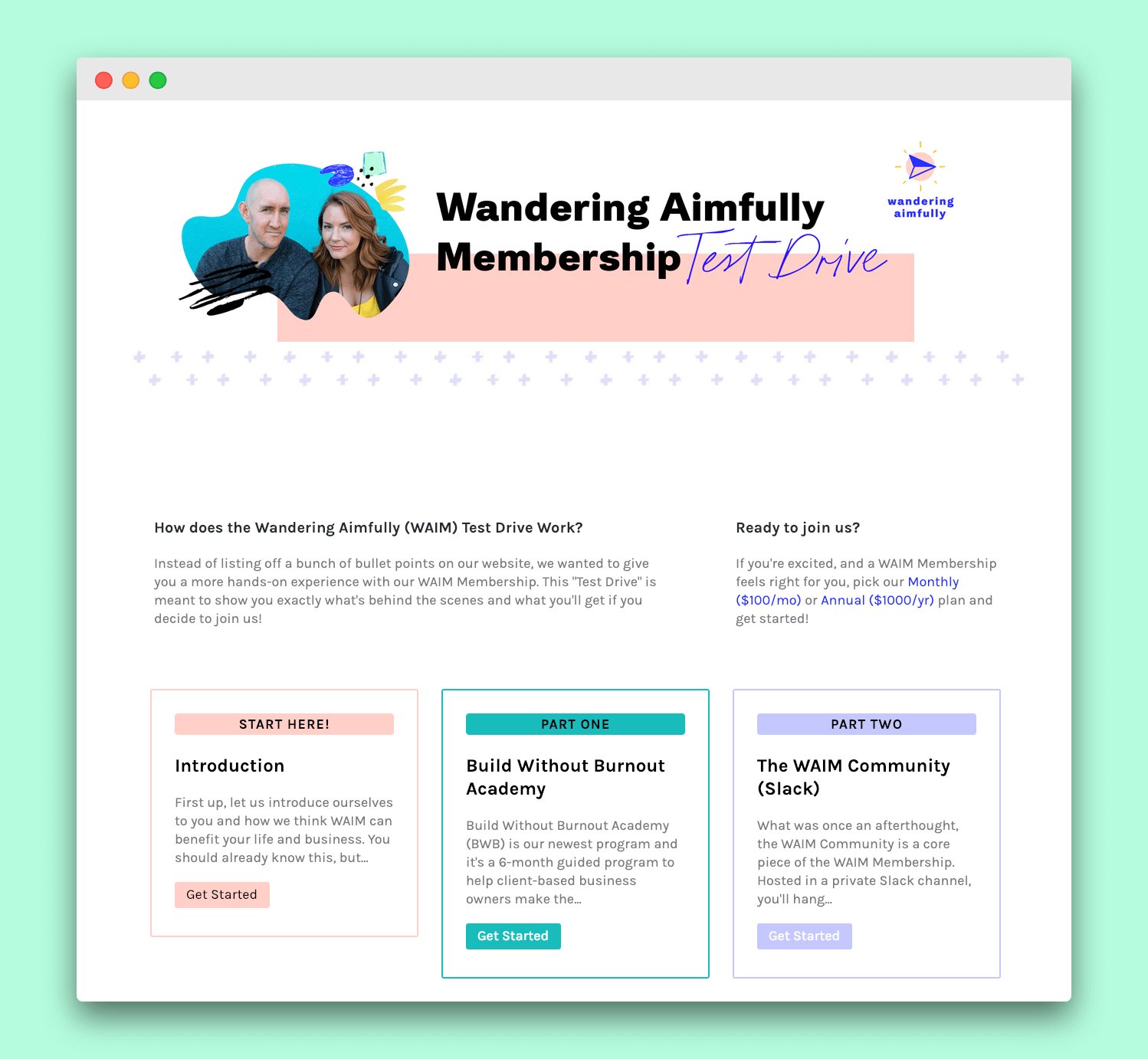
The final “lesson” in the test drive experience will be a sales pitch to join. Essentially, our membership doors will be open ongoing, but you won’t know that unless you take the test drive AND you make it through a few lessons (read: you show interest and go through the content!)
One note about the sales pitch lesson: There’s no sense of urgency or countdown timer since the test drive is simply just open all the time. My thought is to be 100% honest about that and point it out. Hopefully that directness will be a replacement for the missing timer or BUY NOW OR ELSE copy. We’ll see.
Seems pretty simple, yeah? My goal is to keep the test drive process as frictionless as possible but make sure someone has to enter their email in some way to get access to the test drive content (hence the entire point of this, having direct communication).
This doesn’t scare me. It’s also not something I plan on doing long-term. I’m looking at it as an experiment and if it’s too many people and none are converting, I’ll stop.
However, we want to see if the test drive experience and the personal email outreach helps us convert new members. Again, I’ve basically been doing this during our monthly launches already, so instead of cramming all my effort into one week per month, it’s spreading that workload out based on the schedule of people who sign up and show some interest.
Our goal is to get the WAIM Test Drive up and running in the next few weeks. Even if Caroline isn’t feeling up to recording any video, I can have some fun with that and record solo. As with everything, just get started even if it’s imperfectly.
Note: I’m also going to be taking a social media detox for the month of February which will immediately free up the extra time that will go into creating the Test Drive and doing direct outreach throughout the month.
Like anyone else, we’re doing our best to keep things moving along. The most important thing for us is to have Caroline recover and get back to feeling normal.
I’m going to skip the BEST and WORST part of the recap because this update is already reaaaaally long and in-depth. Plus, instead of thinking about what we don’t have yet in regards to our goal, let’s zoom the lens out and see what we do have…

We’re super appreciative that you take the time to read these updates and hope they help you on your journey to your own version of “enough.”
Have anything you wish we’d talk about? Want to give us feedback? Shoot us an email and let us know.
As of March 30, 2019:
Monthly Recurring Revenue (MRR): $8,917
Total Paying WAIM Members: 97
Monthly Profit and loss:
Total WAIM MRR: $8,917
Total WAIM Fees (Stripe/PayPal): $400
Monthly Expenses in September: -$3,625
TOTAL PROFIT: $4,892
Quick hits of what we did this month:
Let’s start this fifth update off with the huge win of the past two months. We knew our monthly launch model (what we started with back in August) was an experiment in itself. We didn’t know how it was going to work out and fortunately, it did have positive results, just not quite as positive as we needed to reach our enough number in a timely manner.
We didn’t have a second way of selling WAIM Memberships in mind when we started the monthly launch model. We had that experiment and said we’d give it around 6 months and then pivot from there.
Our previous monthly launch model was converting at .05% (through monthly email sales campaigns).
Our new model for selling WAIM is currently converting at 6%!
What did we come up with to improve our sales conversion? I touched on it the previous update, enter the WAIM Test Drive (this is the introduction video)…
In late January I had a small epiphany, I went through our WAIM customer list and realized I’d emailed back in forth with ALL 40 of our most recent members. Yes… 40! At least one email back and forth before they purchased. Hmm, okay, now what to do with that data point?
The WAIM Test Drive would try to encourage 1-on-1 communication with folks interested in WAIM. If I could up the percentage of people coming to the WAIM website to start a conversation, the odds seemed to be in our favor they’d become a paying member.
You can think of the WAIM Test Drive as a simple online course where the lessons act as sections to further explain a WAIM Membership. This allowed us the ability to showcase the most important sections of the WAIM Membership and give a bit more detail than we could on a sales page (along with a more personal touch).
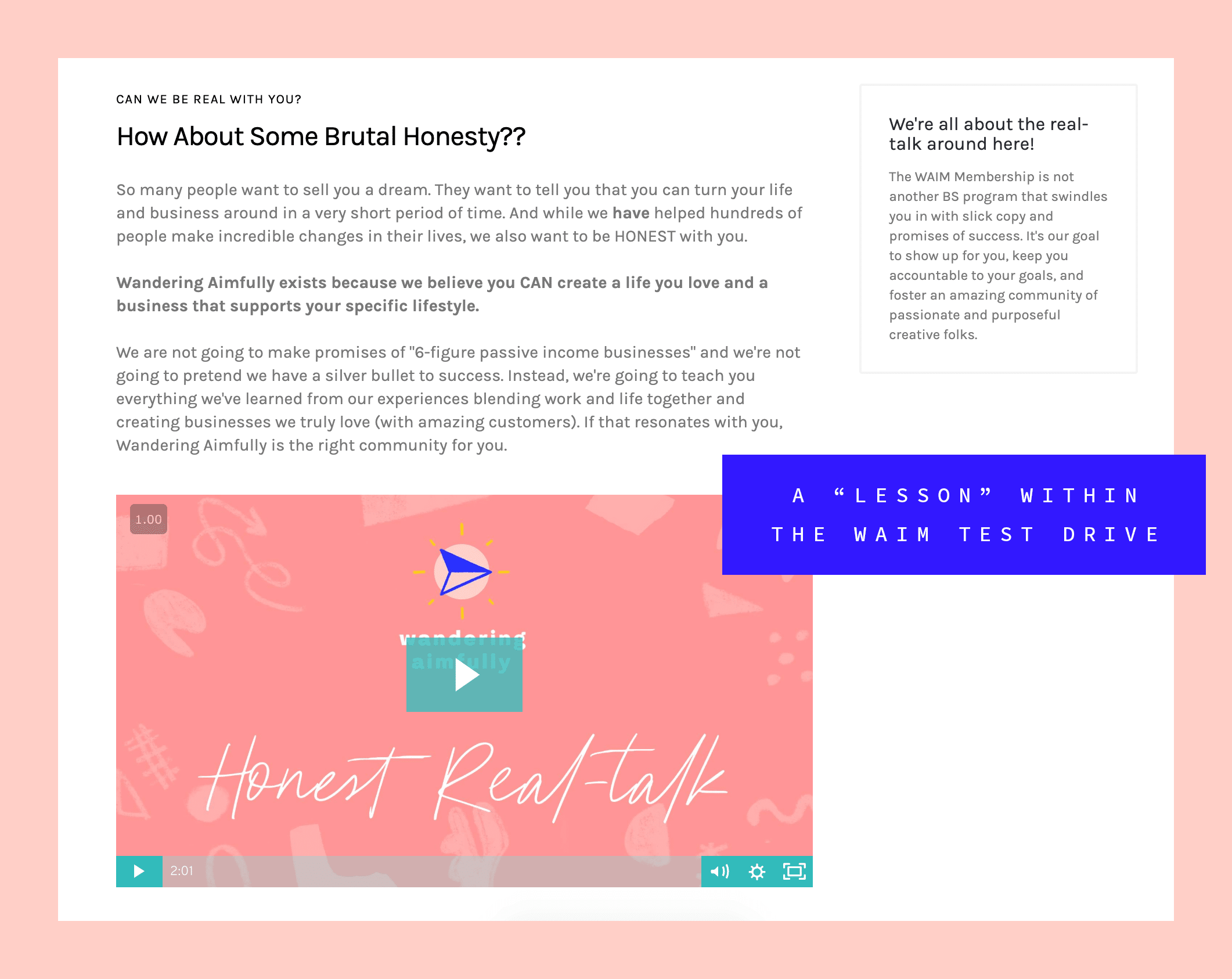
The WAIM Test Drive includes 9 “lessons” and each one shares a different part of the membership (the one above is where we speak honestly about WAIM and how we’re not “6-fig launch” people).
Our assumption was that if someone was interested enough to sign up for the test drive, they would be more likely to watch a few videos and see what’s behind the proverbial curtain.
The only automated part of the WAIM Test Drive when it started was that someone signed up for it and could see the content right away (thanks to it being built on my online course platform Teachery). The rest, I handled manually:
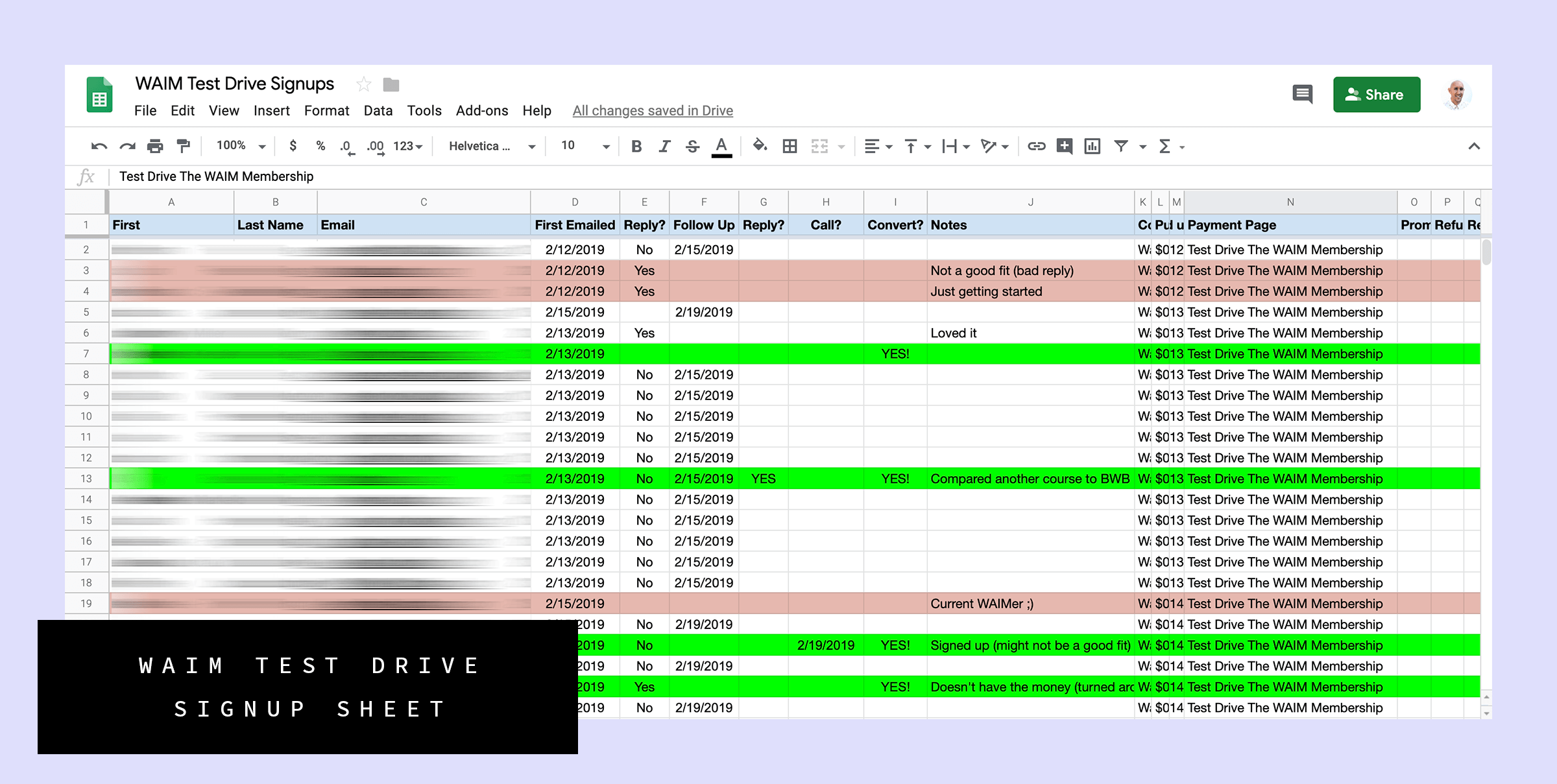
Now, reading those bullets you might be wondering why I didn’t automate that process right away? It seems fairly simple, yeah?
The short answer is: Yes, I absolutely could’ve automated it. But…
The longer answer is: I wanted to do things manually in the beginning to test a few assumptions about the test drive itself. To see if it actually worked before taking the time to automate it.
Does that sound familiar to you? So many of us in the online biz world are guilty of trying to automate and create passive income before it’s actually viable.
Yep, that meant manually emailing 107 people an average of 3 emails (300+ total emails), before getting a good idea of what messaging and points of emphasis resonated (or at the very least got a response).
Out of those 300+ emails, I quickly learned what subject lines people responded to best, what email content they replied to most, and what stuff people blatantly seemed to ignore.

From there, once I started to get consistent email replies and feeling like I was weeding out people who were just kicking the tires and would never buy, I knew I could move to a more automated workflow that was fairly simple. It ended up looking like this:
It’s been a consistent 6% conversion rate from test drive signups to paying customers for just over a month as of writing this update. I still end up emailing with almost every person who purchases but overall it’s a way more automated system (and I truthfully don’t mind emailing with folks!)
Bonus: A little unforeseen bonus to the WAIM Test Drive is that it nearly doubled our email signups each month. That’ll come in handy when we do bi-annual WAIM Membership launches (more on that in the next update).
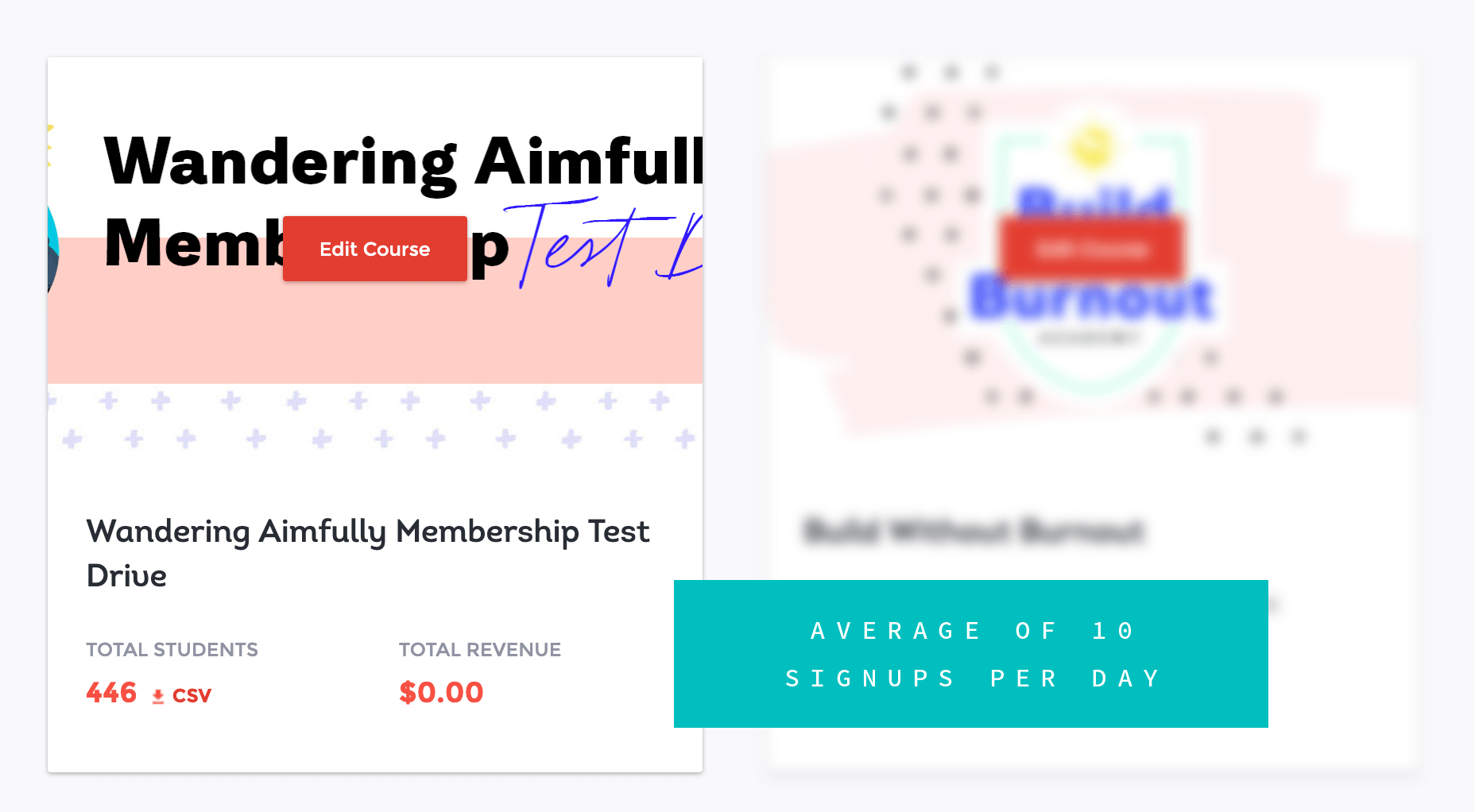
(You’ll notice the “total students” number is 446 and the difference between 412 and 466 is a bunch of spammers or WAIM members checking out the test drive.)
This was a pretty big decision to make because it drastically affects the ongoing MRR business model we’re creating with WAIM.
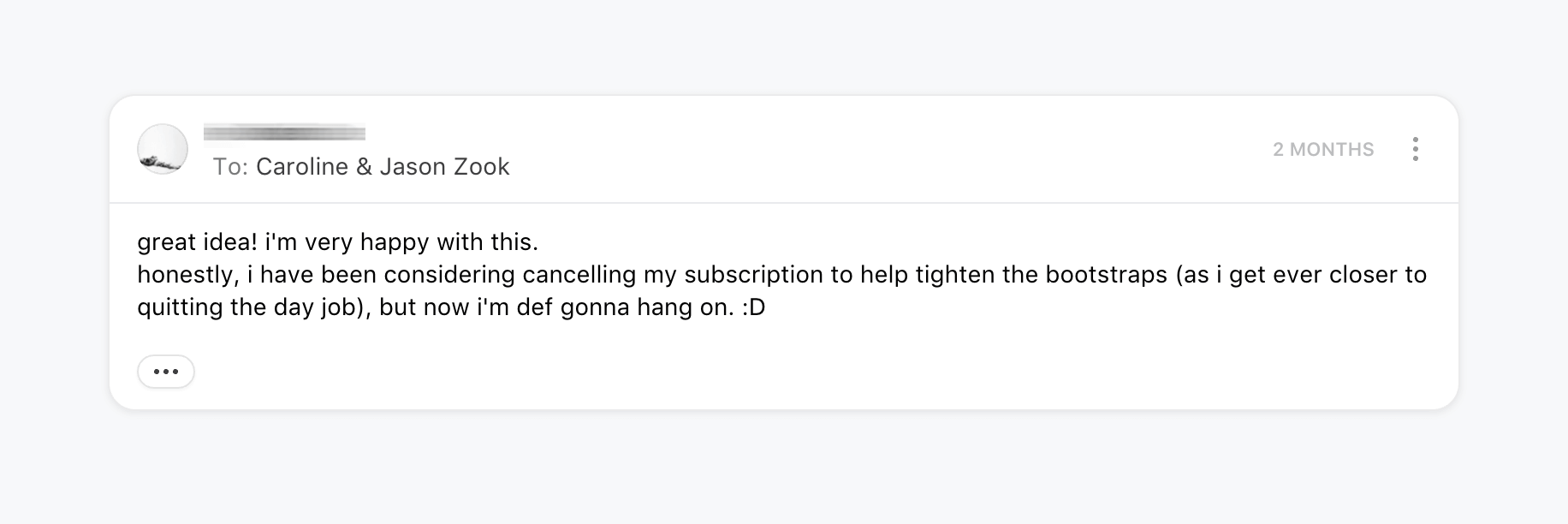
Looking at the data from our BuyOurFuture project (the previous version of a WAIM Membership which was sold as a pay-once-and-never-pay-again deal), I noticed our total churn for BuyOurFuture was crazy low: 4%.
Our total WAIM Membership churn was 30% (when we hit our 100th paying member, we also had our 30th member cancel; not a fun coincidence – woof.)
Losing 30 members is the same as losing $3,000 per month for us. That’s not sustainable considering we’ve only been gaining 20-30 new monthly members on average. Something had to change.
We have history on our side to test this hypothesis with WAIM. It’s why our BuyOurFuture project was priced as a “Lifetime” deal, meaning you pay us $2,000 and never pay us again but keep getting access to new things forever. For us, this lifetime pricing model also feels more unique and interesting. It helps us stand out from all the other business membership options.
I’d like to collect a few more months of data to see how this affects our overall churn. The switch from ongoing monthly payments to lifetime seems to be making our current paying members happy as well, so that’s an immediate win!

At first, I thought it was going to drastically blow this whole enough-thing up – haha. But, the more I thought about it, the more I think we’re still striving for the same 330 goal. It’s technically the same MRR goal, there’s just a difference in how long a member stays actively paying us.
If the first few months are any indication, our high monthly churn rate (15%) was going to make it quite an uphill battle to reach our enough number. In fact, in forecasting out the next 12 months, things weren’t looking great to reach our goal:
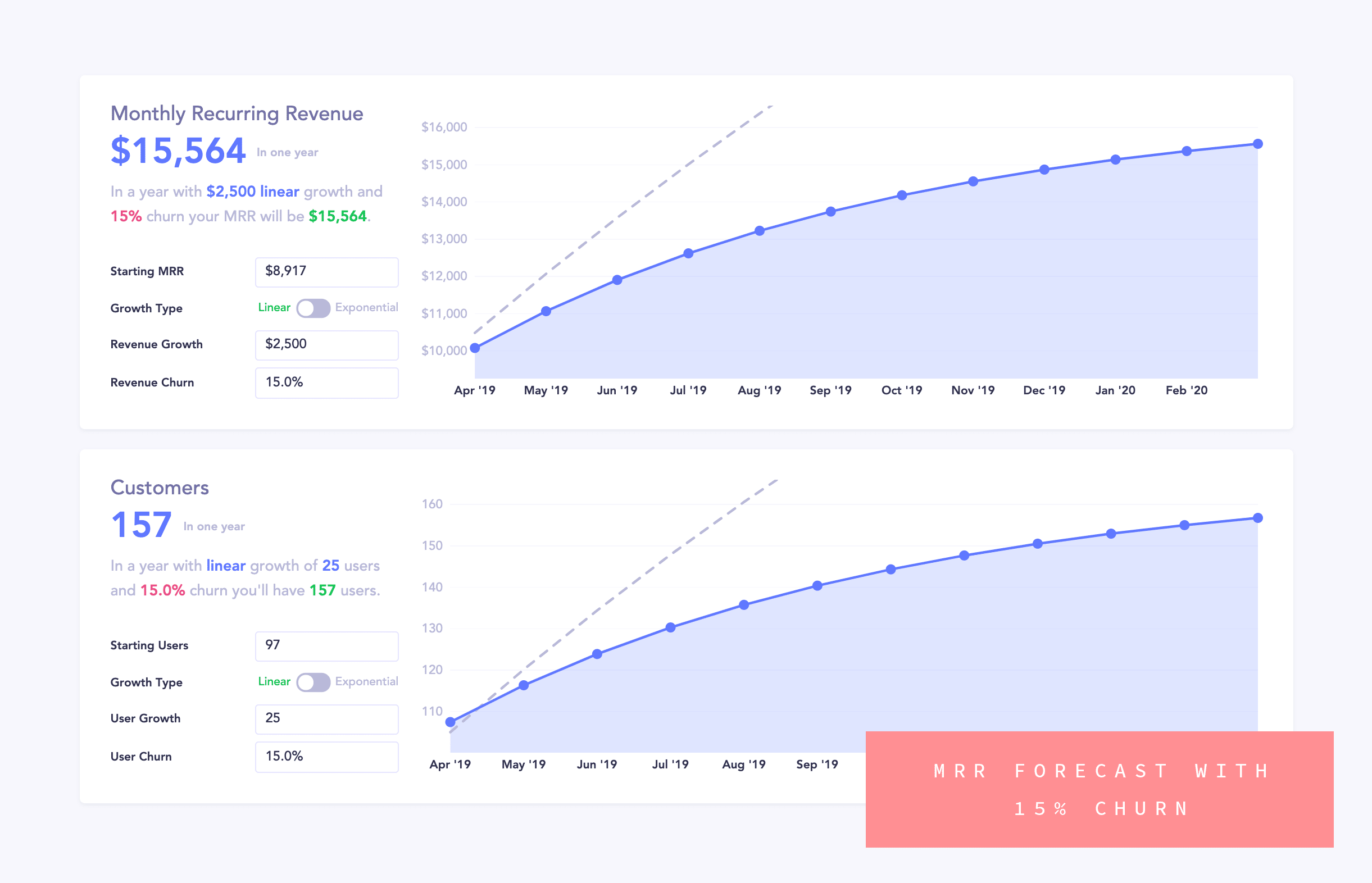
However, if we can reduce our churn back down to near where it was with our BuyOurFuture project (5%) and continue at the same monthly growth rate, we have a much more positive outlook for the next 12 months:
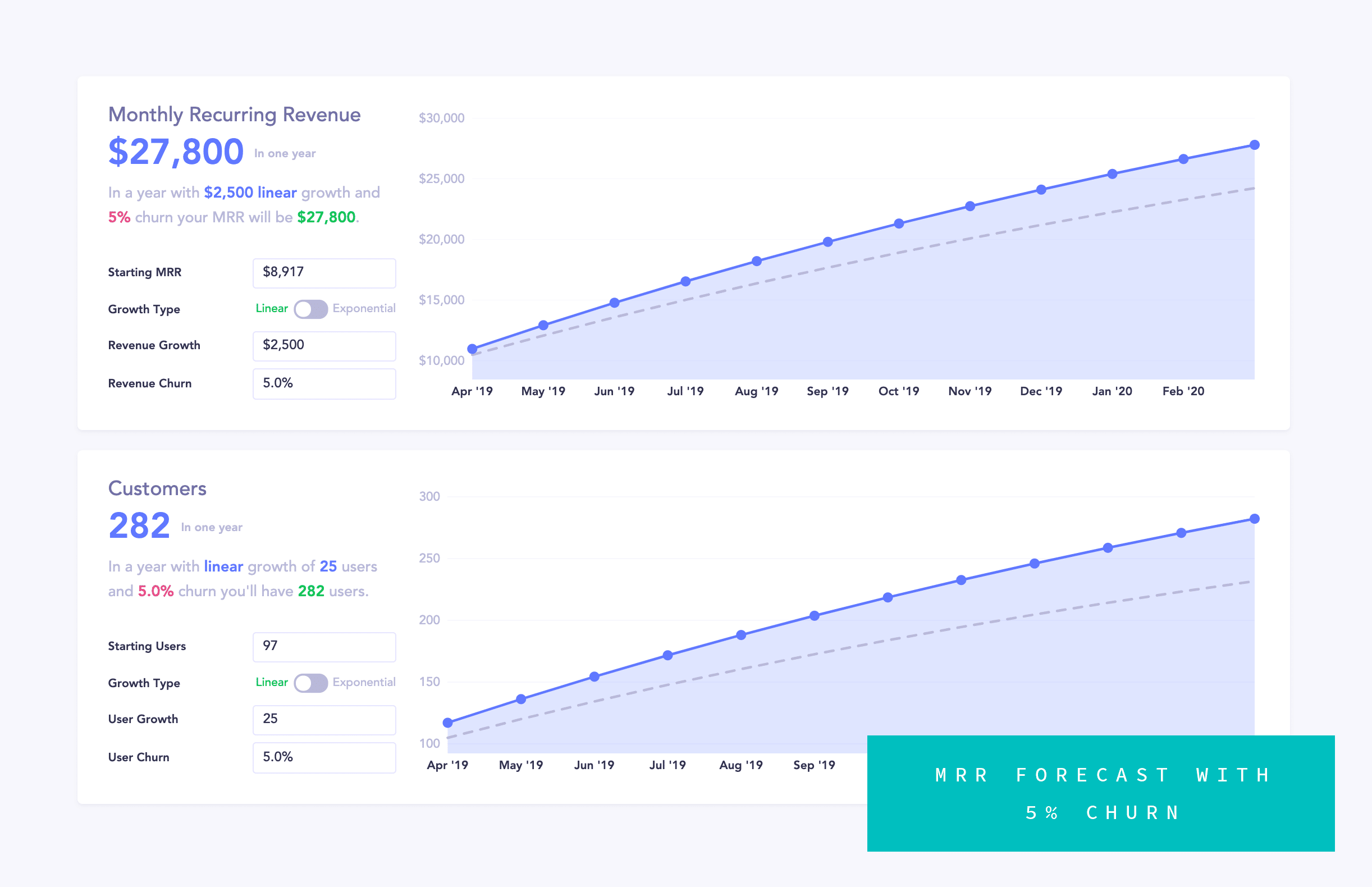
(This forecast doesn’t take into account losing MRR to folks who finish paying us, but that won’t happen for at least 18 months.)
One of the most important parts of running your own business is making changes and decisions that make you feel GOOD.
It gives our customers maximum lifetime value from us and doesn’t require them to think about how long they need to stay paying members. And from our side, it should drastically reduce our overall churn and increase our customer lifetime value.
Plus, it’s fun! As weird as it is to say this, having a selling point be that, “you’ll never pay us again after $2,000!” is something we genuinely like doing.
The past two months have moved both incredibly slowly and quickly at the same time.
Things have moved quickly: At the beginning of the year we found out there was a good chance we’d have to move in a few months (our landlord trying to sell their place). This was after we signed a 12-month lease to renew and stay put. We hate living in limbo so we decided to put our future in our own hands and find a new place to live. After weeks of hunting through Zillow listings, we found our new home, moved, decorated it, and are already enjoying the awesome new views!

Things have moved slowly: Poor Caroline is still dealing with some gnarly anxiety. We’ve been doing Neurofeedback treatments for almost two months and those are absolutely helping. There’s a pretty substantial difference from where she was two months ago and where she is today. However, she’s definitely not back to 100% or even close. Some days are pretty normal and others are pretty awful. She’s doing her best but it’s a struggle almost every day and is really tough on her.

The reason I share the personal side of things in these updates is that I know YOU deal with life too. You have big goals of your own and something derails you or gets in your way. It sucks. But alas, we all deal with it.
On the positive side of things, we’ve built WAIM in a way that Caroline doesn’t have to invest much time in it for it to stay afloat. She’s starting to do a little work here and there but it’s nowhere near what she was doing before.
On the negative side of things, it does end up feeling like I’m trying to manage all of our business stuff and still show up as a supportive husband. It’s definitely a balancing act each day/week and we’re both doing our best (and grateful we have an awesome community that supports us).
I realize this update has gotten pretty long and I’ve already gone back through and trimmed it a few times. Instead, I’ll just tell you that we’re really happy with how Build Without Burnout has turned out as a program and it seems to be helping folks already:
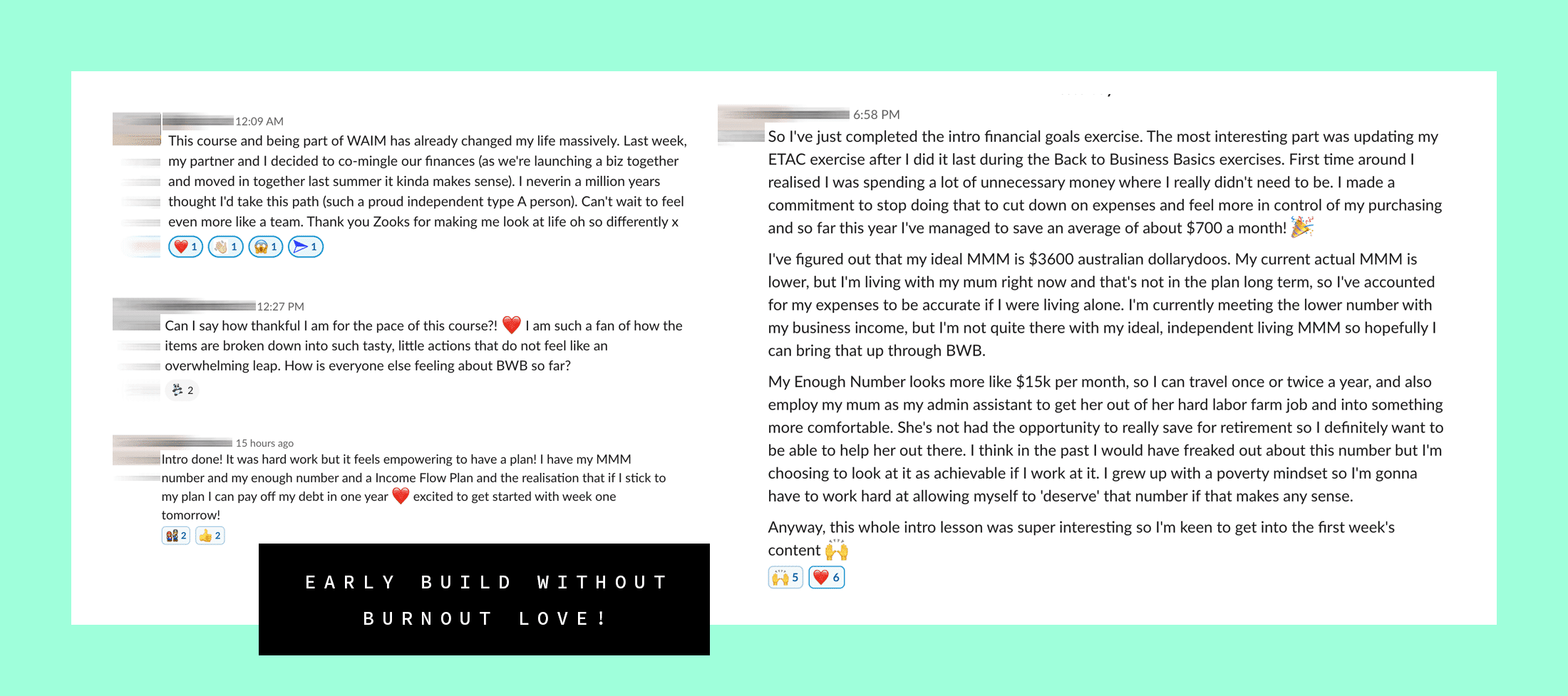
This is one of those updates where we’re really happy to see positive changes and growth toward our enough goal, but we’d trade it all just to have Caroline feel like her normal/happy/creative self again.
Perspective is a funny thing though. We’re trying our best to navigate through this rougher patch in our lives while also acknowledging it could be so much worse. If we didn’t have the amazing audience, customers, and opportunities that many people do not, these updates wouldn’t exist (it’s a privilege just to be able to write and share them).
Anyhoo, don’t want to sound all doom and gloom! We’re happy and mostly healthy, just taking each day as it comes.
As of July 3, 2019:
Monthly Recurring Revenue (MRR): $10,033
Total Paying WAIM Members: 106
Monthly Profit and loss:
Total WAIM MRR: $10,033
Total WAIM Fees (Stripe/PayPal): $433
Monthly Expenses in September: -$3,512
TOTAL PROFIT: $6,088
Quick hits of what we did this month:
Whenever I would read update posts like this I’d wonder why the creator of them would have consistent updates and then all the sudden there’d be a big gap. Well, here we are, falling into the same pattern.
But… there’s a reason: We’ve been testing and trying a lot of things. We’ve also been seeing some major improvements in Caroline’s health and that has been something we’ve cherished each day since the beginning of May.
It’s wonderful and fantastic that Caroline is feeling better but we don’t want to fall back into old habits and have her jump back into a workload that stresses her out.
I will say, while I’ve been able to toe the line around WAIM since January, it feels AMAZING that I get my partner in crime back. Not just for business stuff, either. We’ve been able to enjoy some simple life moments together…
This part of our update has me a bit bummed and confused. We saw some really solid traction when I first created our WAIM Test Drive (scroll up to the previous update if you missed what that was).
However, as time went on, the Test Drive’s conversion to paying memberships dwindled, dropped, and fell nearly flat.
I asked my buddy Paul why he thought our Test Drive may have stopped working:

I think he’s 100% right. Otherwise, I don’t know what to think? How could the WAIM Test Drive perform so well in the beginning and then convert almost no one after two months?
Now you may be thinking what I was: $12,400 is AWESOME, why the hell would we stop using the WAIM Test Drive? 🤔🤔🤔
Well, if we look further into the numbers…
As you can see, and as Paul hypothesized, the WAIM Test Drive was great at converting folks who were probably already on the fence, but not great at converting new folks. Sure, it may take more time for the new folks to convert, but there was another glaring statistic that stood out to me:

The Test Drive automated email workflow open rates, while not awful, are much lower than I’ve seen for any email funnel I’ve ever created before. To the point where it seems folks were interested, had a look at WAIM, lost interest, and then didn’t care about our emails at all.
NOTE: I’ve checked ~50 email subscribers from the Test Drive and after 30 days they completely stop opening our weekly newsletter emails.
Some people might argue this is just the name of the email marketing game, especially around trying to automate sales funnels, but that’s just not our cup of online-biz tea. We’re not interested in using tactics that are flash-in-the-pan. We want to build longer relationships with people who are highly engaged.
For that reason, we put the Test Drive on hold, for now, to focus on trying something new (more on that in a moment; see Make500 below).
We’ve been selling a version of the WAIM Membership, as mentioned many times in this post, since 2015. There’s a pretty typical sales cycle over the course of a launch window:
That’s pretty standard for us across the board. Except, NOT during our most recent May 10-day launch…
WHAAAAT???? Hahaha. I can’t even begin to tell you how weirded out we were by this launch. Nothing was that different from our previous launches. The emails were mostly the same. The calls to action were mostly the same. It. Was. Just. Bizarre.
My assumption as to why this was? We haven’t added enough new people to our email list since the last launch so we were only converting folks who needed a bit more nudging to join.
Because we charge $100 per month for our membership, spending $1,400 to only make $300 in the first month is a bit risky. Now, could it pay off? Sure. Our average lifetime value is $530 per WAIM member which would mean it’s almost break even.
My hope is that these three members stay on longer to improve that conversion spend because spending $1,400 to make $6,000 (if they paid in full) would be great! However… it’s gonna take a long time to see that come to fruition.
For us, our membership isn’t converting well enough on its own at the moment to think about paying for FB ads consistently (even simple retargeting ads).
And truthfully… We’re beginning to think the WAIM Membership possibly just does too much stuff. There are too many problems we can solve in the membership that we’re overwhelming people, therefore, not solving ANY problems (that’s no beuno!)
Which leads us to…
We’d like to create a consistent “marketing engine” that works on its own to lead people into the WAIM Membership based on just our online course teachings. Enter, our next experiment: Make500

The idea behind Make500 is to attract our core, ideal audience member:
Our goal with Make500 is to have that ideal audience member create a mini online course that they can sell and make $500 from.
If that hypothesis is true, as we’ve had it work for a few existing WAIM Members, then selling them on the value of a WAIM Membership after they complete Make500 should be a no-brainer.
As of writing this update we have a group of 20 beta testers going through Make500 and one person has already converted (hey, that’s neat!) We need a lot more data and I want to see if our organic traffic on our website will be the right fit for Make500.
Only one way to find out! More on Make500 in the next update.
It’s important that we take a step back and look at the big picture. We are seeing a trend in the right (overall direction) and it’s comforting to see our MRR growth curve continue to trend in the right direction:

That’s good stuff! It’s positive progress. And probably the most rewarding part of that chart isn’t the money, it’s messages we continue to see in our community, like these:

Sure, we’ve continued to have customers cancel (8.8% churn the past 3 months) but we’ve also added 32 new customers. And while it will continue to feel like a punch in the solar plexus (yes that’s how it’s spelled) that people are canceling, I’m beginning to come to terms with it and just accept it’s going to happen. Yeah, I know, it’s only taken about 10 months!

It can also be a bummer to get stuck in the weeds of conversions, testing, experimenting, but it’s less of a bummer when you step back and look at the OVERALL picture. When you realize things are going in the RIGHT direction… just maybe not as fast as you’d hoped (ugh, a metaphor for life #amiright??)
There’s no doubt we’re trying lots of things to grow our membership and our MRR. One important thing for us though, we have to continue to enjoy the process AND realize we’re just two people. So far, so good!
It can be easy to get bogged down with wanting to do a lot more but not being able to. Sure, we aren’t nearing our “enough” finish line just yet but we ARE 30% of the way to our goal. We ARE seeing incremental positive growth. We ARE hearing from our members that they really enjoy the value of the membership, the community, and all the products/services they have access to.
For now, we’re having gratitude for what we have and focusing on what we can accomplish in the next few months while also enjoying the summer and Caroline’s improved health!
As of October 20, 2021:
Monthly Recurring Revenue (MRR): $35,400
Total Paying WAIM Members: 278
Monthly Profit and loss:
Total WAIM MRR: $35,400
Average Monthly Fees (Stripe/PayPal): -$1,000
Average Monthly Expenses: -$4,000
Average Monthly Affiliate Fees: -$9,000
AVERAGE MONTHLY PROFIT: $21,400
Quick hits of what we did
First of all, we just want to apologize for anyone who was on the edge of their seat back in 2019 and then thought we fell off the face of the Earth 🌍. We didn’t intentionally stop updating this post, but we got laser-focused on what was most important to grow our biz (and some things had to be cut… like updating this post).
Second, we ALSO really dislike when you’re following something closely, consuming all the juicy details along the way, and then
Okay, that’s us trying to make amends. Cool? Hopefully, cool. Also, as a reminder, this is us:
 

Where we last left off (July 2019), WAIM was still a lifetime membership charging customers $100/month ($2,000 total) for a package of courses, workshops, access to a Slack channel, and an included Teachery account. Through multiple conversations with customers who canceled WAIM and existing paying customers (plus some ah-ha moments on our daily walks 🚶🚶♀️) we discovered that there was nothing ongoing that would keep someone a paying customer.
Now, that may seem like an obvious thing to you when you hear we were trying to build a membership community but we truly believed all the existing “stuff” would be compelling enough for our customers – and it was – for a small handful of folks.
How could we keep members engaged and receiving value month after month? This was the question we needed to answer.
We also knew that in order to market our offer effectively, we needed to solve a clear problem. Digging into our core audience’s pain points, we realized that most business owners are overwhelmed with all the various aspects of improving an online business: content, social media, sales strategies, website optimization, building an email list… it’s all so much.
To help provide a solution for that pain point, and to keep our members engaged, we decided to commit to a live monthly group coaching session where we’d teach on ONE specific topic each month.
(This was also roughly the time when Caroline’s anxiety started to improve and her work capacity increased. That played a big part in this pivot as well.)
We felt good about shifting our offer in this direction, but there was one more big change we wanted to make.
Because we are experienced experimenters 🧪 we knew we wanted to test an MVP version of monthly live coaching. We also thought we might try a smaller offer in addition to our standard $2,000 lifetime membership. That’s when we decided on a 6-month group coaching package, priced at $100 per month for six months (total of $600).
We chose that price and duration for a few reasons:
Even though our MRR chart doesn’t look crazy different, it was arguably the biggest (non-financial) inflection point on our journey. It allowed us to prove a concept that was sustainable for us and that our customers raved about. It was the moment we finally had “offer-market fit” but we didn’t see the financial impact of that for months to come.
 

*Sometimes the biggest inflection points in businesses don’t come with immediate financial returns. Sometimes the biggest inflection points are pivots, decisions to quit, or simply embracing experimentation as a mindset and trying lots of new things.
From the Summer 2019 until the Spring 2020, we focused heavily on delivering our live monthly coaching and listening to feedback from our members. While our MRR did grow during this time, our focus was more on making sure our new customers were happy and making sure we enjoyed the monthly coaching.
And… they did enjoy it! 👍👍
 

Our Slack community seemed to be more vibrant. There seemed to be more conversations happening, more member participation, and it should be no surprise that when you give people something to focus on each month, they’ll also have something to talk about each month!
We also discovered we THOROUGHLY enjoyed live coaching. It brought us both into our unique zones of genius.
For Caroline 👩🏻🦰: Monthly live coaching really highlighted her love of teaching. Creating online courses for years prior was the perfect primer for creating our monthly coaching curriculums.
For Jason 👨🏻🦲: In a previous life, I (the person writing this update post to you) hosted a 1-hour DAILY live video show for nearly five years. Anything you do consistently for five years has to be something you enjoy, and interacting live with people through video really gets my creative/silly juices flowing!
Here’s a look at the Coaching Hub we created for our customers where they could access the next session, previous session replay pages, and specific coaching Slack channel:

And here’s a look at the suuuuper fancy live coaching tech setup. We take great pride in quality and because Zoom (our live video tool of choice) compresses the crap out of video, we also recorded our sessions using a Sony A6400 camera, Keynote’s built-in presentation recording, and everything gets edited together the afternoon after the live coaching:

As of writing this update (October 2021) we’ve hosted 25 live coaching sessions, meaning we’ve been doing monthly coaching for two years already! WOW! 😱🤩🤪 The covid time warps are real, y’all. Coaching session topics include:
🦠 Covid-19 Note: We didn’t want to just gloss over covid because the implications of it were/are tremendous. We were extremely fortunate that a global pandemic didn’t affect our business in the way it did thousands of others. We did have a handful of customer cancelations, but we know we got very lucky existing in a remote, internet-based industry that allowed our business to continue to grow during 2020. Still, family members coming down with COVID and the emotional turmoil that brought, not to mention weathering that kind of uncertainty with Caroline’s anxiety, it was a challenge in a multitude of ways. Ultimately we were actually grateful to be a source of community for people during this time, and it fueled us in a deeper way to offer people creative solutions for bolstering their income whether through growing their side hustles or taking their previously offline skills now online.
It was at this point on our journey, hitting the halfway mark of our ENOUGH goal 🎯, we felt in control of our business.
We realized monthly live coaching was the linchpin to WAIM and our Spring 2020 enrollment was the last time we offered the 6-month coaching package. We knew we were going to do live coaching moving forward, we knew our customers liked it, and we wanted to position everything around coaching. We also felt we had enough awareness around our program at this point that we no longer needed the smaller 6-month offer as a “test it out” kind of offer.
The WAIM Sales Page you see now is the one we put together in the Fall of 2020. This sales page is the culmination of everything we learned about positioning, copywriting, and ensuring the right customers know we are the right coaching program for them. Also, random fun fact, I believe it was our sixth sales page we’d created for WAIM since 2018.
By Fall 2020, we had the following assets for our customers:
Our members really appreciated that we gave them one thing to focus on each month with live coaching but they were looking for some additional guidance through our assets. When we took a step back and looked at our WAIM Library and the WAIM Coaching Hub, it’s no wonder they didn’t know what to dive into next. It was information overload with no compass to guide them.
The more we talked about it, the more we knew we needed a better container that could bring all our coaching sessions, workshops, courses, etc, into ONE place and LEAD our customers on a journey to improve their businesses.
Again, this goes back to that ultimate PROBLEM we were trying to solve for people: give them ONE thing to focus on each month. But when everyone’s business is different, how can you lead someone to the right next step for them? You create a sequence that they can follow so the next right step always becomes clear.
Our initial brainstorming session about guiding our customers revealed five pillars of focus:
These five pillars became the initial “content buckets” all our other existing content would sit within. We eventually ended up creating a flow chart that touched on every part of that roadmap using every asset we’d already created. The purpose of the flow chart would be to ask questions and lead someone to the next right step based on what they’d already tried in their business:
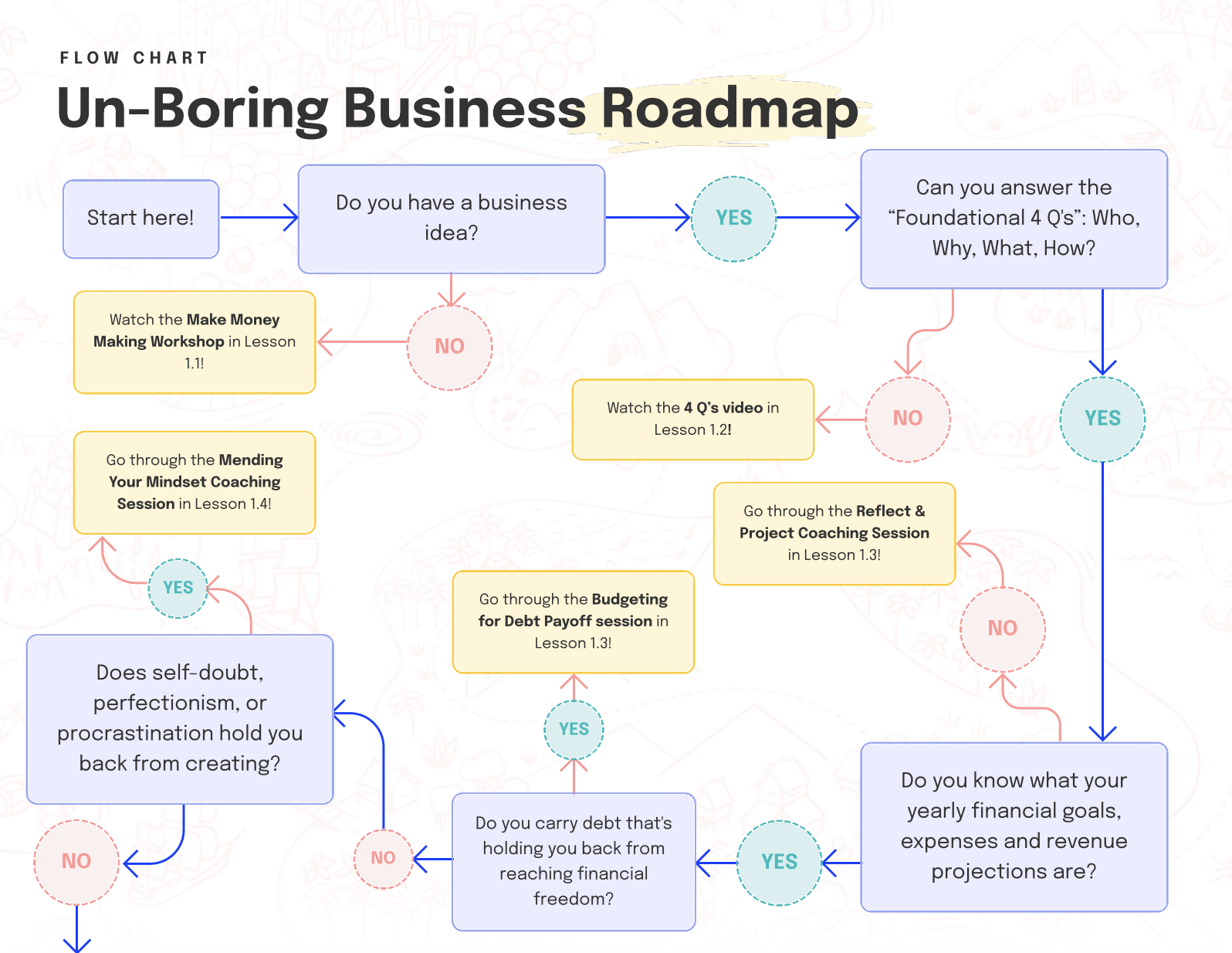
This flow chart coincides with the cornerstone product we created: The Un-Boring Business Roadmap. The roadmap is simply a course every member gets access to in their Teachery account. The five pillars I just mentioned are “Lessons” in the course and all our assets are “Sublessons” within the course (all the yellow items in the flow chart above).
As the roadmap started to come together we got really excited about it! Not only was it a new “thing” to offer as a carrot 🥕 during our Fall 2020 launch period, but it also solved an ongoing problem for our customers.
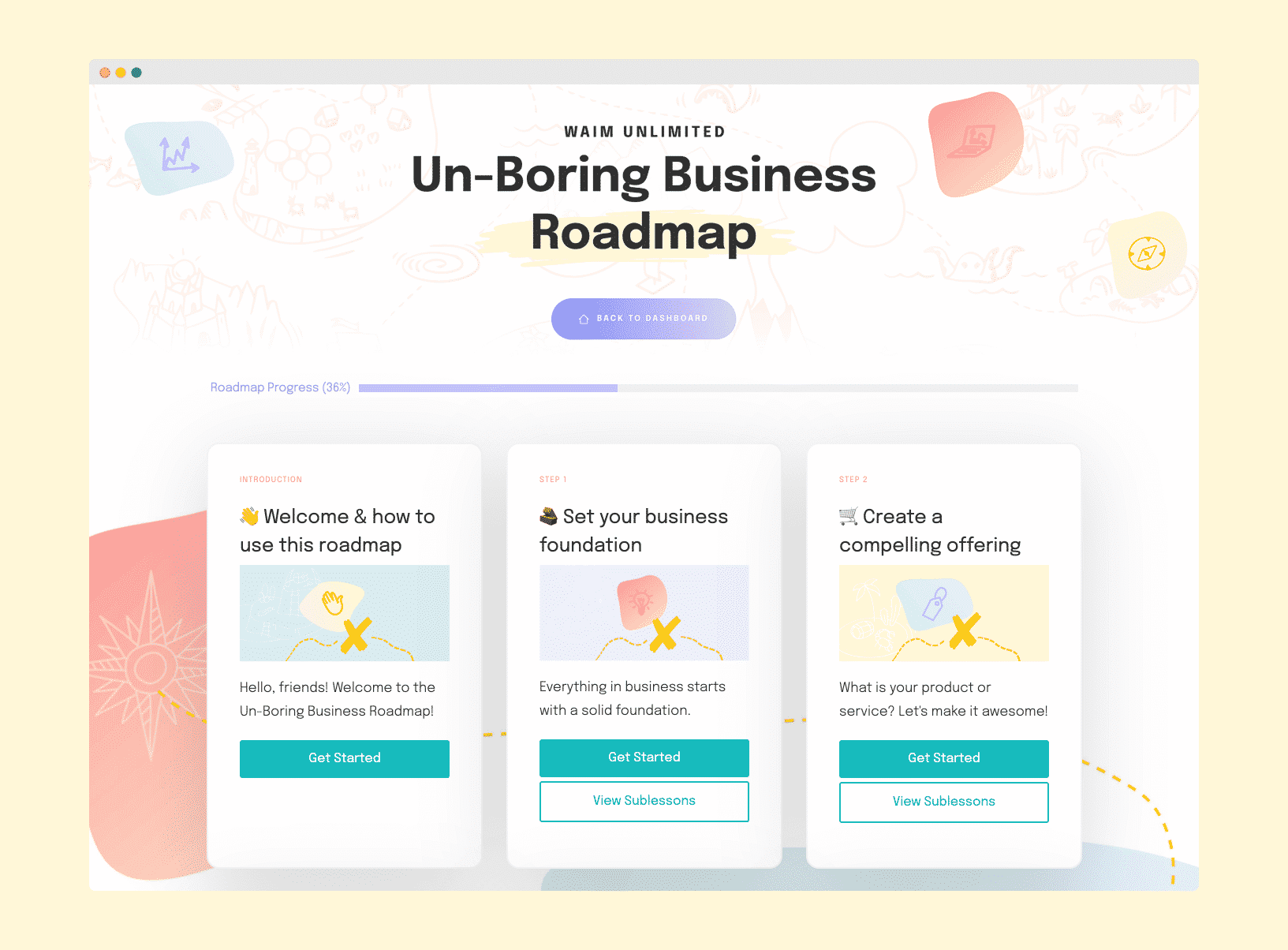
One of the other things we kept getting asked from our existing members was if we were ever considering creating an affiliate program for WAIM. The answer was YES! but we didn’t want to do this until we felt really confident that WAIM Unlimited was solving enough of a problem and creating a great experience that would keep people on as paying customers. (There’s no point in pouring more customers into a business with a high churn rate!)
There was an interesting moment as we recapped our Fall 2020 launch with our members at the end of our October 2020 live coaching call. We shared a slide that compared our Spring 2020 launch (71 new customers for the 6-month coaching offer) to our October 2020 launch (51 new customers for our WAIM Unlimited offer):
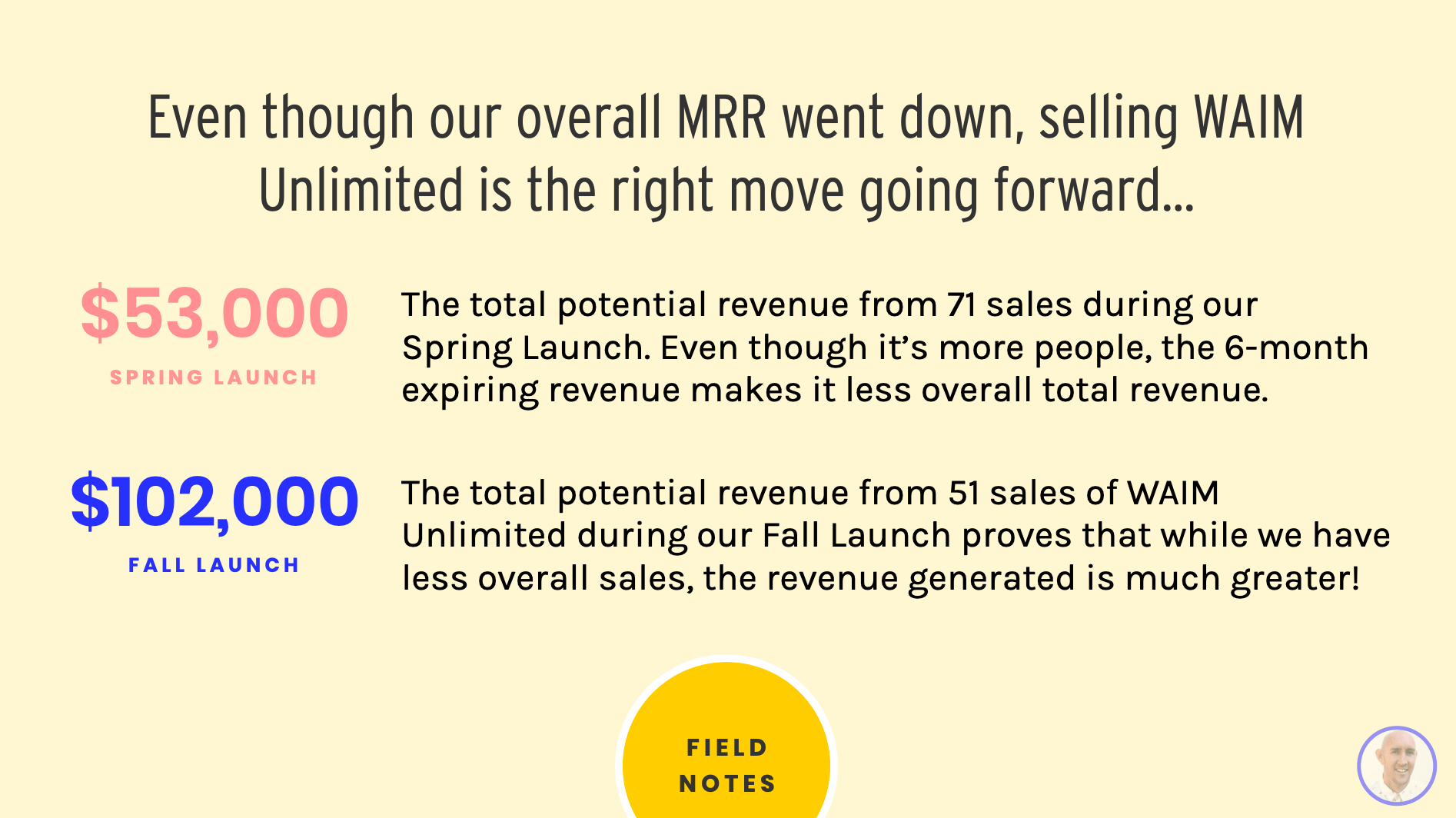
While 51 is less than 71, moving to WAIM Unlimited and not selling a $600 (6-month) coaching package was the right long-term move for our monthly revenue.
The big takeaway for us was that 50 new members bi-annually would be a great amount of new customers. While our immediate MRR didn’t jump, it extended the overall runway of our MRR so we knew our next launch would be the time we’d see a sizable jump!
And with that next launch, that’s where you can see one of our biggest revenue jumps since we started in 2018:
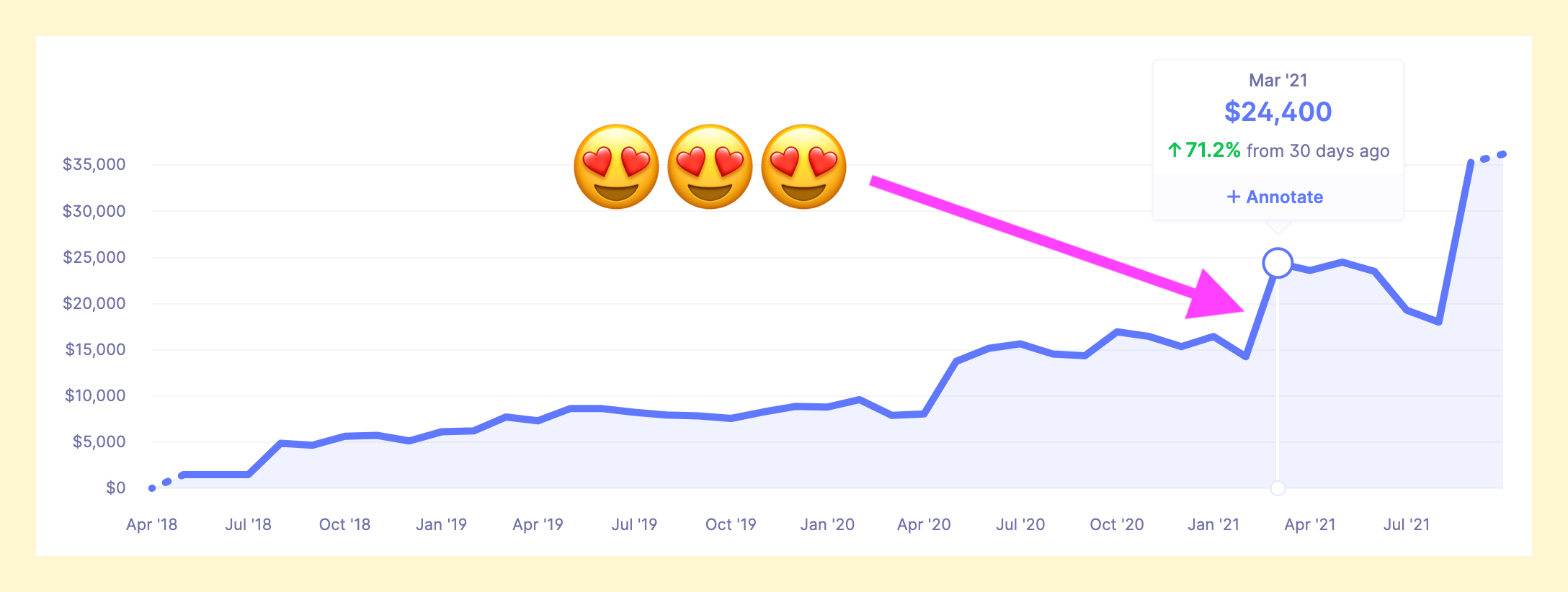
As we mentioned earlier, Covid-19 hit our family as well, but thankfully not as hard as it did many other people. Caroline’s dad was hospitalized with COVID for five weeks to start 2021 and it was really tough 😢. We are so grateful he was able to get excellent care and when he finally left the hospital in mid-February, we let out a huge sigh of relief.
After recovering from the mental rollercoaster the beginning of 2021 put us through (not to mention the abhorrent attack on the U.S. Capitol building by U.S. citizens 😩), we were ready for a bit more “normalcy” and to focus on work.
We did an evaluation of the state of WAIM leading up to our Spring Enrollment period:
✅ WAIM was being sold as a $2,000 (un-boring) coaching program.
✅ We had the Un-Boring Business Roadmap to guide members through all our courses, content, coaching sessions, etc.
✅ We figured out a great cadence of launch content (emails + posts on IG + mentions on our podcast).
✅ We built a simple affiliate program and had a product our customers were happy to promote during our launches.
✅ We found a consistent email and podcasting strategy and stuck with it.
March 2021 rolled around and we queued up our nine sales emails. We posted a handful of times on IG for two weeks. This was the first launch of WAIM that truly felt in our control.
The numbers didn’t lie either!
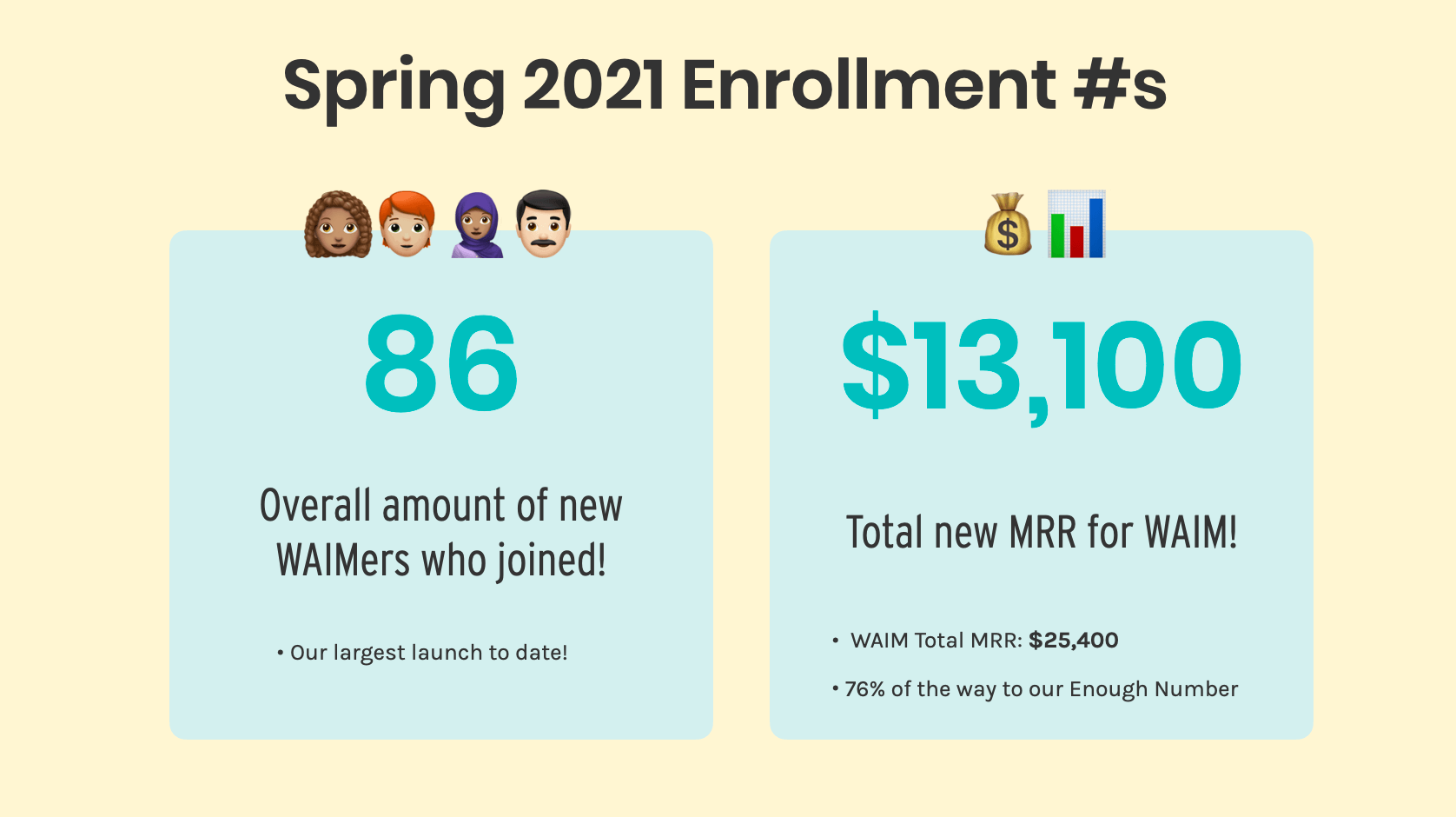
It took us two years to go from $0 to $13,000 in MRR for WAIM. During our two-week Spring 2021 enrollment period we added nearly that exact amount of MRR! That’s… AMAZING. 😍❤️🙌
A huge part of that success was owed to our existing WAIM members who promoted our launch as affiliates. This was our second launch with affiliates but we put a bit more effort into it after learning from the first go-round.

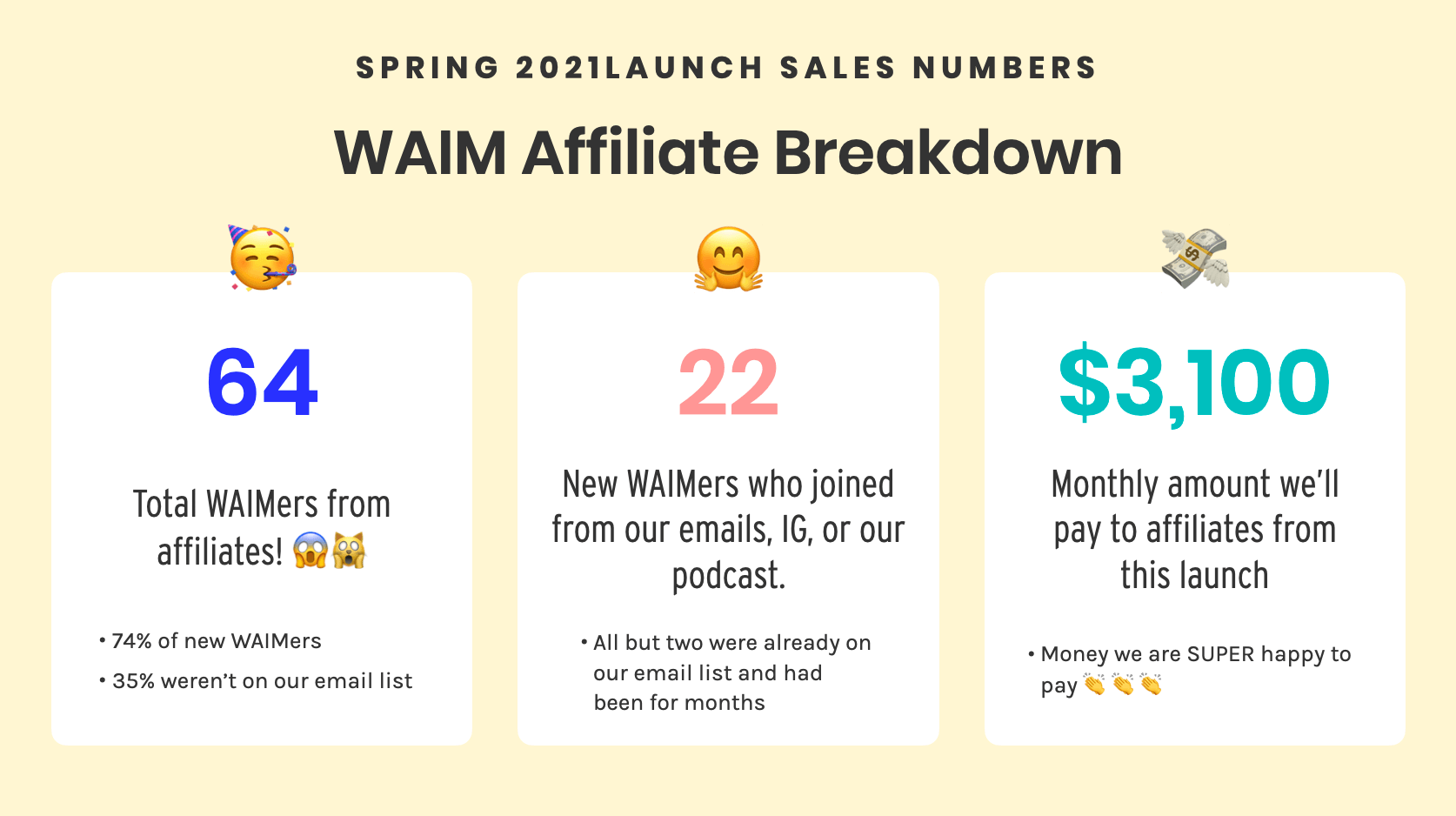
Yep, 74% of our Spring 2021 new members came from affiliates. Of the $13,100 in MRR we gained during the launch, $3,100 of that would be paid to our affiliates. We like to think of affiliate payouts as a way we can “advertise” WAIM, but instead of giving our advertising dollars to a big company (ahem, FB), we can put that money directly in our members’ pockets!
Leading up to this Spring 2021 launch we wanted to experiment 🧑🔬👨🔬 with IG Reels. Instagram seemed to be pushing Reels pretty hard and we’d not put much attention or effort into them at all (honestly, we don’t put that much effort/attention into social media at all). But hey, we love trying new things so let’s do it!
We ended up creating 16 Reels leading up to and during our 2-week enrollment period. Caroline gets ALLLL the credit for our IG content and I was simply available as a prop, a dancing idiot, or the person who sets up the tripod and presses the record 🔴 button on the iPhone 😂😂.
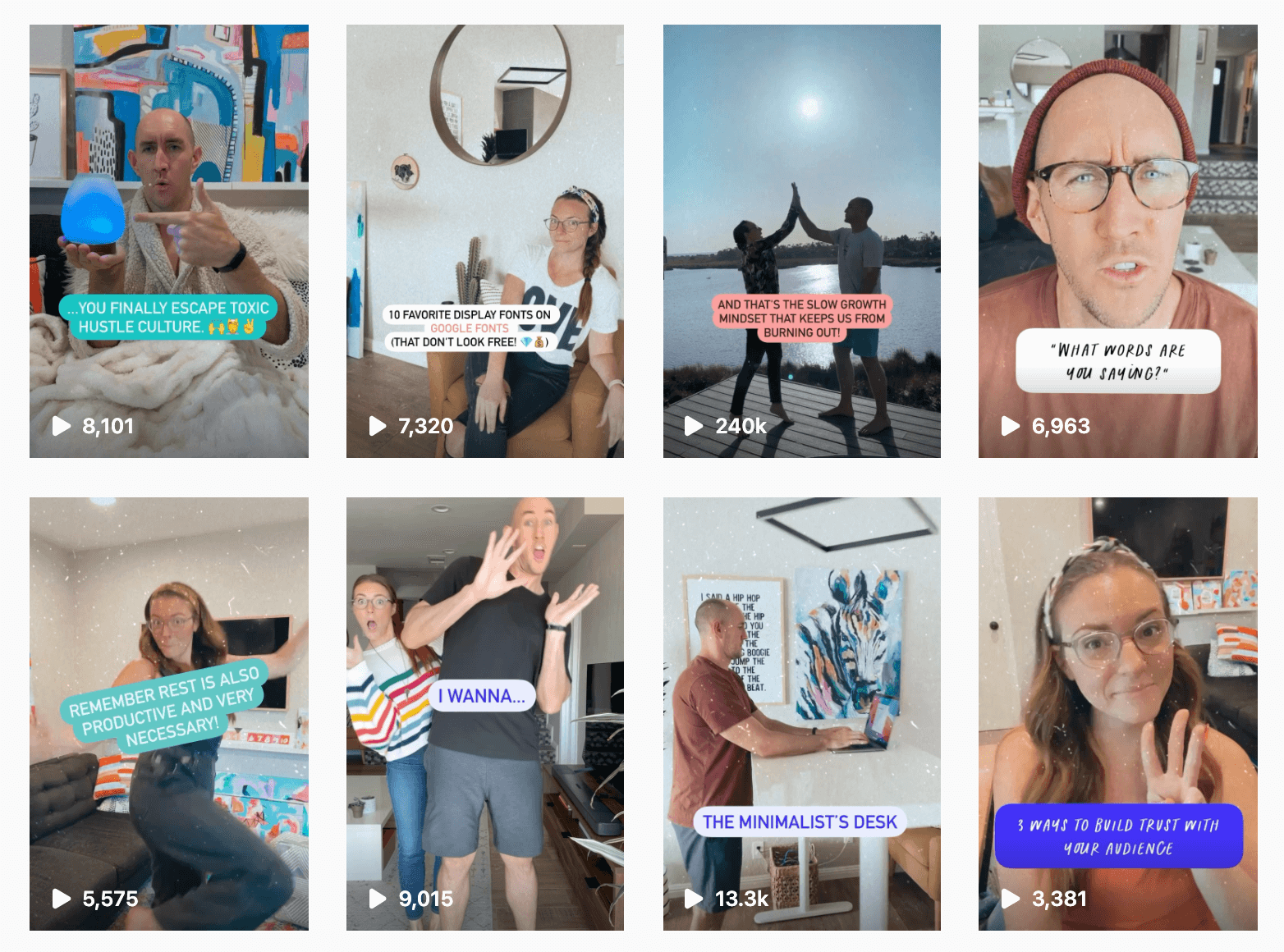
You *MIGHT* notice one of those Reels’ view count is not like the others… With no explanation whatsoever, this particular Reel struck a cord and had its own viral moment (amassing 220,000+ views in 72 hours).
While having a Reel go viral might seem like the dream scenario during a launch, aside from the 1,500ish new followers to our @wanderingaimfully account, IG still ranks incredibly low on the “how did you hear about WAIM” question in our post-purchase survey:
So, sure, it’s nice to see a Reel go viral and it’s fun to get new followers… but… it truly didn’t impact our sales. And for reference, during the Fall 2020 Enrollment (the previous launch), 8% of buyers said they heard about us through Instagram, so it technically went DOWN this launch 📉😅.
After our Spring 2021 enrollment, we took the majority of the summer to rest, recharge, and to soak in the Southern California sunshine.
For the first time in… welp… our entire lives as online biz owners who always send weekly emails, we took two FULL months off sending email newsletters. We also took a break from YouTube, IG, and recording podcast episodes during those two months. When we say we took a nice summer sabbatical, we took a nice summer sabbatical!

(Yes, that is me lounging in our tiny “stock tank” pool. You aren’t going to be doing any backflips into that pool but it’s the perfect place to take a dip and cool off 😎).
Alright, Summer of 2021 came to a close and we started gearing up for our Fall enrollment period. As you may have gleaned from the previous paragraphs, we really felt like we’d hit our stride with WAIM as a business. The following things were definitely working in our favor:
Once you figure out a plan that works (through months/years of experimentation), you can stick to it and just plug and play the necessary puzzle pieces 🧩.
Our Fall 2021 enrollment went off without a hitch. We followed the exact same plan as our Spring enrollment and barely made any changes. The only real change was we recorded seven YouTube videos and shared them weekly leading up to the launch. This was another experiment 🧪 we wanted to try and it didn’t move the needle much at all (nor did we really expect it to). We always love trying things, though!
As the 2-week Fall sales period came to a close, a gigantic milestone on the Journey to Enough had been hit:

I could type a bunch of words to capture exactly how we felt the moment we realized we hit our enough number but thankfully we had the foresight to flip on the old iPhone selfie cam and record the moment in real-time to share…
What you might notice in that video is that we’re not jumping for joy. Is that… bad? There’s definitely a tinge of guilt in sharing with you that hitting our enough goal didn’t result in an epic dance party. But the reason we’re it may seem like just another day to us is not that we don’t celebrate the journey or appreciate this hard-earned milestone; it’s that while this journey STARTED with this “enough” number in mind, along the way it became less about the outcome and more about the process itself. We finally have a business that is profitable and fuels a life we love, that serves our customers’ needs and provides value, and that can continue on sustainably. The MRR is just an amazing byproduct.
We think this is actually evidence that the enough philosophy has done its job because when you finally reach that mountaintop you defined, you’re not thirsting to go reach the next big one. You’re content in what you’ve built and can continue to engage in a process you enjoy to see where it leads you.
(Nonetheless, when we got back to California, we had a proper dance party to celebrate! 🎉🎉)

Great, the celebratory dance has been done ☑️. So, how did our Fall 2021 launch break down?

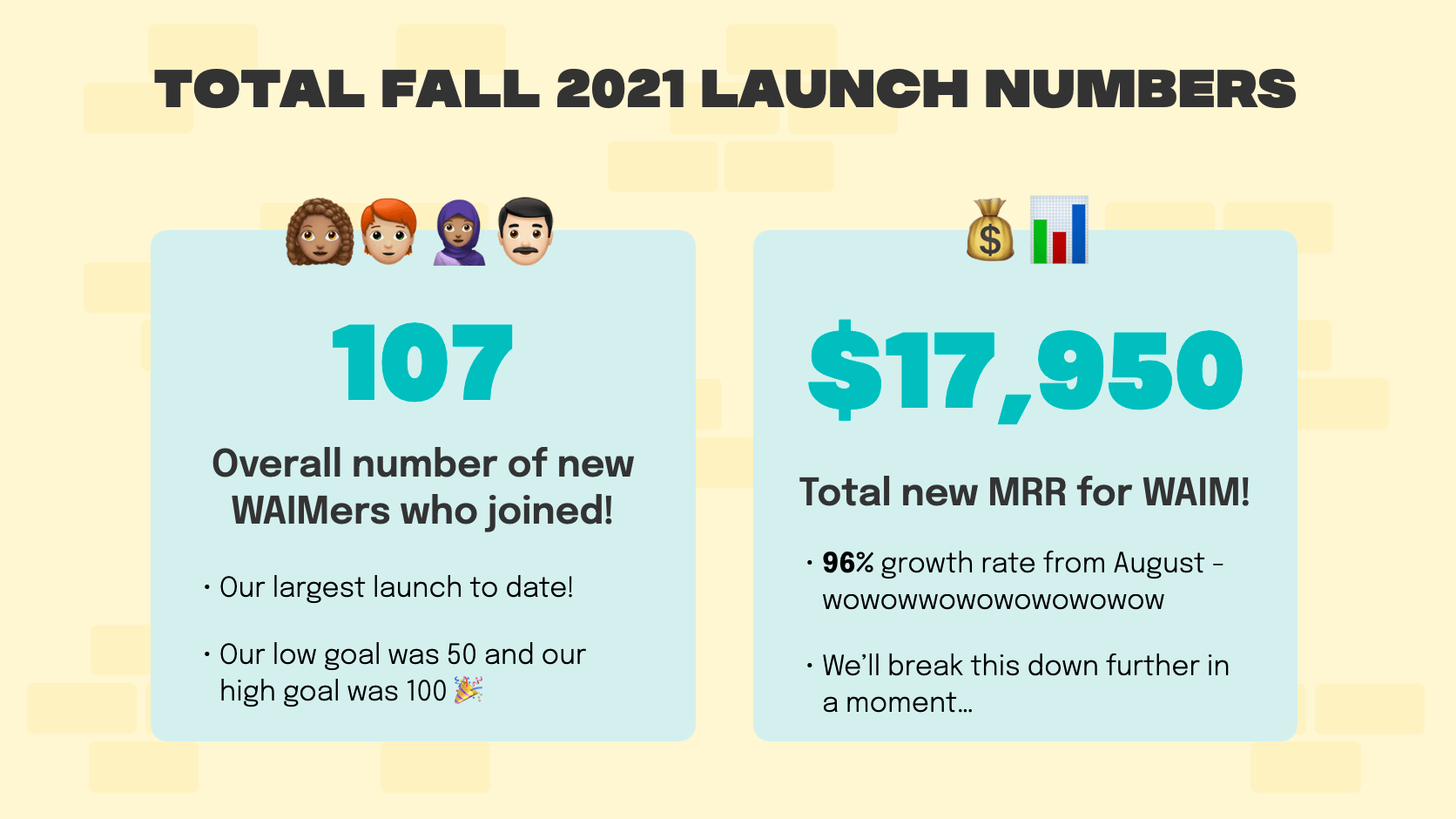
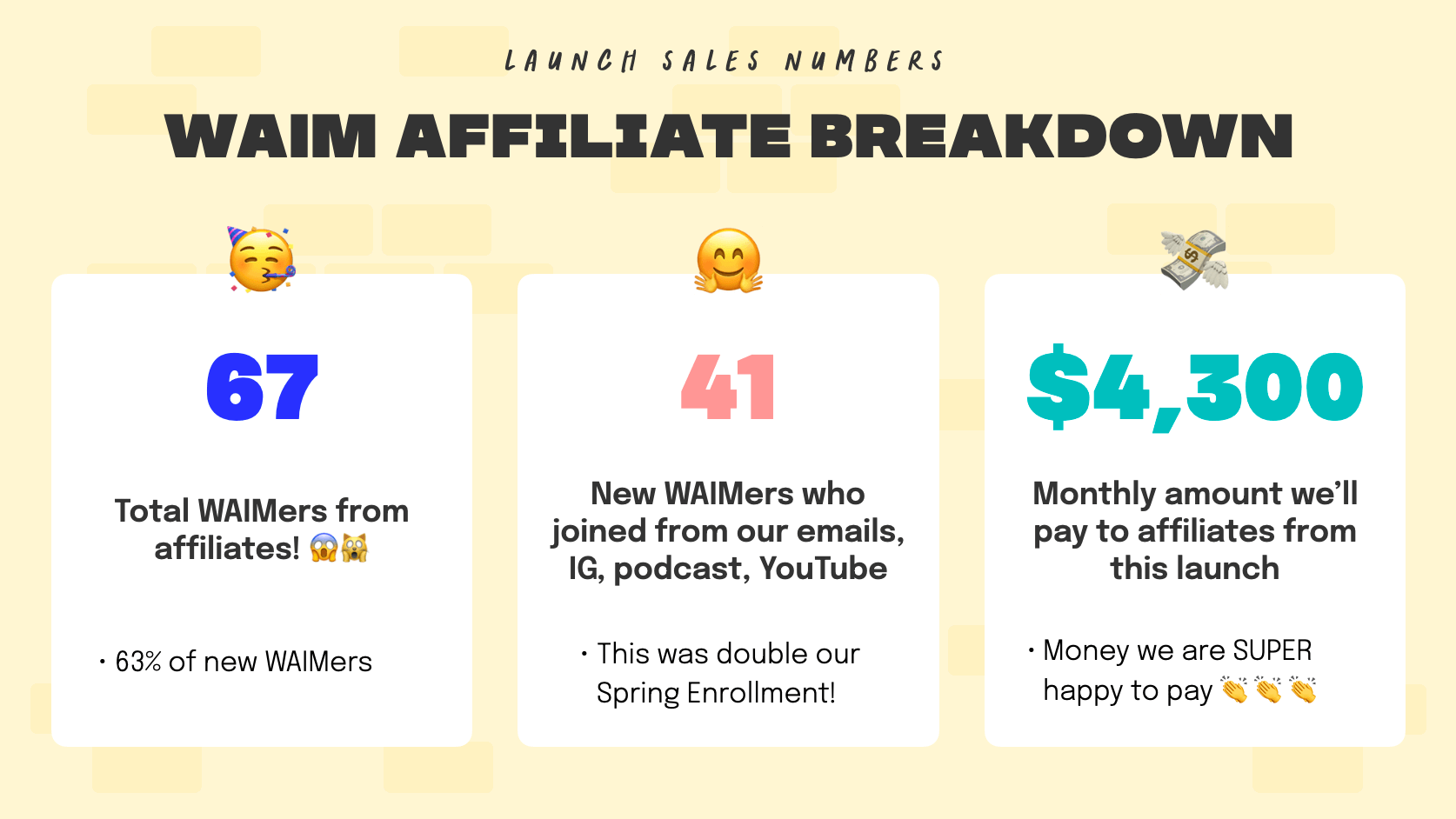
It’s a bit surreal to write this final update to this post. We are truly grateful for the business and the community we’ve been able to build. Every day we express gratitude for WAIM and the leap we took together back in 2018 to start it.
As you’ve read (or skimmed 🙈🤣), our journey was not a straight path to success. We had challenges, setbacks and moments of doubt at so many places along the way.
However, as you read this and (hopefully) take inspiration to apply to your own business and circumstance, it’s important for us to acknowledge there’s a lot of inherent privileges we have that many people do not. As white, cis, heterosexual people with a lower-middle-class upbringing, it’s simply a fact that we had less hurdles to face in our pursuit of this freedom-filled business than most. We see that more clearly now than ever.
As mentioned at the beginning of this post, we have been and will continue to steadily increase our annual wealth redistribution (previously what we referred to as “charitable donation”). As we reach a place of financial privilege and security, we want to make sure we are helping contribute to solutions that facilitate that same opportunity to those who are systemically excluded from it.
Because you’re a savvy reader and have paid attention closely, you understand that our “lifetime” revenue model means our monthly recurring revenue has a certain shelf-life, so to speak. After a customer pays $2,000, we make $0 in revenue from them moving forward so we will have to replace their revenue at some point.
The way we’re thinking about things moving forward is fairly simple:
We don’t plan on writing any updates about this journey after this one and hope you’ve enjoyed this exhaustive and thorough look into WAIM 👋.
Thanks for reading and we’ll see you around! 👩🏻🦰👨🏻🦲🤗
Note: Some of the services below have our affiliate links in which we make a tiny commission if you sign up. You can read our full Tools We Use list here.
Flywheel – We’re huge fans of Flywheel’s WordPress hosting! I joined them really early on with my previous JasonDoesStuff site and have loved every minute of paying them money. For just $15/month you get an intuitive dashboard, free SSL, fantastic customer service, and included hands-on migration from your existing WP host.
Restrict Content Pro (RCP) – We were completely new to RCP when we started building WAIM but we heard great things about it. RCP has lived up to the hype and is incredibly powerful if you’re trying to run a membership community using a WordPress website. The features are great, the help documentation is solid, and customer service has also been top notch.
Affiliate WP – Our members asked for it and we finally decided to offer an affiliate program for our existing members to earn a commission for bringing in new members during our bi-annual launch periods. Affiliate WP plugs in perfectly with Restrict Content Pro! We really appreciated how simple and fast it was to get an affiliate program up and going.
ConvertKit – During the first few years of WAIM we used an email provider called Drip but have since made the move BACK to ConvertKit (where we were in 2015-2016). Drip shifted their customer focus and ConvertKit added a ton of great features for creators like us!
Vimeo Pro – We previously hosted all our videos with Wistia but their bandwidth pricing started to put a hurtin’ on our monthly budget for WAIM. We made the switch (thanks Kade!) to Vimeo Business and haven’t looked back since. We really enjoy the Vimeo experience and recommend it highly if you need private videos with custom branding.
Interact Quizzes – We mentioned in our final update that our email list grew by 400% when we started using a quiz. Interact is the quiz provider we chose and we’ve been EXTREMELY happy with them. You can see our quiz in action by clicking here.
Notion – At this point, you are probably very familiar with Notion? If not, it is a game-changer! We use Notion for errrrrrrverthang in WAIM. It’s how we manage our member payments, how we organize all our content, how we plan any project we’re working on, and we even track our “Classic Movie Nights” in a Notion database. We truly love it and couldn’t live without it.
Slack – With over 800 total WAIM Members, we wanted our own private place to hang out and chat, free from distractions (we’re looking at you FB Groups). We use the free Slack plan and cherish all the amazing features we get. If you run a community or just want a way to chat with friends/co-workers, Slack is a must-use.
Baremetrics – The most beautiful way to keep track of our monthly recurring revenue and overall financial growth of WAIM. Baremetrics takes minutes to set up and is completely automated if you use Stripe (we do have to input our PayPal members manually).
Hope one of those tools can help you in your biz!
When you run an online business, it can be very easy to get caught up wondering which business analytics actually matter.
Is it your social media follower numbers? Your total website traffic each day/week/month? How much money you make every minute of every hour of every day?
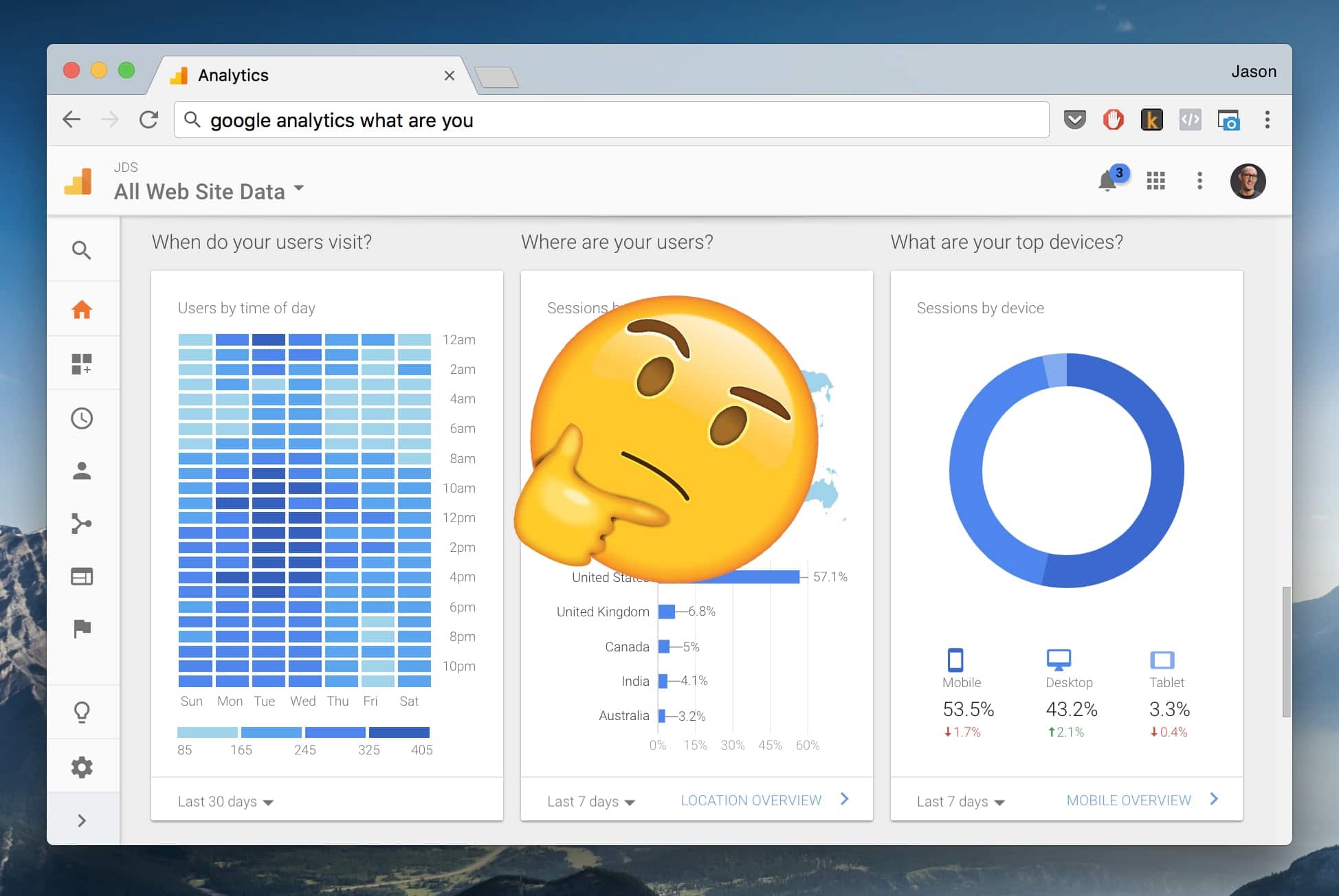
(Oh Google Analytics, I want to love you. I really do.)
With nearly a decade of online business experience, I’d like to share my perspective on the analytics you should be paying attention to. Spoiler alert: None of them will have to do with your social media accounts.
Website – You have a website for whatever it is that you sell. This website should be getting traffic from multiple sources (direct, organic, social, etc).
Product – You have a product (or service) that you sell on your website. It could be a widget, a gizmo, a gadget, or even rare golden thimbles. Seriously though, you sell something for money on your website that people can purchase (via credit card, PayPal, etc).
Subscribers – You have people who purchase things from you and people who just want to get email updates from you. For sake of simplicity, let’s group them together and refer to them as subscribers (and you can segment them later, if you’re into that sort of thing).
Those three items (website, product, subscribers) are what make your business run. There’s typically a direct cause and effect between each:
This loop happens over and over again. You’ve probably experienced this loop in a varying degree of sizes. Sometimes you have traffic spikes, which lead to spikes in sales – Yay! Sometimes you have slow times, which lead to you wanting to pull your hair out and wondering if everything you do should be completely flipped upside and you should go back to that full-time job you used to have – BOO! (don’t do that!) Either way, your online business revolves around traffic, subscribers, and revenue.
This may not seem like news to you, but for many online business owners, myself included, the data that really matters lies in between each of those main analytics (traffic, subscribers, revenue).
If you don’t, that’s okay! Traffic to subscriber conversion rate is simply the percentage of visitors to your website that sign up for your email list.
Why traffic to subscriber conversion rate matters: Whatever traffic you have coming to your website, you want to capture it and keep the attention of those subscribers (remember: these people purchase from you or pay attention to you). If someone simply visits your website, looks around, and leaves without doing anything, you’ve potentially lost that person forever. Instead, because you’re running a business here, you want them to purchase something from you or at least opt-in to hear from you in their email inbox.
Let’s look at example data for my previous website JasonDoesStuff.com:

(This screenshot is from Spruce Metrics, a business analytics software I co-own and that I’ll talk more about in a moment.)
There are a handful of numbers to look at there, but I’ve highlighted the conversion rate in red for you (you’re welcome!) The month of traffic you’re looking at had 42,002 sessions* (website traffic) on JasonDoesStuff. From those sessions 3,714 people became new subscribers.
*We choose “sessions” as our traffic data point of choice because people who are smarter than me agree it’s the most comprehensive way to track a website visitor.
What’s a good traffic to subscriber conversion rate to shoot for? We could go down a rabbit hole discussing what optimal traffic to subscriber conversion rate is, but what’s most important is that you actually KNOW this statistic exists. It shows you how good of a job you’re doing converting a website visitor to an email subscriber. Once you know this data point, then you can start to make tweaks to improve it.
How can you improve your traffic to subscriber conversion rate? Ahhh, great question! There are a ton of things you can change on your website to increase your conversion, but here are the ones I’d propose starting with right away:

I ran a 3-week experiment where I tested a website pop-up (left), Welcome Mat (right), or exit intent pop-up. I wanted to see which option my website visitors preferred. You already know the answer, but you can read more here.
These are people who can pay you in attention (just subscribing and opening your emails), but again, you’re running a business and you need revenue to survive. We want your subscribers to become paying customers.
It can be a bit tricky to calculate the value of your subscribers, but even knowing the estimated value is incredibly helpful.
How do you calculate the estimated value of your subscribers? For nice round numbers, I’m going to show you how to do this annually.
Let’s assume your business generates $50,000 in revenue each year and you have 2,000 total email subscribers during that year. You’d divide 50,000 by 2,000 to get the estimated value of $4 per subscriber.
This is a great piece of data to know because it can show you how your revenue should grow as your amount of subscribers grows (either organically or through paid acquisition).
What do I do once I know the estimated value of a subscriber? Assuming our example subscriber value of $4/per, you can acquire new subscribers at a cost of $3/per (leaving $1 per to make a decent profit). If your subscriber value is much lower, let’s say $0.25/per, you are going to need to have a pretty sizable email list to run a profitable business. A lower value per subscriber would tell me that I need to:
Many online business owners focus on customer acquisition over customer retention. If someone has already paid you (remember: with their attention or by purchasing a product), you should do everything in your power to increase their value* to your business.
*I’m not telling you to hard sell and constantly be pitching your subscribers to buy from you, but you may not be selling enough.
It can become easy to obsess over how many people subscribe and unsubscribe from your email list. You may know how many new subscribers you get each month (or maybe not), but most email service providers don’t show you monthly growth rate.
Subscriber Growth Rate is your percentage change in total subscribers month over month. Here’s an example of that data, highlighted in red:

You can see in the image above my friend Matt’s Subscriber Growth Rate. He figured out the wonderful combination of acquiring more new subscribers AND lowering his monthly unsubscribes.
If your subscriber growth rate is decreasing and you think it might be due to high unsubscribes, here are a couple things you can try:
This one may be obvious, but many commerce platforms don’t clearly show you what percentage of your sales get refunded. Refund percentage is easy to calculate: Just take the total numbers of refunds divided by total number of purchases.
For example: Let’s say you had 9 refunds on 90 purchases. Your refund percentage is 10%.
To me, 10% is a high refund percentage. Something isn’t connecting between the sales pitch of your product and what the product actually delivers. You can improve your refund percentage by doing a couple things:
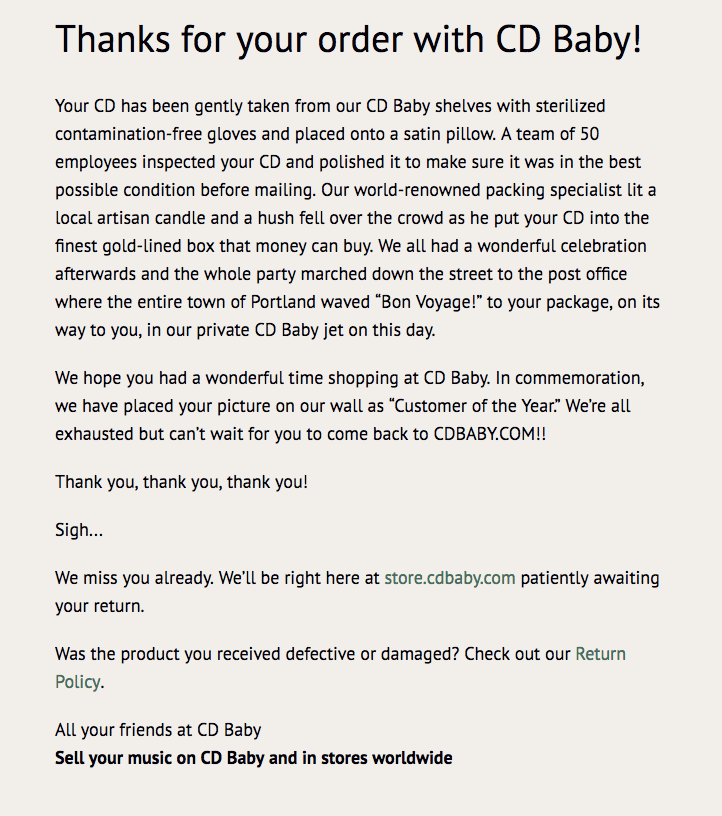
(This is a pretty famous post-purchase email that Derek Sivers used for his company CD Baby. It’s been shared everywhere and customers loved this little surprise after a purchase. This simple email actually become a huge piece of marketing and retention!)
The analytics you should be paying attention to for your online business are:
These data points are critically important and can be heavily improved through a handful of things mentioned in this article. Before you try to improve them, you probably want to make sure you’re calculating them and can see them in an ongoing basis!
If you’re overwhelmed by keeping track of all your business metrics and wish you could see them all in one place, give Spruce Metrics ($19/mo) a try!
Spruce Metrics is a piece of software I co-founded and it will help bring your website traffic, email subscribers, and revenue together. Then, we crunch that data for you and show you some of the data points I’ve talked about here (revenue per subscriber is coming soon).
You can stop looking at Google Analytics every day. It’s time you started paying attention to the metrics that are actually going to grow your biz 👍🏻.
Do you constantly find yourself wishing you had more hours in the day?
Do you feel like you have very little extra time to spend with family and friends?
Are you running your own business, but feel like your business is actually running you?
Or a plan to put your family first? Or a plan to help you stop focusing on when the next chunk of money might come in, and instead feel like you have a predictable and sustainable income?
When I set out on my entrepreneurial journey in 2007, it was all sunshine and rainbows. I wore sweatpants every day. I had some money saved up that felt like a nice cushion. I even had a business idea that took off (IWearYourShirt).
But then, an unfortunate chain of events occurred:
My life was completely out of balance. To say the rainbows and sunshine disappeared would be an understatement.
The reason everything was out of balance was that I put my business first. I didn’t define the type of lifestyle I wanted. I just assumed a great life would come with a thriving business.
Boy oh boy, was I wrong!
I know what it’s like to start your own business and feel completely out of control. Your time, your income, or even your decisions (to some degree) feel like a total mess.
My wife, Caroline, has felt the same way.

(Caroline in her natural habitat.)
In 2014, when Caroline started Made Vibrant, it was a generic graphic design company. Not generic in the way it looked or was represented (obviously, Caroline is amazing), but in that she didn’t have a core offering or a concrete plan for how she should run her business.
Through some hard conversations, we were able to figure out:
When we got to the other side of those conversations, we realized something crazy: she’d been overworking herself to reach someone else’s idea of success. She didn’t have to work nearly as hard as she thought she did. She’d been doing the same things I had been doing with IWearYourShirt, and we’d both gotten ourselves out of alignment. All because we’d put our business goals ahead of our life goals.
We believe that the way things have always been done is NOT the way things have to be done. Our Working To Live framework isn’t a pie-in-the-sky idea, it’s how we’ve lived our lives and run our businesses for many years.
The 40-hour work week, as we know it today, is actually the result of labor laws passed in the 1940s. Prior to that, assembly-line workers often put in 100 hours per week (or more!) at their jobs, and union reps decided that was ridiculous. They fought long and hard to mandate fewer working hours, and they succeeded…kind of. While the concept of a 40-hour work week was great for factory workers, it isn’t a solution that should be applied to the myriad of jobs people have in the 21st century.
Far too many entrepreneurs are back to putting in 100-hour workweeks and calling it “hustle.” It’s not hustle. It’s outdated. And if you’ve ever read The 4-Hour Workweek by Tim Ferriss, you might agree that even 40 hours is too much these days.
It’s never been easier or faster to start your own business, so why are we still adhering to a century-old way of thinking about running our businesses?
We have four action steps to shift your thinking from living to work, to working to live.
Before we design a business around the life you want, we have to get really specific about what that life looks like.
Questions to ask to start identifying your ideal life:
I want to challenge you to break down everything you know or expect from “normal” work hours and work days. Remember: YOU get to make the rules.
Here’s an example of how my wife and I break the 9-5 norms and schedule our weeks around our ideal life metrics:
We wrote down the things we wanted and then we worked to have them fit into our lives. It didn’t happen overnight, but without actually committing to making changes, it never would have happened.
ACTION ITEM: I don’t want you to read this article and not work toward making a positive change. It’s time to write down your life non-negotiables and nice-to-haves. Then, up next you’ll learn how to block off time on your weekly calendar, starting with your life (FIRST!).
As an example week, my wife Caroline wrote down these life metrics:
Then, she blocked them off FIRST on her calendar:

After her life was scheduled, she THEN added her work blocks to her calendar:

You’ll notice her work hours add up to a 26-hour workweek. Sorry Tim Ferriss, we’re go-getters around here. Joking aside, this is a fairly standard workweek for Caroline. Yes, it does change from time to time, just as life changes. But the point is to set the intention each week to focus on LIFE first, then work.
The way we measure things matters. What we measure = the way we define success.
Are you ONLY measuring money? If you are, you’re conditioning your mind and heart to live or die based on your bank account. Spoiler alert: this is a recipe for never being satisfied.
Instead of thinking about monetary business metrics first, how about thinking of life metrics like these:
Let’s bring my wife back into the mix and and show you how she created a practical exercise to write out her life metrics and then reflect on them.
Here’s the practical life metrics chart you can use:

Here’s Caroline’s life metrics chart filled in (honestly, which is important!):

Alrighty, this is all well and good. Now that we know what a good life looks like (our life metrics), and how to measure it, let’s talk about MONEY. More specifically: Using money as a TOOL.
You may feel the financial crunch of money on a monthly, weekly, or even daily basis. My wife and I felt this exact same way a few years ago. Until we realized we needed a Minimum Monthly Magic (MMM) number.
Identify the LEAST amount of money you need to get your Life Metrics where you want them.
There are two questions that can really help during the MMM number discovery process:
Before I give you our MMM number formula, I want to hit home an important point: Your current choices about money and life haven’t gotten you where you want to be yet, have they? If you aren’t willing to make a change, how do you ever expect to get the things you actually want? Change is uncomfortable, but absolutely necessary.
Monthly living expenses
+ Monthly business expenses
+ Paying off debt
+ Peace of mind cushion
= Your MMM number
I’m bringing Caroline back into the mix because we’ve been using her as a guinea pig, so why stop now??

As you can see, Caroline’s MMM number was $3,000. That number may be high or low for you. The number is only important as a measuring stick to achieving the life you actually want. The MMM number will change over time and may change within the next few months. That’s okay!
One of the major problems we encountered when we were struggling financially was that it was hard to see how much money we were actually spending on a monthly basis. Banks and credit cards show you a list of transactions, but a list can be very difficult to apply to your entire monthly financial situation (aka budget).
If you want some further reading on how we found thousands of extra dollars every year that we could save by making small sacrifices, read our getting out of debt guide. The tip about setting a weekly budget meeting (in that article) may also be extremely helpful for you, as it has been for us.
Where are you NOW vs where you WANT to be? What’s the gap? How do you make up the gap? Example: $3,000 (your ideal MMM) – $1,000 (current MMM) = $2,000 (MMM gap)
We have three strategies you can use to make up the MMM gap:
Strategy #1 Your product: Charge more per hour, raise prices, look for efficiencies. This is the place you should ABSOLUTELY start. It may not be the sexy and exciting place to start, but it doesn’t require reinventing any wheels. It requires only being willing to make your existing wheel(s) more efficient.
Strategy #2 Your marketing: Get more projects, more customers, new audiences. If you feel your product is on-point, then it may be time for marketing. Marketing tip #1: Marketing is not one tweet, one Facebook post, or one email. Marketing looks a lot like continual effort. Marketing tip #2: Specialize/narrow your offering, and you’ll actually create more opportunities (ex: don’t call yourself a designer, call yourself a designer who focuses on branding).
Strategy #3 New revenue streams. This is the shiny object in the mix. If you’ve exhausted your existing product(s) and your existing marketing for those product(s), it may be time to create/offer something new.
Here’s a handy-dandy decision tree to help you decide which strategy you should work on to help you make up your MMM gap.

Everyone always wants to START with “new revenue stream,” but that’s the hardest thing. You’re starting from scratch.
Caroline created this chart to help figure out exactly how to fill the MMM gap using the three strategies and then applying specific tactics to make those strategies actually happen.
Here’s a look at the strategies, or the overarching structure she would use to reach her goals:

And then here’s a look at the tactics that she would use to implement those strategies:

I won’t bore you with the long-winded story of how it all worked out, but let’s just say that Caroline was able to go from making ~$1,000 per month to over $3,000 per month in just six months using these exact strategies and tactics. Yes, that is absolutely all the time it took for her to hit her MMM number. And spoiler alert: since that time (two years ago), Caroline has tripled her annual revenue!
If you’re completely happy with your life and business, then you can move on from this article and continue working to live.
But if you’re not happy with your life and business, it’s time to take action. It’s time to look through the four action steps and put in the work I’ve outlined here.
This isn’t a get-rich-quick solution. You will have to make sacrifices You will have to put in some hard work. If you aren’t willing to break your bad habits you’ve picked up over the years, how can you ever expect anything to change?
Embrace short-term pain for long-term gain.
The best way to find hidden money you can save right now is to list out EVERY expense you have (line by line) in one spreadsheet. Once you have that list, you’ll find places where you can make sacrifices.
Getting the life you want typically has to do with money and time. Let’s look at both and how you can make sacrifices with each.
Money: Here’s what we found when we made a list of all our expenses and took a hard look at trimming back (in the short term):
*Your number may not be close to this, or it may be higher. No matter what, find YOUR amount of money you can save each month by making a few sacrifices.
Time: Here’s how we found more hours we could spend enjoying our lives (or using for Action Step #4 above):
*That’s an extra 240 hours each month! These numbers might shock you and they shocked us too. Start keeping track of your time spent in a journal or through an app like RescueTime.
Did you catch that? We literally save ourselves an entire 40-hour work week just in “wasted” hours. We could each work an extra full-time job with those hours! (Or not. That’s the whole point.)
People don’t focus on this stuff enough (I know we didn’t!). As business owners, we’re always telling people what’s possible, but we often forget to share what it takes to get there. We had to give up A LOT in the short-term to experience the life that we now have.
These aren’t forever changes. The things you sacrifice now are simply a way for you to accelerate your journey toward having the life and business you want.
The problem is that so many people don’t want to give things up, so they settle for tiny pieces of the life they want in the present instead of buckling down and making sacrifices in the short term to experience the WHOLE of the life they want in the longer term.
As a final note, I really want to distinguish between the short-term pain of budgeting and sacrificing to achieve your ideal lifestyle (which I advocate), and the so-called short-term pain of working crazy hours now so you can become a millionaire in a few years (which I have done, and do NOT advocate). Not all sacrifices are the same. Your life and time are as important right now as they will be when/if you reach some random IPO goal in the future, so please consider your whole life when making decisions about where to spend your time and money.
We’ve given you the exercises. We’ve talked about the theory of Working To Live. But now it’s up to you.
Are you going to put in the time it takes to have the life you dream about?
Are you going to embrace the short-term pain to achieve the long-term gain?
If you’re working your ass off right now and wondering when you’ll finally be able to come up for air, let me leave you with this one question:
Honestly? What’s the point of all the blood, sweat, and tears — the launches, the clients, the hustle, the risks — if not to architect a life filled with all the things you’ve always wanted?
Our brains have this mystical, magical, and commanding power over us. We know this. We even acknowledge it. But it can be incredibly difficult to challenge our own thoughts.
We give our assumptions more authority and power than they deserve when trying to make decisions and take action.
I’d like to tell you I’ve come up with a perfect framework for you to test all your assumptions and never let your assumptive thoughts dictate your decisions again. But I haven’t. Maybe someone way smarter than me does, but all I have to share is a life of assumption-challenging experiences.
I’m amazed at how often I hear from people who are talking themselves out of being successful (a term, for which, you must define yourself, not based on any outside metrics). They use phrases like these:
Let’s attack these assumptions together.
AWESOME! That means the market is proven for this product or service. People are already paying for it. The assumption you’d want to test (people being willing to buy this) has already been proven for you, and you don’t have to scale the huge mountain of trying to prove that there are actually people out there who will pay for your idea. It’s a good thing that there are are virtually ZERO new ideas left. Our species is too smart. Everything is just a remix of other ideas at this point. Embrace what makes your remix of an idea unique.
Whoever told you that you weren’t special was an a-hole. You are special. I am special. We are special little snowflakes. Now that we’ve gotten that out of the way, being “special” isn’t what’s going to help you succeed, anyway. No one lines up to buy the newest iPhone or pair of Air Jordans because Steve Jobs or Phil Knight are special people. They are special (just like you and I are), but the blood, sweat, tears, work, sacrifices, failures, mistakes, and assumption-testing thinking is what’s led to you wanting to buy the product they’re producing. People will absolutely care what you have to say. You just have to understand it may take years for you to find the right, resonant way to say it. You are significant.
I have virtually NO specific skills. I’m a jack of all trades, master of none. I dabble in design, but I’m years behind designers whose work actually receives praise and accolades. I don’t know a thing about programming languages. I’m terrible at managing people. Really, you could argue, all I have are my ideas. But yet, I find ways to turn my ideas into realities. I seek out people to whom I can outsource my weaknesses. If you really want your ideas to happen, the skillset you have doesn’t matter one bit. The only skill you need is the work ethic to figure out how the heck you’re going to get your idea out into the world. Someone else in the world knows what you don’t. Find them. Pay them money. Exchange something for their time. No skills required.
Why not? Because other people haven’t been able to? Because others already have? Those are other people, they aren’t you. I’m never willing to accept assumptions based on the actions of others. This is a blessing and a curse. But you can make money doing literally anything right now. I once wrote a silly joke in an email about becoming a professional snuggler. Then, a few weeks later, I received an email from a woman named Sam who actually created a popular Snuggling Agency because of my silly joke (amazeballs!). I’ve made money doing weirdly outlandish things. My name has been included in segments on TV called “they get paid for that?” and “jobs you never thought you could get paid for.” As the old adage goes, you won’t know until you try. And as it relates to making money doing what you want to do, you absolutely won’t know until you try (and try in all the different ways that other people haven’t thought of before, or in ways they haven’t done it as well as you will).
By reading this article, you are starting. By wanting to start, you are starting. But those things aren’t enough. Eventually, you just have to put one foot in front of the other (or click a mouse one click in front of the other). Because guess what? I didn’t know how to start, either. I still don’t know how to start most projects, but I do it, anyway. I find my way by giving myself permission to start ugly, learning all I can, and then trusting my intuition along the way. It looks different every time, but the important part is that I start at all.
Our culture loves to tout the successful. Magazines, TV shows, movies, and websites love to glamorize how people “made it” and “became so insanely rich they turned into a pile of money and flew off in the wind.”
People assume success is a straight line. You start on your little dot on a map. Then you cross a single line, and you’re at the X. Success!
Wrong.
You follow a dotted line that twists, turns, curves, hits all kinds of obstacles in your way, and eventually you find the X (maybe).
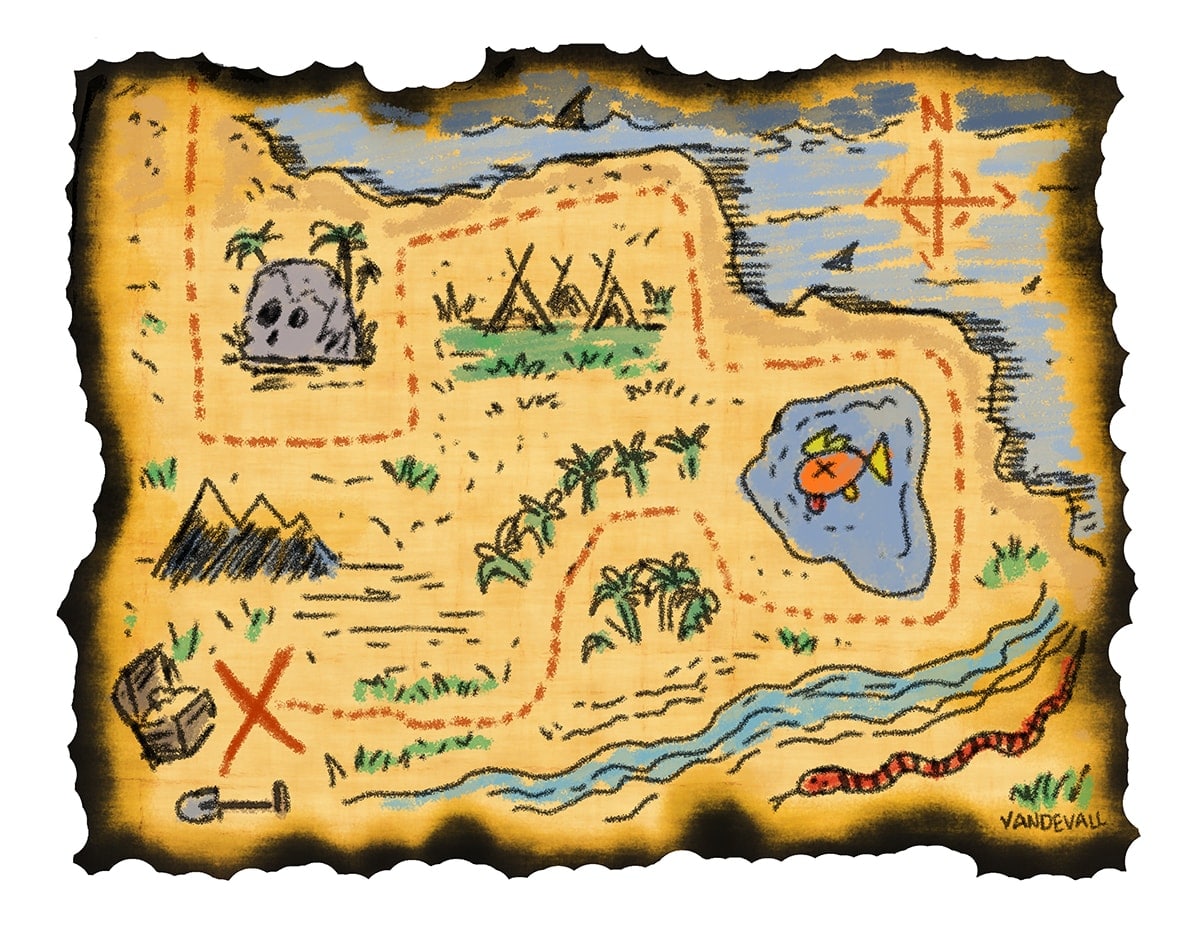
(Treasure map illustration by Tim Vandevall)
The unfortunate thing about the treasure map to success is that sometimes you get shipwrecked. Sometimes you get stranded. Sometimes your only friend is a volleyball. No one can predict when you’ll get marooned on a deserted island (read: when you will have a mistake or failure). But it will happen. It happens to everyone at some point or another.
Just like testing all your assumptions, if you accept the fact that success looks like a treasure map, you’re going in the right direction. You will veer off path. You will hit roadblocks. You will have challenging moments when you question the entire journey altogether, but the journey wouldn’t be worth it if you didn’t.
As I mentioned, there’s no framework for getting better at testing your own assumptions. All you can do is make the decision to start testing all your assumptions (and the assumptions of society, your friends, your family, etc.) all of the time.
I don’t assume anything will work a second time around. I don’t assume that just because I read something in a book that it will work for me. I don’t assume that because someone else does something a certain way that’s how I need to do it.
I test those things. One by one. Assumption by assumption.
Here’s one question that always helps me when I’m on the dotted line of my treasure map and being met with an assumption:
“Have I dealt with this exact issue before with the same exact circumstances?”
Almost always, the answer is “No.” It’s nearly impossible for the answer to be “Yes.” And because the answer is “No” you have to test your assumptions. Sometimes, it feels like you’re re-testing assumptions you’ve already re-tested in a re-test of assumption re-testing before. Well, welcome to life and business. It’s not a straight line. It gets pretty damn windy, and you’d better hold on for the ride.
My wife, Caroline, and I have some of our most emotionally charged discussions when testing assumptions. We typically use the three whys:
“Why does it have to be done this way?”
“Why do we have to run our relationship the same way as other people?”
“Why do we ever have to do anything the same as anyone else, ever??”
That last one is a troublemaker, and admittedly, must be obnoxious to deal with (Sorry, Carol, love you!).
That’s not because of a certain amount of dollars in my bank account, and it’s definitely not because of a number of friends I’ve amassed on a social media site.
The point here is that I’ve “made it” because I’m willing to question everything (and I have the ability to do so). I am in control of my outcomes and I’ve earned every bit of success I’ve achieved. I could lose everything in an instant, and I’d be okay, because I know what it’s taken me to get where I am today. A place (or some version of it) I could get to again, knowing I’ll have to follow a pretty damn windy treasure map to get there.
If I’m being honest with myself, I’ve put off important tasks too many times. The main reason is that the important tasks are often the difficult ones. And even worse than being difficult, these tasks don’t provide any immediate gratification or rewards when completed. The finish lines seem too far away.
The path to success in life and business looks a lot like climbing a mountain. You can see where you want to go (minus a few hidden detours, obviously). There’s a clearly defined direction, but if you don’t put one foot in front of the other and invest the effort it takes, the top of the mountain isn’t going to move closer to you.
Too many entrepreneurs and business owners want some magical moving sidewalk that whisks them to the top of the mountain. I’m here to break the bad news to you: You only get to ride magical moving sidewalks in airports behind people who clearly don’t know to stand on the right.
You have to sell and promote your product or service. Money trees, alas, do not exist. Passive income is insanely hard to get. Following a blueprint, cheat sheet, or plan created by someone successful may get you only one step or two up your mountain (because, remember, everyone’s mountain of success is different).
Great. You have to sit in the chair and type every word on every page. You could hire a ghostwriter to write the book for you. But that’s really just like having a sherpa who carries all your REI gear. You still have to move your own feet up the mountain.
Guess what, the savings you want to build up and all the planning you have to do won’t happen out of thin air. You have to put in the extra time outside the 9-5 hours to have a shot at going out on your own. (Related article ahoy)
Just buying an online course about building your list isn’t going to do the work for you. All the fancy mountain-climbing gear in the world STILL doesn’t put your feet in front of each other on the journey to the top of the mountain.
I could go on and on. The point is, you have to make the time to have success or achieve a big goal.
You’d be shocked at how much time you can get back if you completely stopped doing these things for a few weeks:
I’m not saying you have to remove every enjoyable thing from your life to have success and make your way up the mountain. However, the bad habits that soak up all your free hours are the exact things that are making your climb up the mountain that much more difficult.
If you’re being honest with yourself, do you actually want whatever dream or goal you’re chasing? Because if really want it, you’re willing to make sacrifices for it.
If making time hasn’t happened naturally for you already, that should tell you something.
You may have gotten yourself into a routine of wasting time without even realizing you’re doing it. Check that list above one more time and be real with yourself this time. How many of those things do you do every day, while simultaneously telling yourself there’s no time to work on your business?
If the desire to work on your goals isn’t ever present in your life, it may be that the goals you have (make a million dollars, be on the cover of Entrepreneur, whatever) don’t line up with the actual lifestyle you want to live. And that’s okay, as long as you own it and make a move toward goals that actually DO line up with your values. Here’s how to find out what those are.
The internet has this nasty habit of making us think we need to know more, more, more before we ever get started. We read list after list of What Successful Entrepreneurs Do without ever actually doing any of it. Do you know what successful entrepreneurs do? They shut off those lists and get to work.
For some of us, achieving our goals is even scarier than NOT achieving them. Success would mean acknowledging for yourself that you actually are capable of achieving what you want, and that opens some pretty broad opportunities in terms of what ELSE you can accomplish. You may not even know if you’re afraid of success until it looks you in the face and you willfully turn it down.
Finding success requires surrounding yourself with people who understand and support your goals in whatever ways they can. Do you have these people in your life, or are all your friends and connections living in a different world and opposing your dreams? It’s hard to shut out your friends to make time for your business, I get that. But you’re shutting out yourself if you spend all your time with people who can’t help you get where you want to be in life.
Will you make the time it requires to climb the mountain of success? And will you enjoy the climb along the way?
Are you ready to accomplish something that takes normal people years, but you’ll be able to do it in just 7 easy steps?
Have you been dreaming of getting the perfect blueprint for the success you’ve always been dreaming of?
Well I want to give you all those things, and all it takes is clicking the download button.
This offer will expire in some amount of days from whenever you read this.
There is a 30-day money back guarantee backed by logos of obscure “security” companies or random credit card logos I found on Google Images.
The replay of you reading this will expire 24 hours from now!

Are you concerned that you may not have the skills required to utilize this amazing offer? What if I told you that I never had the skills required and that by following my own cheat sheet I was able to accomplish exactly what we’ve both been thinking about this entire time? Did I write the cheat sheet after or before I used it? NO ONE KNOWS! Mind-blowing, right?
You’re ready to download the cheat sheet aren’t you?
You can’t wait to click a button that might/will/probably/won’t/should/doesn’t/does/absolutely/must/potentially change your life forever?
You want to keep scrolling, but you can’t stop reading because this offer is so great and you’re so great and I’m so great and isn’t it just great how wonderful life is when you can have free downloadable cheat sheets and blueprints?
I don’t normally do this, but I decided you get some fast-action bonuses!
Bonus #1 – You get a crappy e-book I wrote 4 years ago that never sold and that no one ever wanted. Here’s a photo of it as a real book, because that makes total sense…
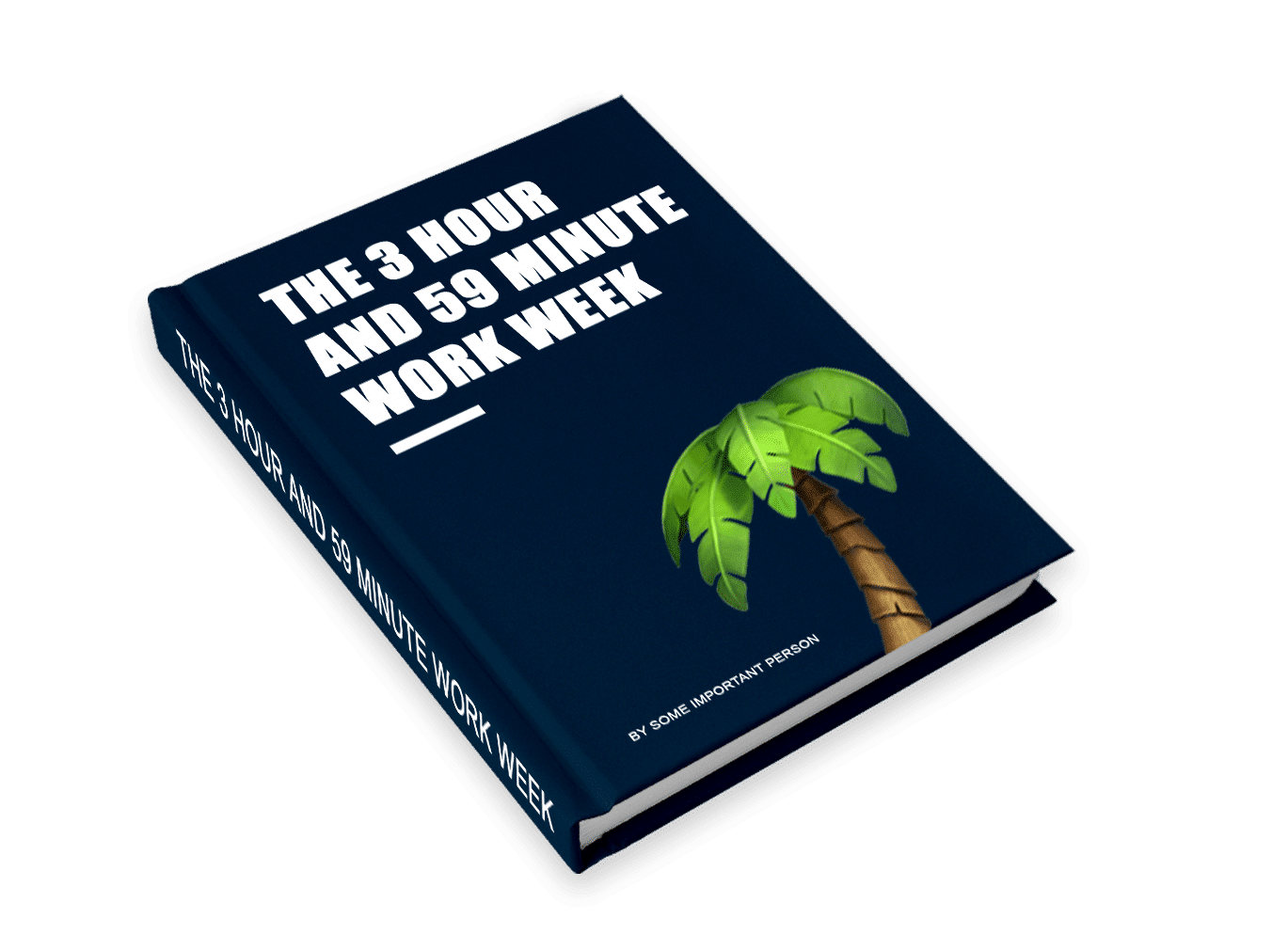
Bonus #2 – I’ll put you in my 29-day email funnel, where you’ll get 5 action-packed emails per day, all formatted terribly, with a very difficult to find unsubscribe link (spoiler alert: some emails won’t even have an unsubscribe link!!!!)
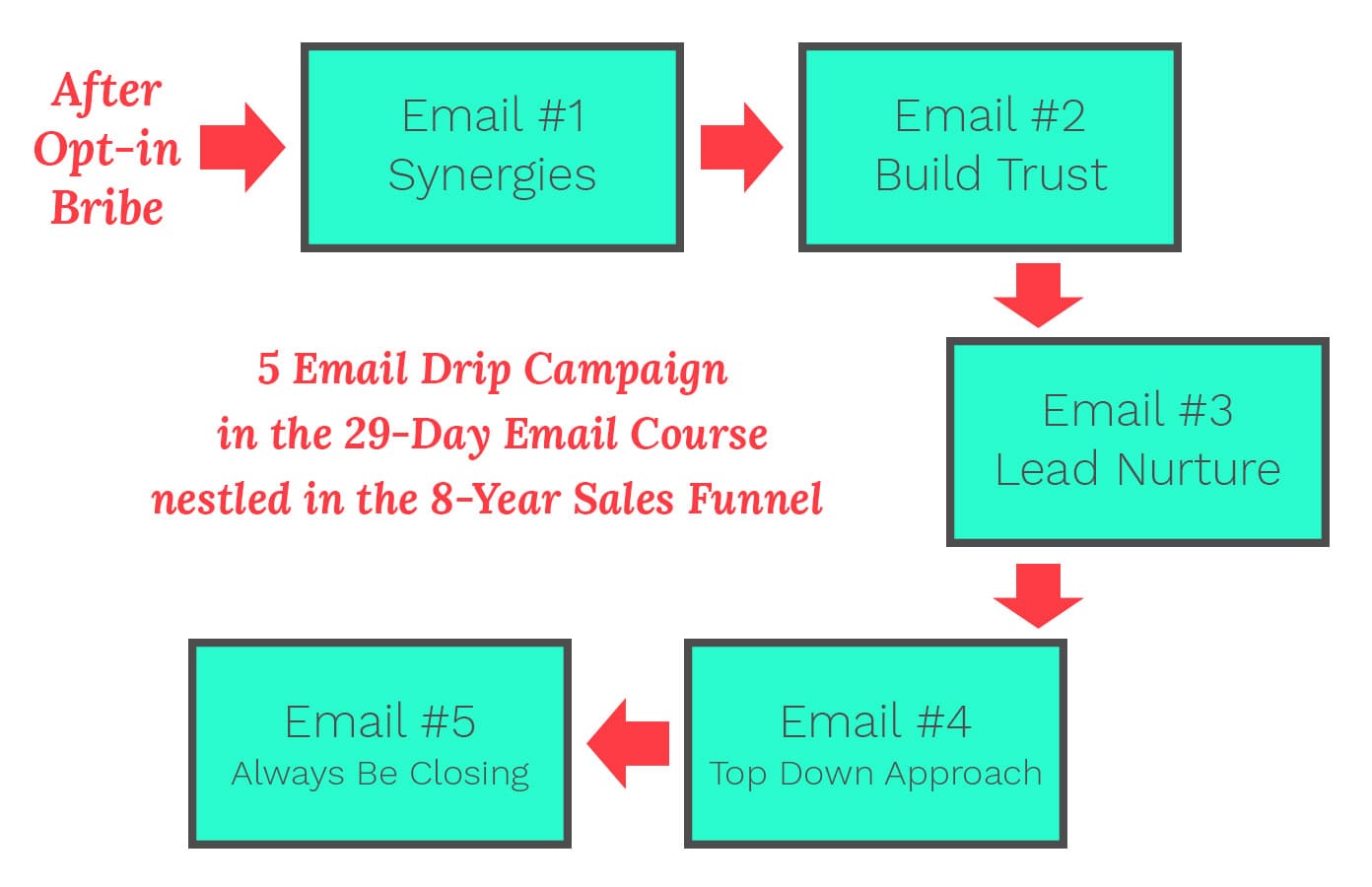
Bonus #3 – I talked some random social media expert/guru/sherpa/ninja into contributing one of their products to this as well (second spoiler alert: no one has ever read or used this product because it’s not any good)

Bonuses #4-7 – These will be testimonials I make up from fictional people who talk about how awesome I am (who can verify any of it, anyway??)
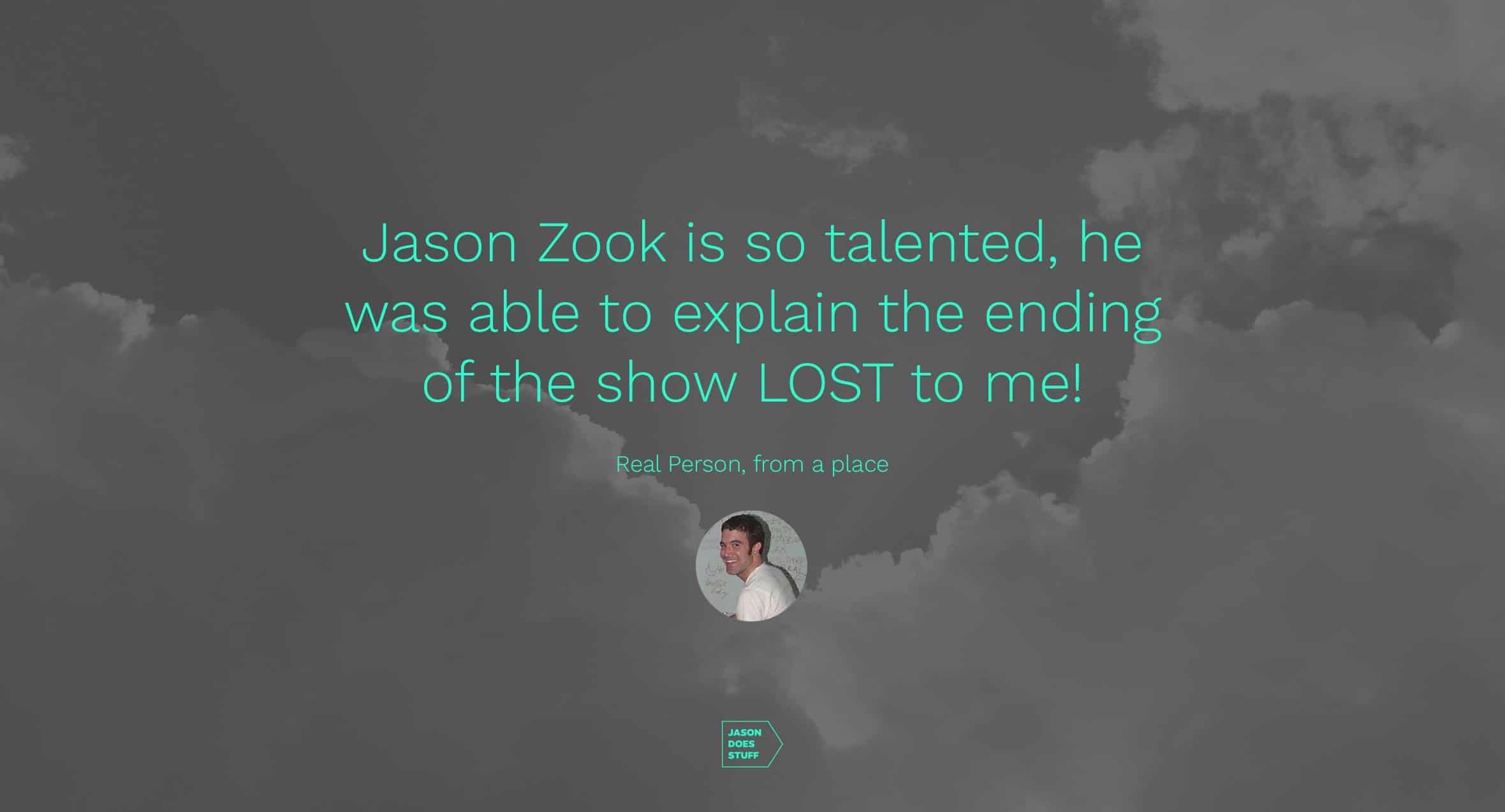
Bonus #8 – A downloadable certificate of achievement with your name on it! (It’s actually a clip art template in Powerpoint that I just type your name in and save as a BMP file.)
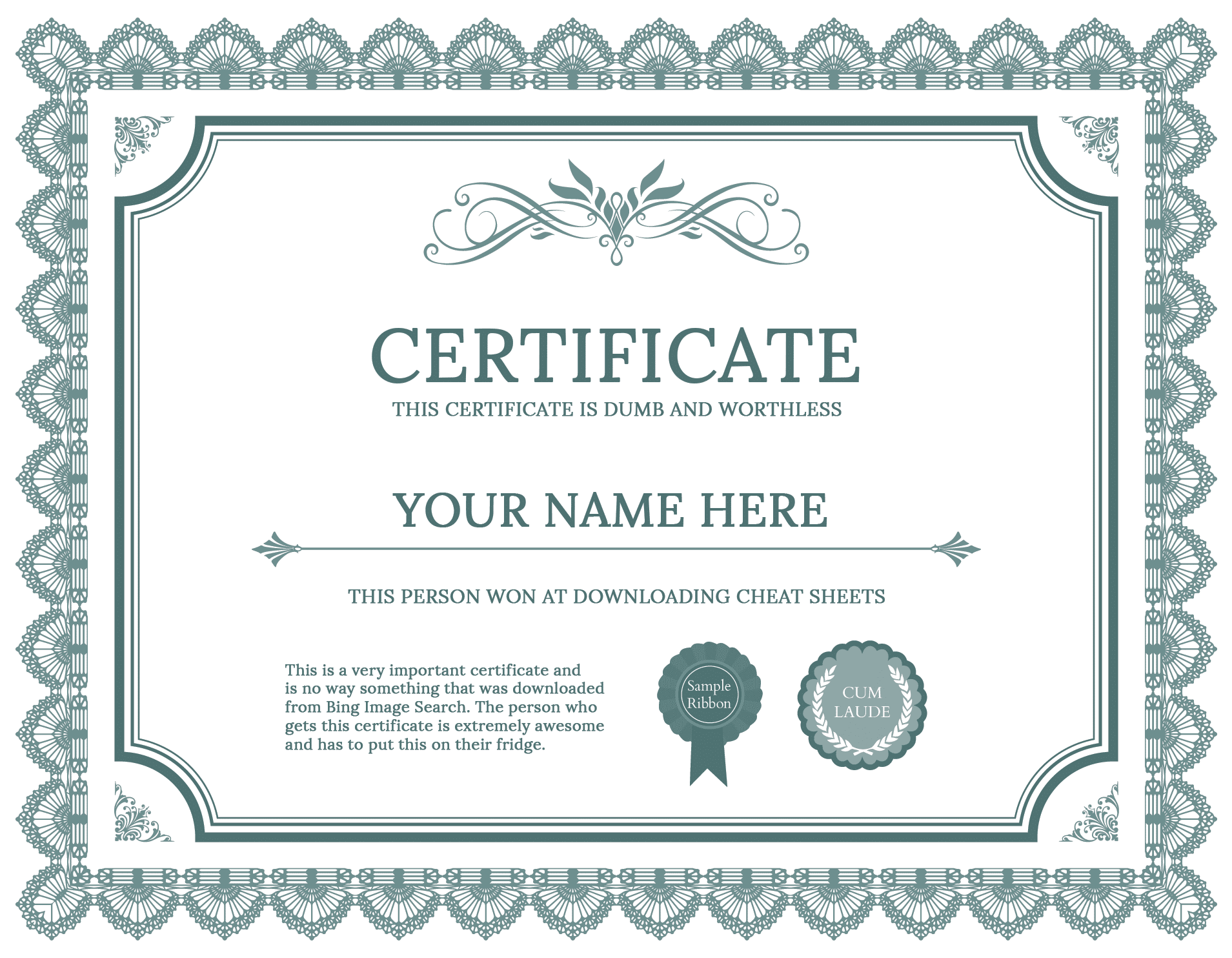
You’re drooling all over your keyboard and desk?
Well, I have bad news.
There’s no actual cheat sheet.
There’s no blueprint.
The are no optional Russian Brides and Husbands.
I wrote this because I’m tired of seeing lots of free downloadable cheat sheets on the front pages of people’s websites. Sure, I dabbled in the cheat sheet game once upon a time. But then I moved on. Then I realized I wanted people to buy my products or sign up for my email list because they actually wanted to, not under the guise of hacking some system (which never actually works) or whatever.
So yeah, if you want real content, delivered to your inbox, you can join our weekly newsletter.
There are no cheat sheets to get our newsletter. No freebies. Nothing you can download to make your life better in just 12 easy steps.
Less cheat sheets. More thoughtful content that helps you figure out how to do things in a way that matters to you and doesn’t feel like cheating.
Getting more things done is simply about taking action. And many people don’t. You’re reading this article because you want to be among those who do.
I wasn’t always an action taker. I didn’t always have washboard action muscles that you could do your laundry on. Actually, when my journey as an entrepreneur started, I spent the majority of my days surfing the Internet in my sweatpants. That’s not just a made-up story you hear about all entrepreneurs. It was absolutely true for me. Very quickly I’d have unanswered emails, calls, and impending deadlines that always felt stressful. For the majority of my life, I’d been a person who finished things last minute.
But when I started my first business, IWearYourShirt, it was evident very quickly that I had a ton that I needed to do. The premise of the business was to wear a different shirt every day of the year, and on each day I would:
I had never even attempted 99% of the things that I was going to have to do on a daily basis.
A few days before starting that business in December 2008, I remember thinking, How in the world will I possibly get all these things done? What have I gotten myself into?
Ultimately, I rewired my brain by learning how to take rapid action. There was no other option. The best part is that it didn’t just help me with that business—it’s now how I approach every single thing I do.
When people started to consistently ask me, “How do you get all these things done?” I realized that they didn’t even think it was possible to do so much. They didn’t realize their action muscle existed. They didn’t realize they could train it.
But it can be done. I’m proof.
Ultimately, it’s about putting in the work. And 100% committing to it.
Everyone wants a silver bullet to make all their problems go away. Everyone wants to just read the next article, the next listicle, the next blog post, the next thing in their Twitter feed, all the “best of” stories of success. And it’s so easy to just say, “OK, I’ll read an article,” but how many of those articles have you read at this point? Enough to fill at least a book.
The reason you keep clicking on those articles is because you haven’t found the answer yet. Here are the action muscle-building things that work for me and that I believe can work for you:
I started doing this in 2009 and have been doing it ever since. Every week, my Google Calendar gets filled with blocks of time for specific tasks. Usually the Friday before, I start mapping out the next week with time blocks. As the week begins, I can adjust accordingly. The key with time blocking is to make sure you’re only doing THAT specific task during that time. Shut down all other browser tabs, apps, anything that can distract you with notifications.
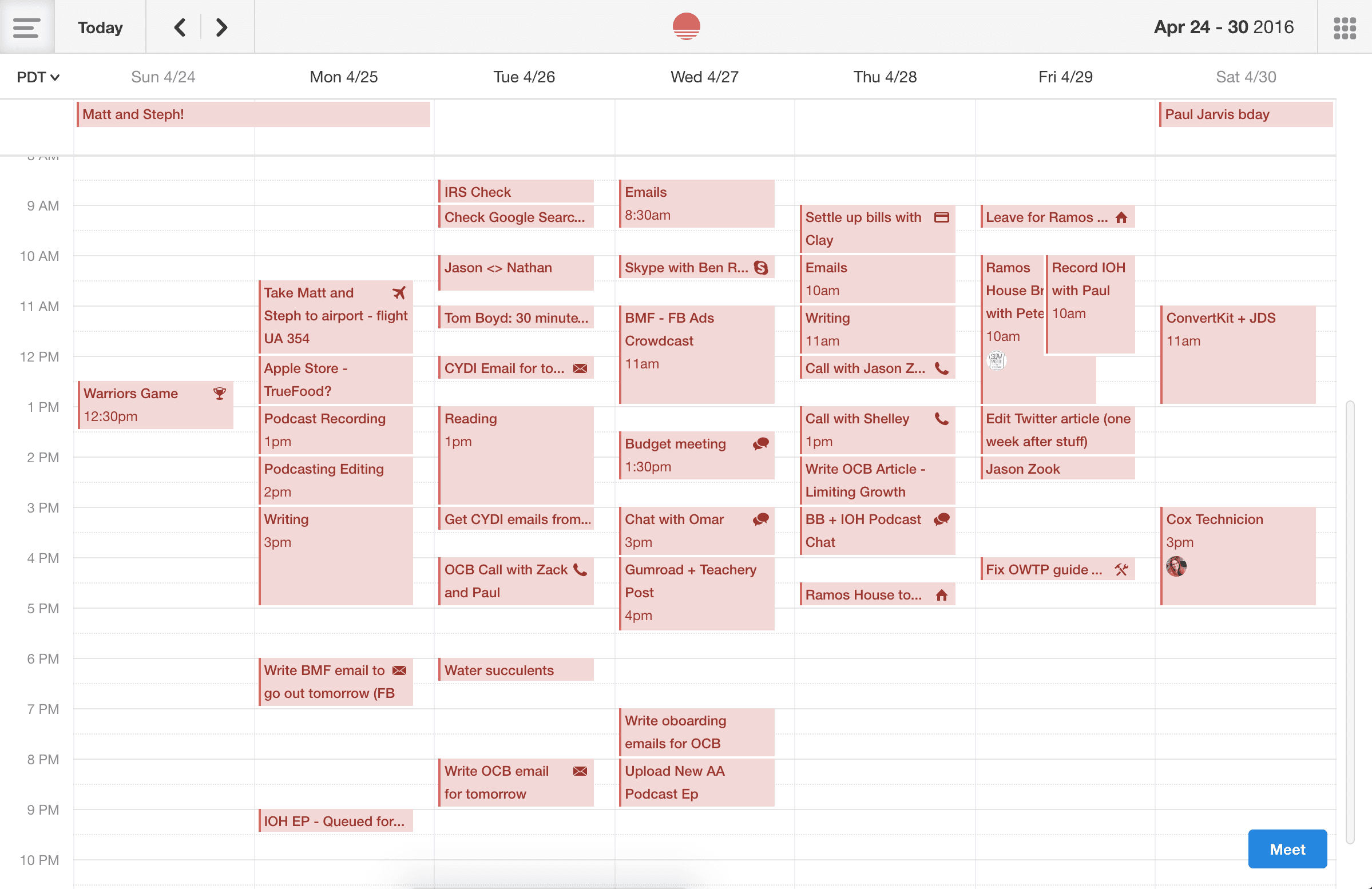
(I used to use the Sunrise Calendar. RIP, Sunrise.)
There are folks out there, even other Jasons, who will make the argument that an unscheduled calendar is the way to go. I don’t believe that one way of doing things is right for everyone. All I know is that blocking off time on my calendar keeps me laser focused and highly motivated.
I don’t see a full calendar as stressful. I see it as organized and pointing me in the direction of maximum output. Not every week is filled to the brim, of course. I just wanted to show you a fuller week (above) to give you an idea of what things look like when times get busy. In fact, here’s my upcoming week (as of writing this article):
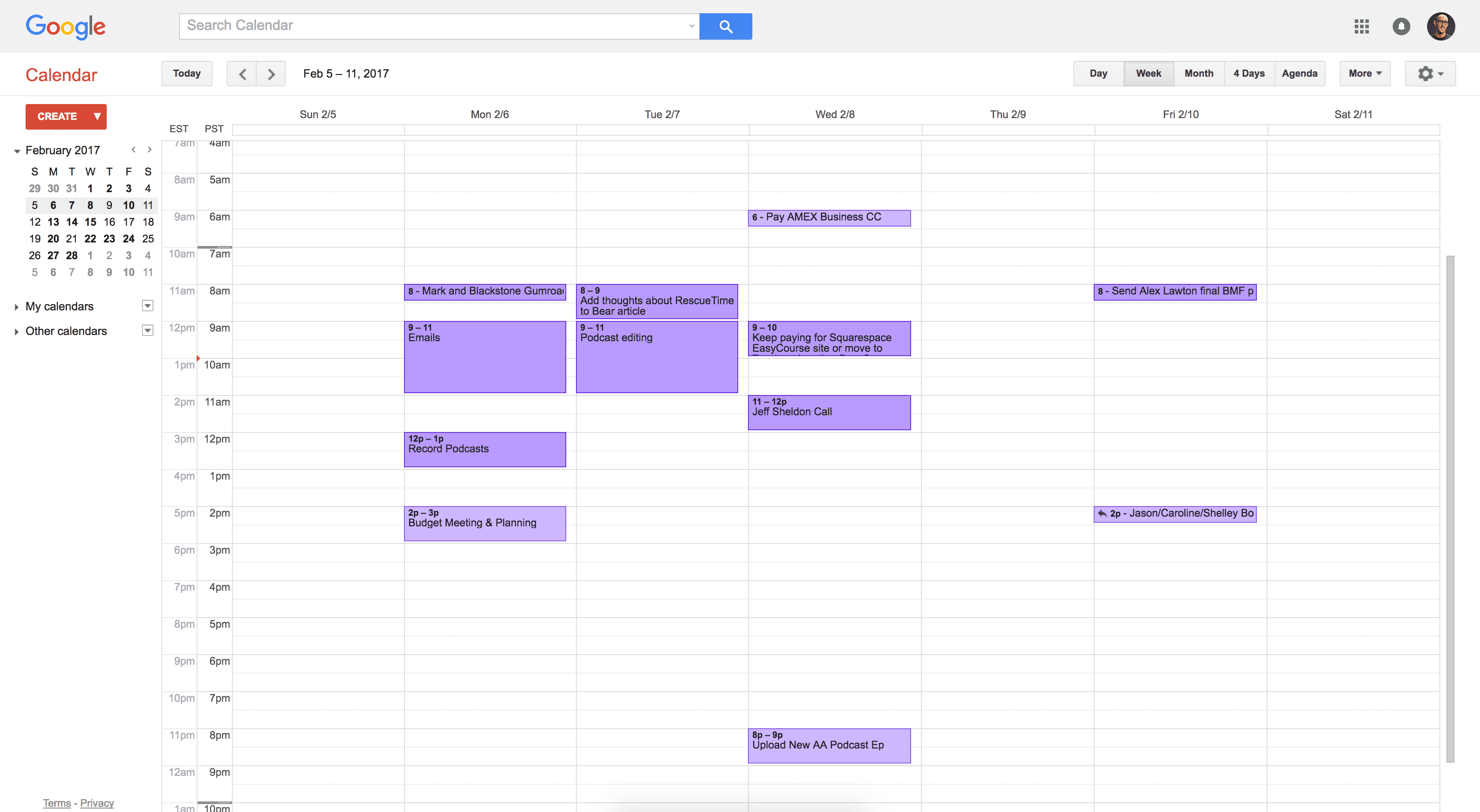
(have to use Google Cal now, sad face.)
Every six months, I spend $2.19 on an 8.5×11 notebook at Target (here’s a similar one on Amazon for $1.09!). It’s almost identical to the notebooks I used to buy during my back-to-school days. A simple lined notebook (college rule, obviously!) takes all the distracting frills away from writing down to-do items. I write out each project heading and then all of the small tasks I can think of associated with that project. There’s something really profound about physically crossing off a task on paper with a Sharpie. Pro-tip: I like to leave the notebook open so I can see my list of projects and tasks all day long, every day.
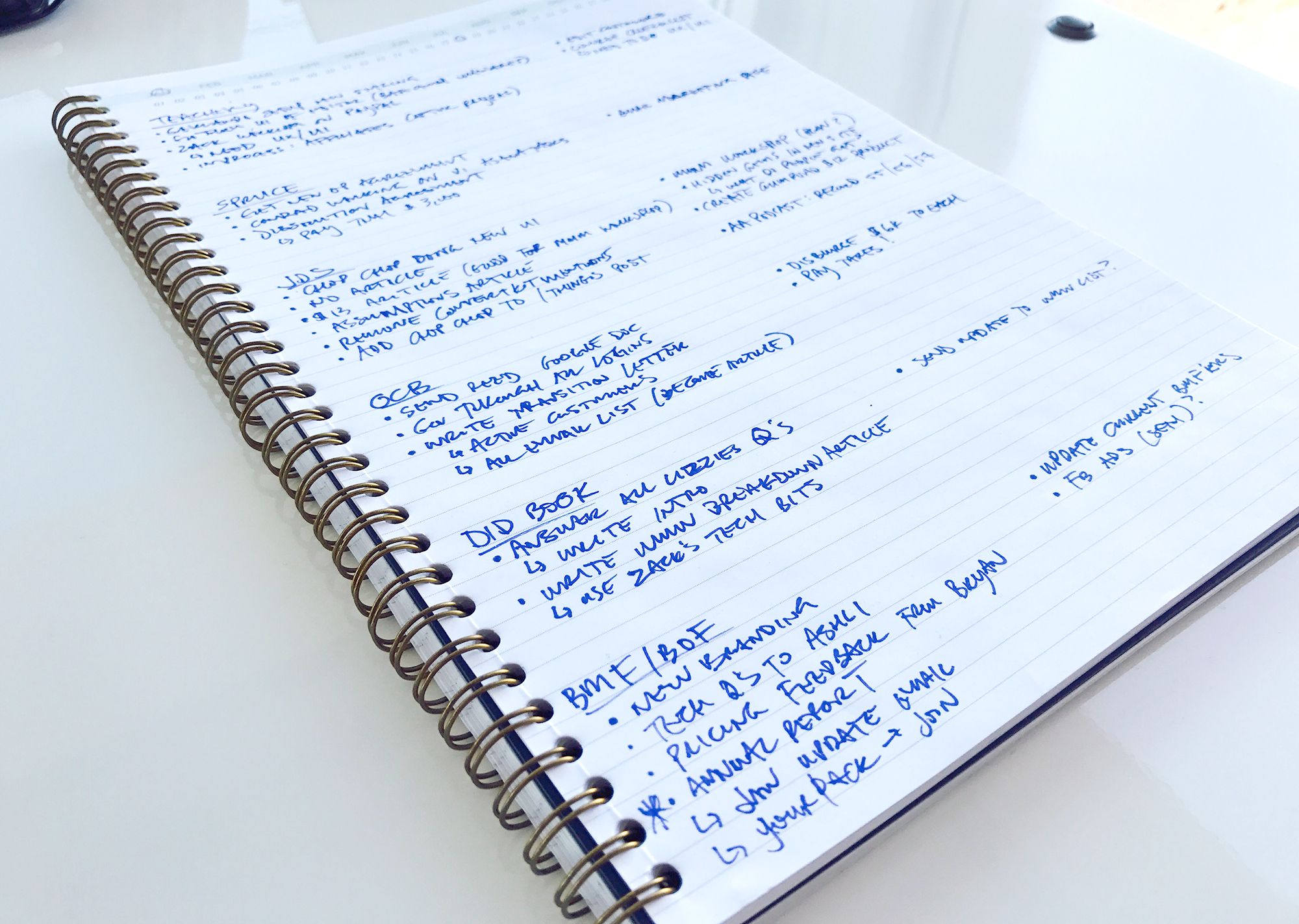
This is super important when you’re first sculpting that action muscle. Your accountability partner can be a friend, a spouse, or a random person you find on Tinder. I mean Twitter. Yeah, probably Twitter.
Make this easy for the both of you, and simply set up a weekly Skype call or in-person meeting where you can reflect on your time-blocked tasks and your written to-do list. How did you do? Where did you slip up? It’s important to admit where you fell short so you can improve in the future. Having someone else help you stay accountable to your tasks will keep you honest and keep you motivated.
Accountability calls or meetings may vary in length, but try scheduling less time than you need to stay more focused on the call (save the chit-chat for drinks or coffee!).
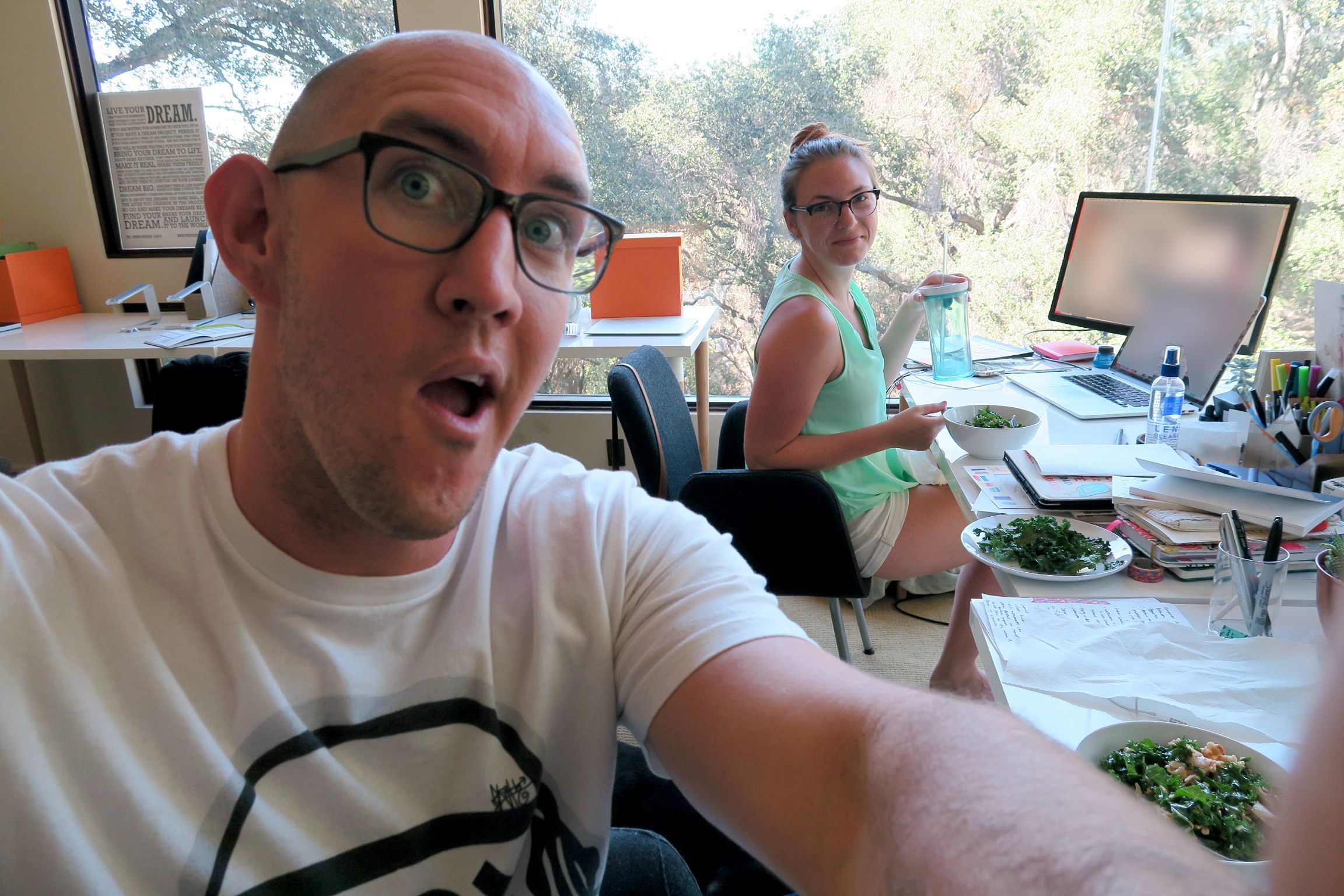
(My accountability partner is also my life partner, and my kale salad partner)
Okay, I originally was just going to leave this as a joke, but it’s kind of true. Your action muscle, like the muscles in your body, is only going to get more chiseled and shapely if you take care of your health. If you’re constantly eating crappy food, your body (and mind!) won’t have the fuel to function properly. You don’t have to eat kale salads, but you should absolutely avoid foods that cause you to crash or run low on energy. Getting a bit of exercise and fresh air can work wonders to boost your motivation.
Yes, I am particularly well-versed at the art of GTD (getting things done), but even I rarely get ALL my to-dos and tasks done. Why? Because life sometimes take a crap on your face when you least expect it. Because as much as I want to tell you that you can get every task done all of the time, you’re going to experience moments of resistance (some of us just experience less than others from years of action-muscle sculpting). But do I beat myself up about not getting all my tasks and to-dos done? Not at all. Not ever, actually. I cross off what I can, I reschedule what I have to, I take responsibility for why things didn’t get done, and I keep moving forward. Taking action isn’t some game to be won. It’s a process, one that all of us have to keep working at.
The biggest thing I’ve learned about the benefit of taking action is that it isn’t just about getting a ton of stuff done. The real benefit is opening yourself up to unintended consequences. It’s about putting the kind of stuff out there that other people would think is scary. It means not letting things stay in your head anymore.
Since I’ve embraced a bias toward action, so many things have fallen into my lap that I couldn’t have possibly dreamt of. I made $1,000,000 wearing t-shirts. I made $100,000 selling my last name. And I made over $300,000 selling my future.
Our society is so obsessed with successful people, but many don’t appreciate that success is never overnight: it’s consistent effort and consistent action. You have to put in the work to get to that level of success.
When you make taking action your lifestyle, when you’ve built that muscle, there’s no pressure anymore. There’s no pressure of having to worry so much about this client or this gig because things will keep happening. The expression “the rich get richer” is true because the people who are out there making stuff happen are opening themselves up to so many more opportunities.
The steps I’ve outlined for you in this article may work wonders for you, but you won’t know until you actually put them into practice. There’s no better time to start than right now. No matter what day of the week it is or what month of the year, start right now and work on your action muscle.
When the authors behind Surge: Your Guide to Put Any Idea into Action reached out and asked me to write the foreword for their book, I had to make sure they were viewing action-taking in a way that resonated with me. After reading an early draft of the book, I couldn’t have been more excited to enthusiastically endorse it. My exact response to them after reading the book was something to the effect of, “I don’t have to write the book on how to take action. You guys have already done it.”
I encourage you to pick up a copy of Surge: Your Guide to Put Any Idea into Action. They dive much deeper into the topic and give you a blueprint to hone your action muscle.
So here’s yet another permission slip to start your journey to becoming an “action” person. Will you take it?
It’s easy to let a shiny new idea or opportunity derail our progress. It’s human nature to let ourselves get pulled away from doing the actual work of getting where we want to go.
Since 2013, I’ve launched a big ole handful of new projects. From branding workshops to books, and from software products to selling my own future, I’ve tried to put things out into the world that help people and that align with my values. I consult those two priorities every time I’m considering a new idea.
There was, specifically, one project I launched recently that I just wasn’t sure about. It wasn’t super unique, and it wasn’t super sexy. I had some doubts about it because of that, but I had committed, so I stuck with it. I kind of felt like the project was taking me off the path I had created for myself and my business.
So what was this project that caused me inner turmoil? EasyCourse: a course to help people build online courses.
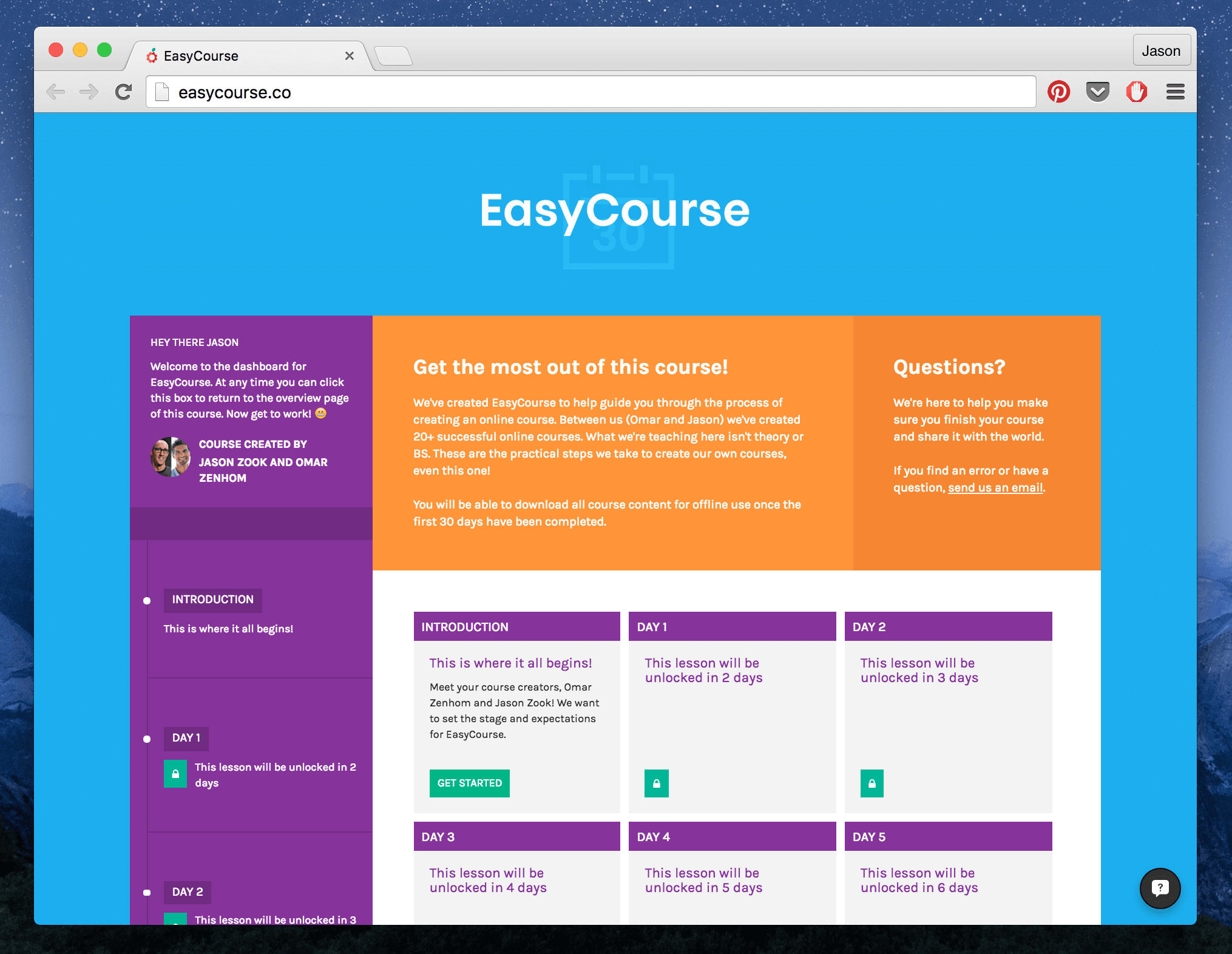
Well, my compass often points me in the direction of helping people take action with their businesses. Online courses are a big industry right now ($20+ billion big). I co-own an online course platform, and I’ve witnessed people in my entrepreneurial bubble creating courses that help other folks do what they’ve done (make and sell courses). But what I hadn’t seen was a very practical application of this how-to course. I thought people deserved a step-by-step process: do this on Day 1, Day 2, Day 3, etc.
In customary fashion, I partnered with a friend (Omar Zenhom), who also had experience creating online courses. We’re both silly guys, and we enjoy teaching. We make a lot of dumb jokes when we’re together, and we thought we could inject our humor and knowledge into a project. And, we both often have people asking us how to build courses of their own.
Oh, one other thing to mention: every project I’m working on these days needs to be considered for our Wandering Aimfully Members. When I shared the idea for this new project with the existing buyers, as something they would get without paying a single extra dollar for, a ton of them jumped for joy (literally, I think, based on the emojis they used).
Suffice to say, there were lots of factors that indicated I was following my compass.
During our first launch, EasyCourse made good money. Despite my reservations about it, it was a course that people were looking for (and that stood out from the others). Even better than the money the course made, though, was that it made a bunch of people really happy and solved a problem for them:

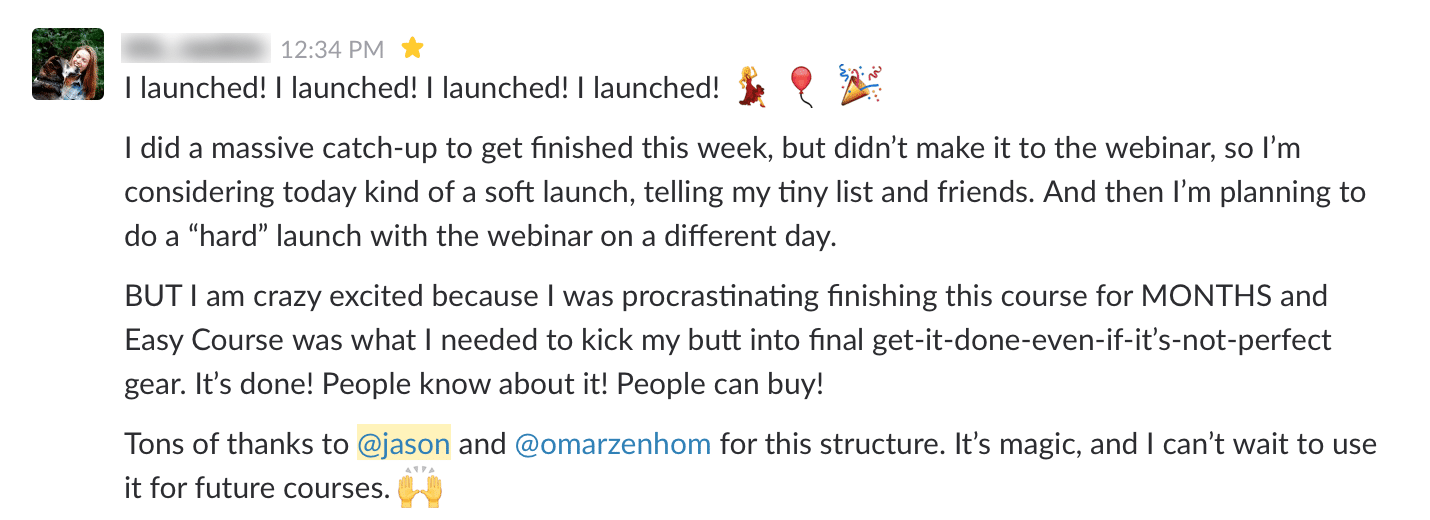


If a project makes money and makes people happy, shouldn’t you just suck it up, put the compass in your pocket, and deal with the slightly uncomfortable feelings in your gut?
You can, and it might be tempting to do so. But at some point, your inner turmoil will win out over the positive feelings that come with money and praise. And more importantly, if the audience for the product or service you are selling is not an audience you are extremely excited to support, it can be very difficult to convince yourself to continue working on the project.
For me, the big lesson learned was: working with beginner-level folks is not for me.
I’m very appreciative of the first group of folks who bought EasyCourse; however, it became abundantly clear to me that we’d built a product for a beginner-level audience, an audience that I hadn’t built something for previously.
Every time someone asked a question about a very simple problem or issue, I could feel my inner turmoil bubbling up like a dormant volcano getting ready to erupt. I mean absolutely no offense to the folks who bought EasyCourse, but it became extremely clear to me that I am not interested in holding someone’s hand through every step of a process. This was a path I hadn’t really gone down before in business. I can’t remember ever defining if I only wanted to work with beginners or more experienced people, but this was the first project that was purposely planned for beginners. That plan, I now realize, is not a plan I want to use for any project moving forward (which is a good lesson to learn, but learning good lessons can kind of suck).
As much as I wanted to create something different (a practical, step-by-step course), I was not prepared to support the type of person who was going to need 10x the step-by-stepping I had envisioned.
I don’t want this to sound like doom and gloom, though. What we built with EasyCourse was incredibly helpful for a group of people. The process of creating it was mostly fun work (especially with my buddy Omar bringing the laughs, and our significant others adding their awesome expertise to the project as well).
Aside from the revenue and helping some folks break through and achieve a goal of their own, I’m very appreciative that I learned a solid lesson in the process: Working with beginners is not for me. If an opportunity like that comes up again, I’ll know to check in with my compass and get back on the right path.
There may be more beginners out there waiting to purchase beginner-level content and projects, but I’d rather focus on creating things for folks who have already gotten started. This very well could be leaving money on the table, because it’s no secret that it can be easier to sell to someone when you’re selling them the dream of what could be. But I’m not a dream salesman. I’m a practical-application-of-lessons-I’ve-learned salesman. And the lessons I’ve learned and can teach will better help someone who’s had experience and is willing to put in the work, knowing not every step in the process is going to be handed to them.
Sometimes, it’s better to know what you don’t want to do, so you can make room for things you do want to do.
EasyCourse was not a failure by any means, but it was a reality check. I’m guessing you’ve had projects or opportunities that sound similar to this story. Heck, you might even be a little lost in the woods right now as you head down paths you aren’t sure you want to be going down.
Now’s the time to check your compass.
Now’s the time to listen to your gut and move on from a project you suspect isn’t right for you.
Grab hold of your life, find your true north, and stay on the path. Pro tip: it’s probably not the paved one.
Some statistics say 9/10 new business owners fail within their first year. Others say it’s 75% failure within the first 6 months. A newer study says 50% of businesses make it five years. I used to believe that it was a culmination of factors that contributed to those failure numbers, but I believe it’s actually one simple thing:
People don’t succeed in business because they simply don’t show up.
Don’t worry, this article isn’t just a rant-fest. I’m simply setting the stage to talk about how you can avoid the mistakes I’ve been seeing recently and hopefully have your business avoid failure.
1. I had a custom wood project I wanted to get done. I reached out to, and this is not an exaggeration, 14 companies*. Not a single one of them was good at communication. The worst part? I had a sizable budget for the project (over $10,000) and wanted to give that money to someone for the work they say they do for a living. I eventually found a recommendation through a friend who showed up. The other 14, never did.
2. We joined a local gym** and were told that they do meal prep (something we’ve been subscribing to for a year now). I shared the exact amount of meals we were paying for, how much we were paying, and that we’d love to move to a local company (them!) Over the course of a month, I followed up 3 times, and finally gave up. That same gym was always empty, always trying to run specials/deals to attract customers, the owner was never there, and can you guess what happened? Two months later their doors were closed.
3. Trying to find a good UI designer. This one starts all the way back in 2013, when I decided to create my first online course. I scoured the web for a simple and affordable platform to make that process easy. To my surprise, there weren’t too many options. So I did what any entrepreneur does: I figured out a way to solve my own problem. Using my mediocre design skills, I whipped up a layout for a course design and paid a developer to shoehorn it into a WordPress theme that would accept payments. A couple hours of work and $2,000 later, I had a completely functioning online course that worked exactly as I wanted.
I showed it to a few friends, who loved my cobbled-together solution so much they wanted to know how they could get their hands on one to build their own courses. Problem was, they couldn’t. Since I’d just made it up for myself, it didn’t exist for sale.
Lightbulb moment!
Fast forward a year, and I found myself at a conference in Fargo, ND, talking with a developer (hello, Gerlando!) who was looking for a side project. Did I know of any opportunities? I did, in fact! Without giving you all the boring details, we partnered up to transform my cobbled solution into an independent platform, and Teachery was born a few months later. A beautiful bouncing baby of an online course platform!
Well, I did the majority of the initial design work for Teachery (alongside my wife, Caroline, who did the awesome branding and initial sales page). That first course design work is from 2014, so it’s been an eternity (in internet years) since we first put it together. As Teachery has grown in popularity (and monthly recurring revenue), we’ve been putting our pennies aside to pay someone to give our course platform a facelift, eyebrow tuck, and maybe a little nose job. You know, freshen up Teachery to a more modern design.
I contacted UI designers from multiple places: Dribbble, DesignerNews, and directly emailing designers that had emailed me in the past (yay Gmail labels!) All I wanted to do was put money in their bank account to do a few hours of the thing they like to get paid for (or so say their bios).
I reached out to six designers*** and besides the beautiful portfolios, all six designers had one thing in common: they didn’t show up.
One designer wrote back to my initial outreach within 24 hours. Awesome! I love quick communication, although it’s not a must as I embrace the need for work-life balance. We set up a Skype call a few days after the initial email reply. Can you see where this is going? I logged in to Skype 30 minutes early because if you’re not early, you’re late (thanks, high school basketball coach!). I sent the designer a message that I was ready whenever he was, but no rush as I knew I was early. 15 minutes passed. I could see a green icon next to his name saying he was online. 35 minutes passed. He was now late (and, per my high school coach, should be running extra laps). I sent a friendly nudge of a message: “You still good to chat?” No reply. I waited another 15 minutes and begrudgingly signed out of Skype to fire off a friendlier email than I would have liked: “Hey man, looks like today’s call time didn’t work out? Can we reschedule?” A day later, he replied, and we set up another call. I hopped on Skype. He was online. Again, he didn’t show up at the agreed-upon time. Four hours after the scheduled call, he sent a message: “Ready to chat?” To be clear, there was no timezone scheduling error—that I made sure of early on. No, man, I’m not ready to chat, and I won’t be giving you our hard-earned money for your work.
You might think it was just that one designer, right? Well, an eerily similar thing happened in different fashions with each designer.
Four of the six, in fact. Either they stopped emailing me back after being excited to chat in the first reply, or they just didn’t even show up for the Skype calls we scheduled.
I completely understand that schedules and priorities can change, but with a lack of any communication to cancel our calls, these designers are creating a bad experience that will hurt their reputation and brand. These are the exact things that causes businesses to fail.
If you say you’re going to be on a call, be on the call when you agreed to be on it. If something comes up, be honest about what came up. Respect the other person’s time as much as you respect your own.
Don’t want to do the work? That’s fine—just communicate that with a simple two-letter word: “No.” Don’t say “Yes” and then bail because you’ve changed your mind. Give someone the respect they deserve, and be man/woman enough to say that you aren’t interested. Don’t hide behind the empty replies of email and Skype to avoid letting someone down. You actually let people down even more when you don’t extend common courtesy.
Can’t make a scheduled call? Tell the person, and show up at the rescheduled time. Can’t get the work done on time? Explain why, and be transparent with the person who’s paying you money. If you have a problem with scheduling (and sticking to deadlines/schedules), then figure out a new system for making scheduling work for you. There are 100 ways to skin a Google Calendar.
I know a lot of starving artists/entrepreneurs/writers/business owners. You know who I also know a lot of? People who don’t show up. People who don’t keep their word. People who don’t do just the basic amount of things to accomplish what they set out to do. If people spent more time showing up and delivering, they’d spend way less time having to figure out tactics and strategies to get more paying work or customers.
This isn’t rocket science, people. Showing up is your first and most recurring chance to demonstrate consistency in service and quality. If you do it, you’re already better than the majority of your competitors. If you don’t, well…people are probably writing frustrated articles about you.
Business owners aren’t failing because there is too much competition. Business owners aren’t failing because people can get the work cheaper elsewhere.
Business owners are failing because they don’t show up. They don’t communicate effectively. They don’t do the thing they set out to do.
Show up. Communicate. Do the work.
A couple footnotes:
* Here’s the breakdown of the 14 woodworker responses, just to ensure that I defend my integrity: 4 companies wrote back and said they love the idea for the project and would get me a quote (even after I followed up again a week after each positive response, I never heard back). 3 companies have not responded after multiple emails and admitted they were “slow at responding to email.” 4 companies wrote back initially, gave a generic quote, and didn’t write back when I asked for more information or next steps based on their quote. 2 companies simply never replied to my first email (and the follow-up I sent). 1 company said they weren’t the right fit for the project, which was refreshing to hear.
** I promise you I’m not making this up, the local gym we joined closed the week before posting this article. Apparently the owner was doing some really sketchy stuff behind the scenes. I saw the red flags early and I can’t say I’m too surprised (however bummed) the gym closed.
*** There is one designer who has been great at communicating and that we are in talks with for the Teachery UI work. I wanted to make sure to share this and will continue to update this note as that relationship progresses.
